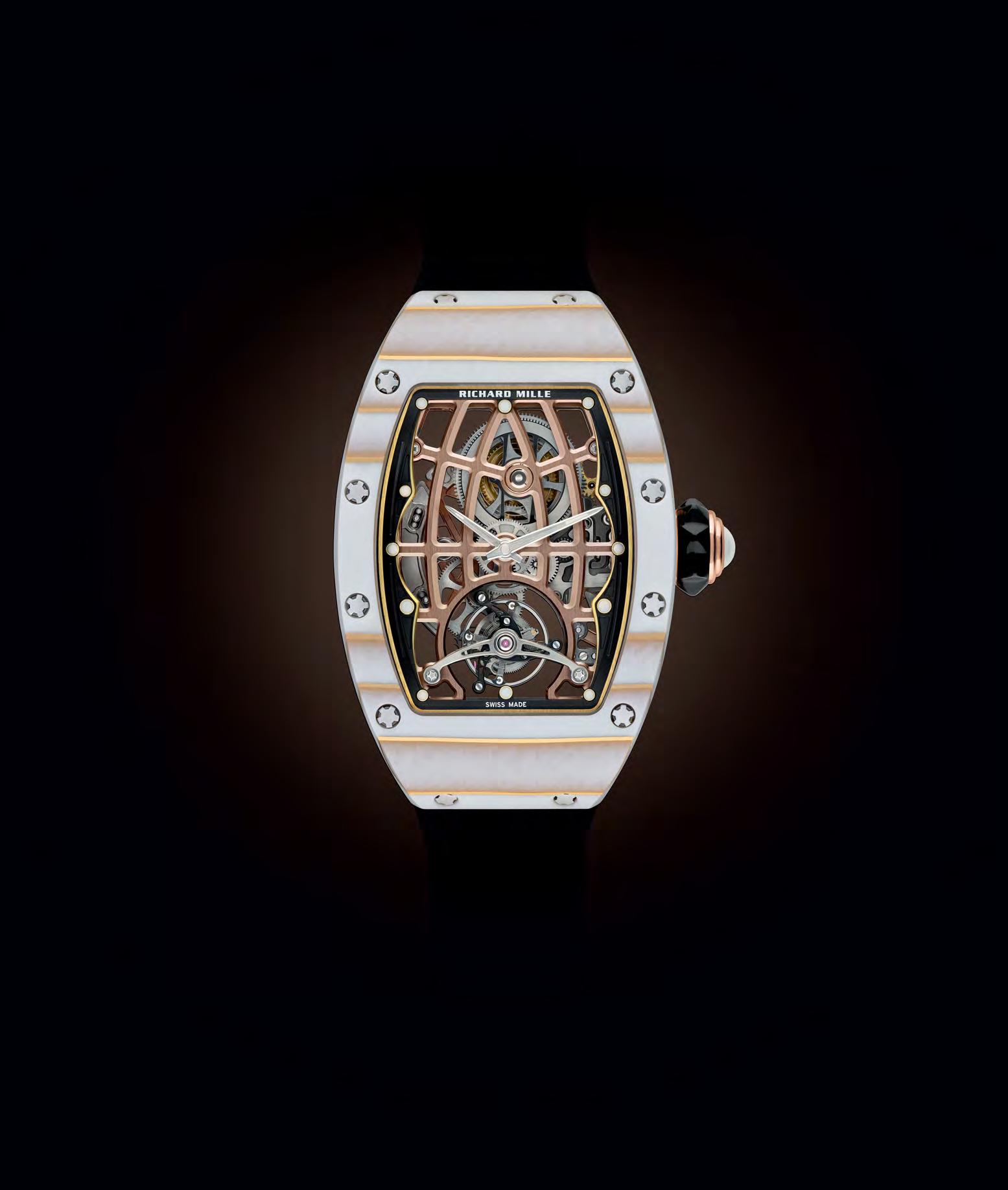
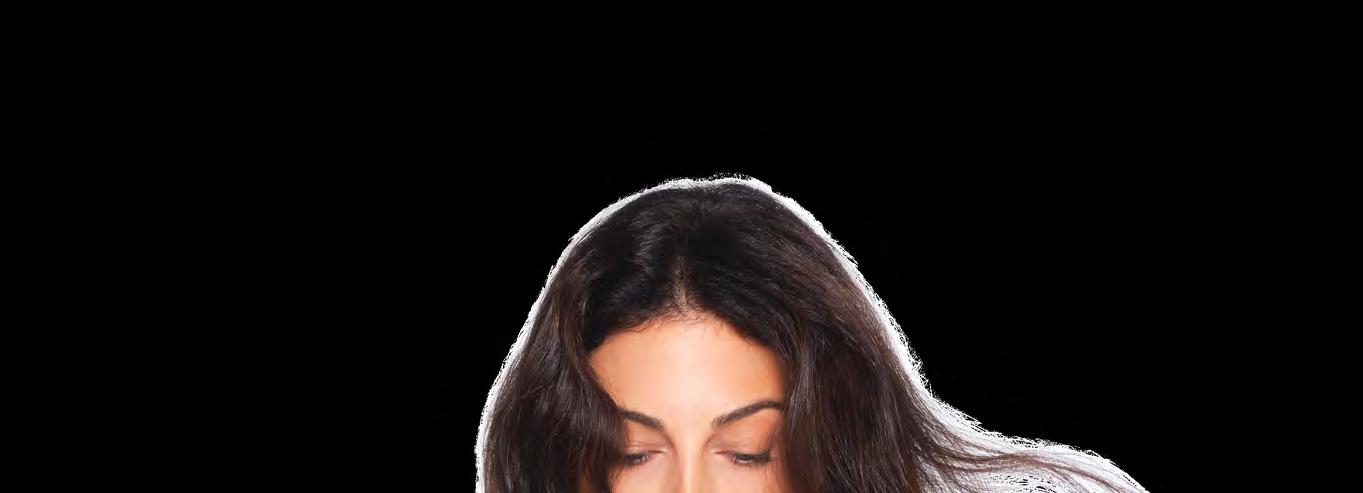
























































































































Fall signals transitions: a shift in pace, in rhythm, in the way we see and express ourselves. With change comes the question that lingers across fashion, art, and culture: what makes something unique? Is it the way someone expresses themselves, the way they move through the world, the way they create? Is it their performance, their perseverance, or the knowledge they carry? What makes a cover unique? A magazine, a brand? In any industry, but especially in fashion, uniqueness is what makes you stand apart.
This fall, the fashion industry itself is in transition, with a wave of new creative directors taking the reins across the major houses. To name just a few, we have: Jonathan Anderson at Dior, Louise Trotter at Bottega Veneta, Pierpaolo Piccioli at Balenciaga, and Matthieu Blazy stepping in at Chanel. This wave of creatives is preparing to rewrite the playbook for their houses, challenging heritage codes and reshaping the language of luxury in ways that feel urgent and unpredictable. What we are about to witness will likely read less like traditional seasonal offerings and more like manifestos, staking claims on the future while negotiating sustainability, commerce, and authorship. The tension between heritage and reinvention, restraint and spectacle, is what gives this moment a rare sense of electricity. I believe the coming season will be one of the most daring and unpredictable in memory.
Our covers echo this theme of change and uniqueness. Our first cover, Anthony Adonis, is the voice behind one of Lebanon’s most beloved bands. He has built a career around the sacredness of words, treating language as both vessel and message. Through his music, he captures the rhythms of contemporary life while honouring tradition. I’ve always admired how he connects with people, every show sells out, and you can feel how much love he receives from his audience.
Our second cover sees us step into the world of Razane Jammal. Actress, fashion insider, and author, she moves between roles and spaces with ease and conviction. From Al Thaman and Al Qadar, to her international role in The Sandman, she brings strength and nuance to every character. Her children’s book, Lulu and Blu, extends this journey, questioning identity and creativity in her own voice. We’ve been wanting to make this cover happen for

some time, and meeting her only confirmed why, she’s warm, kind, and entirely herself.
We also feature Stephanie Atala, a rising Lebanese actor whose work signals a new wave of Arab expression. Her professionalism and aura in front of the camera is something to celebrate. Alongside her is Mahmoud Yassin, her co-star in 220 Days. Mahmoud carries a legacy while carving out his own path, bringing a quiet strength and vulnerability to his performances. Their interviews reflect the urgency and sincerity of a generation that refuses to stay silent.
Together, these covers are more than portraits. I chose them because each, in their own way, captures the spirit of this issue, pushing boundaries, taking risks, and showing up with authenticity. No wonder all eyes are on them.
This spirit runs throughout the issue. The Mood, our platform for discovering new talents across the region, highlights creativity that is not linear but restless, experimental, and prolific. We speak to Joe Chalita, who traces the history of Lebanese fashion from the models of the ’60s to how it has evolved through wars, crises, and rebirths, shaping identity as much as aesthetics. And we we spend time with 85-year-old Andree Acouri, considered one of the region’s first models, who reflects on her past and shares insights that bridge eras of Arab fashion and culture.
What ties all of this together is not just transition, but transformation: the sense that in every field, fashion, performance, design, and more, the region is not merely keeping pace with global shifts, but is actively shaping its own future with imagination, strength, and conviction.

Founder and Editor in Chief - YUNG

founder and editor in chief SANDRA YEGHIAZARIAN
creative director SAIF HIDAYAH
art director
ATHINA SYMEONIDOU
managing editor
NADINE KAHIL
senior editor LOUIS PARKS
producer LANA SHASH
creative project manager OMAIA JALLAD
editorial content assistant MAYA MAGED
digital writers MENNA SHANAB MARIANA BAIÃO SANTOS
MAI EL MOKADEM
client manager and operations lead DARA HAMARNEH dara@thisisyung.com
SUBMISSIONS AND INQUIRIES hello@thisisyung.com
PRINTING AL GHURAIR PRINTING AND PUBLISHING LLC
PUBLISHED BY THIS IS YUNG LLC Sharjah Media City hello@thisisyung.com www.thisisyung.com
All rights reserved. No part of this publication may be reproduced in whole or part without permission from the publishers. YUNG Magazine welcomes new contributors but can assume no responsibility for unsolicited photographs or illustrations. Every effort has been made to contact the copyright owners of the images and text in this issue.
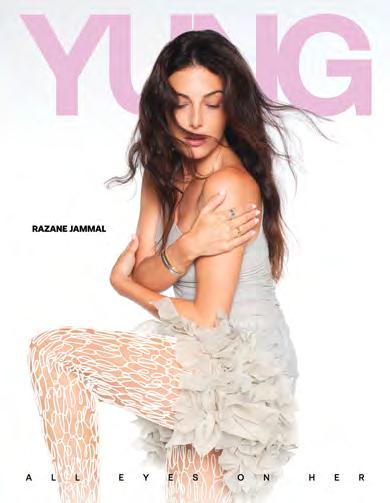


ADAM LOURAZI / ALEXIS PARENTE / AYMAN DOUBIAINE / BELLA ARMORAL / BETTY BEE / CHIKAKO SHINODA / CHLOE YATES / CHARLIE PHILIPS / DARCY NORGAN / DANIA MACIAS / EMI PAPANIKOLA / EMILE MAROUN / EMILY WHITE / ERIKA KIMURA / FAYCAL / GRACE SPINK / GUILLAME MERCIER / HAWRAA DAKAK / HOLLY CARSON / IBTISSAM ADLIMI / INGRYD MARINS / JACK CHIPPER / JANE TINNEY / JEAN KAIROUZ / JEYENDRAN JEYACHANDRAN / KEI KOSHIGOE / MARIA TERESA
STRIPPOLI / MASAYOSHI FUJITA / MONTY COOKE / MRAD COMPANYNENCY / OWEN RUPPERSBURG / OLYA KUSHYK / PAV NAGRA / POLINA SHABELNIKOVA / PUSHPA METTEW / RUBY RAINE / RORO CUENCA / RAJA ZGHEIB / SAMER RAHMA / SARAH LARBY / SASHA MAMEDOVA / SHARBEL HASBANY / SINA BRAETZ / SORAYA PHIPPS / STEFANO SCLUTO / TAMARA DAVIDSON / TARA MILES KINGSTON / WAEL SALLAM / WADIH RBEIZ / YARA GHAOUCH / YASMINA
HILAL / YELA ENAID / YEHIA BEIDER
YUI OZAKI / ZEINAB ATTIA
words

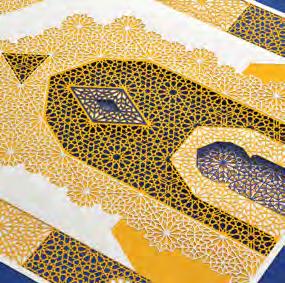





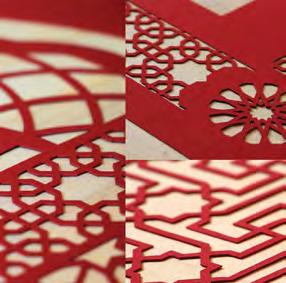


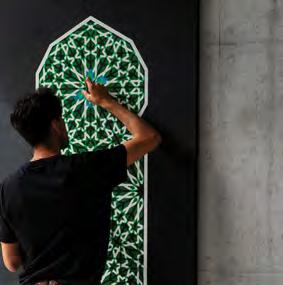



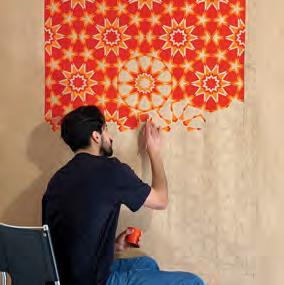


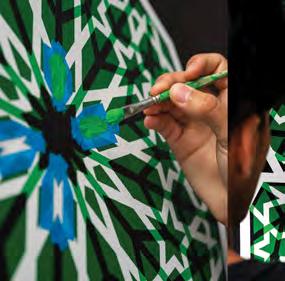


Moroccan artist Mohammed El Hajoui’s practice bridges ancestral traditions with contemporary concerns. Rooted in the use of organic pigments and humble materials, his work reflects on impermanence, cultural memory, and the fragile beauty of disappearing customs. Through his temporary creations, he seeks to honour indigenous practices while addressing urgent social and political issues not often portrayed in the media.
Your work is often described as fragile and temporary by design. What draws you to the idea of impermanence in art?
I’m interested in assigning a finite lifespan to a work of art, consciously deciding the moment it is born and the moment it disappears. We live in an era where everything is consumable and monetizable, but when a work is ephemeral, everything changes: it becomes unrepeatable, personal. I’m also fascinated by the fact that each time I recreate the work, it changes form, it adapts to the space, to the time, to the context. The idea that something exists only for a limited time makes the viewer more attentive, with a deeper gaze. In my work, time is not just a frame it is part of the work itself. It shapes its perception and builds its meaning.
You’ve described your materials as “poor and simple.” What role does that play in your artistic philosophy?
When I speak of “poor and simple materials,” I’m not referring only to their economic value, but to their intrinsic nature. I feel the need to return to the essential to use what is already there, available, close by. It is in their simplicity that their strength lies. I’m also fascinated by the idea that, once the work is finished, there can be a sort of return to nature, that what composes the artwork can once again become part of the natural cycle. In a way, my artistic gesture is a form of respect: toward the material, toward time, and toward the world that hosts me.
Many of your pieces are made with natural pigments and powders. Do you see a spiritual or symbolic quality in working with the earth itself?
My most important projects (for me) are created using natural pigments and powders, and these are the ones I feel most connected to because, on a spiritual level, they link me to my culture and its practices during ancestral celebrations. I grew up watching the women in my family work with natural materials for food, beauty, and medicinal purposes, and I was deeply impressed by their methods of preparation. Symbolically, I like to focus attention on what is concrete and alive. I enjoy having contact with certain materials that connect me to my more indigenous family roots. Part of my family lives in Tarfaya, in the Sahara, and on my mother’s side, from a town near Marrakech. Even though we are in the same country, the customs and the materials themselves are very different.
You’ve expressed a deep admiration for indigenous cultures. What have you learned from them that has shaped how you make and share your work?
Indigenous cultures, with their simple way of life and deep connection to nature, teach us a respectful and devoted relationship with the world around them. Living with what the earth provides, and with an awareness of natural rhythms, they treat every element with a sense of sacredness. This way of living, which values simplicity and honours nature’s timing, has led me to reflect deeply on my own creative process. This approach encourages me to consider not only the aesthetic aspect, but also the substance, the origin, and the energy of what I choose, so that each element is used with full awareness and devotion.
From Beirut to Brooklyn, Julianna Alabado approach to style is a combination of honouring heritage and boundless imagination. Seeing fashion as the vocabulary of identity, she started her career young, at 18, and has worked with some of the industry’s leading voices. Her authentic approach combines classic elements with a contemporary approach, creating styles that defy time. From editorials to brand campaigns and collaborative projects, Alabado works with photographers and designers to tell stories that are transportive, layered, and emotionally rich.
I was working for menswear director Bruce Pask, we were in Ischia, Italy, shooting the most gorgeous cover story and I felt fully transported. The photography, model, styling, setting, all of it just came together and it was like seeing a great piece of cinema but in a still image. Completely transportive.
Your work blends fashion into everyday life with a quiet elegance, how do you strike that balance between aspirational and authentic?
I like to balance my stylistic approach with nods to vintage or classics in some way. I have found it helps balance everything out. I could be styling a new collection but in some way I still want it to look and feel like it could be relevant no matter what year it is. I don’t like the idea of anything fully going “out of style”, nothing should be that jarring to the eye that it would need to have an expiration date on relevance. Ho w do you approach collaboration with photographers, writers, and designers in a way that allows the story to grow organically?
I love a collaborative mood board between myself and a photographer or designer. It allows us to show our ideas and concepts and tell a story ahead of the story we will actually create. Storytelling is everything to my approach, so I try to work with teams that also prioritize a strong story or point of view over anything else.

What’s your earliest memory of fashion and how did you first get into the field? My mum, Nayla. I would watch her get dressed, she was a vintage collector and put together the most vibrant and effortless outfits. She was born in Beirut and had a way of expressing her culture, personal style and personality so perfectly through what she wore. She taught me how to take pride and care in the choices I made daily when getting dressed. They were sweet moments of creativity I didn’t even realize when I was young! I got into the field through an internship at Teen Vogue at the young age of 18. I moved out to New York and dived right in, I then quickly met a stylist who would become my mentor and I’d leave fashion magazines to learn from some of the most incredible fashion stylists of the time. It was fantastic timing mixed with true raw passion.
Growing up between cultures, how have your personal experiences shaped the way you see fashion as a language of identity?
I see fashion as language. It’s a visual expression, yes, but it also speaks to where you come from, what you find inspiring, and it has the power to show how you see and interpret beautiful things into wearable moments. Was there a moment or project early on that made you realize storytelling was your path, not just as a passion, but as a profession?


Tara Aldughaither is the creative behind Sawtasura, an artist and research-led studio listening to and resounding women folk voices in the Arab Gulf. As an independent platform, the work spans archiving, embodied composition, and curation. Aldughaither’s practice is rooted in feminist theory, ecological knowledge, and somatic-informed frameworks and the process aims to transform sonic traditions into spaces of renewal and repair. Through exhibitions, sonic essays, and workshops, Sawtasura amplifies voices often overlooked, reimagining how sound and memory shape collective histories across the region.
What was the turning point that led you to bring Sawtasura to life?
During Covid, like many, I was grieving. It brought me to life to remember stories shared by Kay Hardy Campbell while at the Arabic Music Retreat in Boston, summer of 2018. Kay is an oud player, writer, and Arabic speaker who spent time in Saudi in the 70’s and wrote rare accounts about folk women wedding singers. I didn’t love that I needed to travel across the Atlantic to be in a safe and seasoned context for musical learning and also learn about my own history from there. I wondered how inaccessible that fruitful era was to most from my generation. Kay’s courage to listen stayed with me until I had the opportunity to apply for a cultural grant a year later to start this project. At the time, the idea of a women’s sonic archive accessible to artists and researchers was unthinkable in Saudi.
When you first started Sawtasura, what was the earliest moment or voice you archived that made you feel: this matters?
The urgency of Sawtasura became clear through several moments, the earliest being in 2019 while I was preparing a sonic sculpture inspired by complex beats of Hasawi “Dazza,” a bridal celebratory rhythm specific to the Hufoof Oasis. A wedding singer I contacted told me those heavy rhythms were no longer played or requested. This news was echoed by seasoned cultural journalists and writers who confirmed that a significant portion of Saudi’s traditional folk music had already disappeared.
In the women’s scene, the loss seemed even more acute due to the lack of access to their private spaces, which made their histories harder to document. Encounters with singers who feared being forgotten, and hearing Safiya Shetaiwi, a composer, oud player, and poet, speak candidly about the decline of women musicianship or musical skill despite the new openness, confirmed that this work was essential. Women’s musical contributions in Saudi were vanishing from collective memory, leaving a painful gap for future voices. While Sawtasura has sparked public interest in these voices, meaningful institutional support for their preservation is still absent outside commercial or promotional interest.
Your work often exists at the intersection of curation, sound, and embodied storytelling. How do you approach the process of transforming research into something sensorial or performative?
It takes both time and intuition. Think of a curator approaching a historical object in a museum, they need to understand as much as they can about the context to tell its story. When working with intangible cultural heritage, especially the voice, which is produced by the body, the work also demands tuning into your own body to understand the material through deep listening, mindfulness, and intuitive play. That embodied awareness, combined with knowledge of sociological, musical, and literary contexts, allows the research to transform into something people can feel, not just read about.


Emirati artist, director, and photographer Omar Almahri is a rapidly rising creative star. His works moves between film, photography, and visual production while speaking a cinematic language that, while contemporary and bold, is unapologetically Emirati. His directing is narratively rich, while his photography distils those same stories into single, impactful images. Almahri has worked with global icons and brands such as Pharrell Williams and Gucci Beauty, showcasing his adaptability and creative flexibility, while also a talent to watch.
What first sparked your interest in film, photography, and visual storytelling?
Ever since I was 12, I’ve been captivated by the media world. I spent a lot of time on YouTube, wanting to be a YouTuber, and I started filming different things on my iPad and later editing them together. When I turned 14, my family asked what I wanted for my birthday, and I told them I wanted a camera. From the moment I got it, I carried it with me everywhere, filming different occasions to create memories that could last forever.
How does your Emirati heritage influence the way you work?
It appears in subtle ways through traditional clothing, local settings, and stories I grew up with in the UAE. In both film and photography, I include it wherever it feels authentic and always in a way that respects my traditions and my religious beliefs. For me, it’s the least I can do as an Emirati artist: to reflect where I come from not only for regional audiences who already understand our culture, but also for global audiences, so they see beyond the stereotypes of wealth and luxury and instead recognize our culture for what it truly is, respected, rooted, and meaningful.

Your work is cinematic and culturally grounded. How do you balance universal appeal with local authenticity?
I approach it by starting from a place of honesty. My stories are grounded in the culture and experiences I know best, but I frame them in a way that highlights universal emotions like love, nostalgia, or struggle that anyone can connect with. The details might be local, whether it’s a setting, a gesture, or a
tradition, but the feelings are global. That balance allows me to stay authentic while making sure the work speaks to people everywhere.
How do you make sure your voice stays distinctive when working with major brands?
I’ve worked very hard to create a distinctive voice in my work, and that’s something I protect. When a brand or client approaches me, it’s usually because they want to adapt my lens rather than the other way around. Of course, I always balance my vision with their brief, but I don’t let anyone break down what I’ve built, no matter how big the brand is. Over time, I’ve realized that by being consistent with my style and putting my work out there, people begin to recognize it. They start to adapt to my voice and only approach me when they feel a project truly fits with what I do.
How would you describe the signature style or atmosphere that runs through all your projects?
I create films with the intention of moving people, especially on an emotional level, and that’s something I consistently bring into my work. With photography it’s similar, but there’s also a strong focus on art direction. Whether it’s film or photography, I pay close attention to building the atmosphere and bringing life to the sets so that the feeling comes through as true as possible. What stays consistent across everything I do is creating work that carries emotion and having a strong eye for art direction to make those emotions real and lasting.
United by their love for chai, Emirati Ahmed Kazim and Indian Justin Jeff Joseph founded Project Chaiwala to share the spirit of street-side tea culture with the world. Inspired by the bustling chai stalls of Delhi and the cosy corner shops of Dubai, their vision blends tradition with innovation, offering a modern, yet authentic, chai experience. Their journey began at tea estates in West Bengal, followed by countless cups from local “chaiwalas,” and has resulted in a brand rooted in storytelling, community, and heritage. Today, Project Chaiwala stands as a proud, honouring the region’s tea culture while bringing people together over a freshly brewed cup.

What inspired you to start Project Chaiwala, and how did the idea first come about?
Project Chaiwala started with conversations during our tea breaks in our day time jobs. We noticed a gap in the market when it comes to chai and tea. We decided to jump on a plane to the capital of tea, in India, to learn more about the process and the ground root stories from the streets. We added our own Dubai touch to it and make it accessible to over 200+ nationalities.
Why chai? What does it represent to you both personally and culturally?
We both grew up in Dubai through our different experiences, however chai/tea was a staple in every household and setting. It resembles the connection we have with others since it’s always consumed in a group setting. At home or through a drive with our friends, our common denominator was always chai.
How did your backgrounds and experiences influence the creation of Project Chaiwala?
Being third culture kids in Dubai, we wanted to create a brand and a product that reflects this not only to us but to everyone else around us in the UAE and beyond. We had the privilege of representing Dubai in South by South West in Austin Texas earlier in March 2025 to a completely different audience and thankfully this has reflected extremely well for the brand and it’s ethos.
What role does storytelling play in shaping your brand identity?
Our brand is all about storytelling, whether it’s us as founders and our individual stories, the products we launch, and finally, and most importantly, this beautiful city we both grew up in and what it’s transformed into over the years.
Can you walk us through your process of sourcing ingredients and ensuring quality?
We have a very diligent process when it comes to product sourcing. We strive by a tagline that we’ve created which is “brewing tradition, blending innovation”, we follow this line in every step of the way. Whether it’s ingredients sourcing, production and also presentation, we strive to be the best in what we do.
How important is community in your brand, and how do you create spaces where people connect over chai?
We are not just an F&B concept, we’re building a brand that people can turn to and live by. Hence, the focus on community throughout our early stages has been a key pillar of Project Chaiwala. We host a community event called “Karak Groove Sessions” which focuses on gathering people together from different backgrounds for

the love of chai and music. We usually showcase up and coming artists within the region through a music event. The most recent one was hosted with Oatly in Cinema Akil, the first art house cinema in the region.
Do you see Project Chaiwala as part of a wider movement of redefining cultural food and drink experiences?
This is exactly why we started Project Chaiwala. Our aim is to globalize Project Chaiwala from the UAE to the world. Reflecting the true ethos our region and encompassing it’s values and culture.
What’s your personal go-to chai order?
I keep it classic with my Karak Aslee chai and go for a Molten Karak whenever I want to treat myself.
Adam Afkir’s designs are nothing if not rooted in a clear sense of strength and sensuality. The 26-year-old selftaught fashion designer is based between Paris and Dubai and is working to constantly redefine femininity through his own lens. Inspired by fashion, art and pop culture, Afkir’s first taste of fashion came through crafting outfits for this twin sister’s Bratz dolls; now, that same love is poured into AFKIR Paris, a label that embodies confidence, allure, and uncompromising, modern femininity. His work is full of contrasts, black, leather, and sharp lines form a visual language that feels powerful and unapologetic.
How did your journey into fashion design begin, and what inspired you to pursue it as a career?
From a young age I absorbed fashion from every angle, the streets, the people, the pulse of pop culture. My journey started with sketching for fashion designers and stylists, which sparked my passion and led me to pursue it as a career.
AFKIR PARIS has a distinct aesthetic. How would you describe your design philosophy and what sets your brand apart?
AFKIR PARIS embodies dark sensuality and controlled power, where sharp tailoring, bold silhouettes, and textured contrasts craft a wardrobe for dominant, confident women who don’t seek approval, only to be remembered.
What’s your creative process like when designing a new collection? Where do you typically draw inspiration from?
My creative process starts with a feeling often triggered by music. Sound sets the mood, and from that feeling, I translate it into texture and shape. I draw inspiration directly from the female form; its strength, fluidity of movement, and timeless elegance
Your background in international business adds an interesting layer to your career. How has that knowledge helped you in the fashion world?
Understanding international business allows me to approach fashion not just as art, but as a global industry, helping me manage growth, partnerships, and cultural nuances effectively.
You’ve worked as a fashion illustrator for brands like Tiffany & Co. and Rami Al Ali. How did those experiences shape your approach to design, and what did you learn from them?
These experiences taught me how to blend artistic vision with technical precision, shaping a design approach that’s both fierce and refined
You’ve worked with major names like Beyoncé; what was that experience like, and how did it shape your approach to design?
Collaborating with Beyoncé, a goal I had long aimed for, was a huge learning experience. It showed me the importance of excellence and innovation, inspiring me to approach every design with greater ambition and focus
How do you balance pushing boundaries while keeping things wearable?
Finding the balance between innovation and wearability is a constant challenge, I meet it by blending daring design with practical details like adjustable lacing, stretch fabrics, and thoughtful closures that make each piece easy to wear.
What was the first piece you ever designed, and do you still see elements of that in your work today?
I started by designing a corset; since then, sculpting strength and form has been central to everything I create.






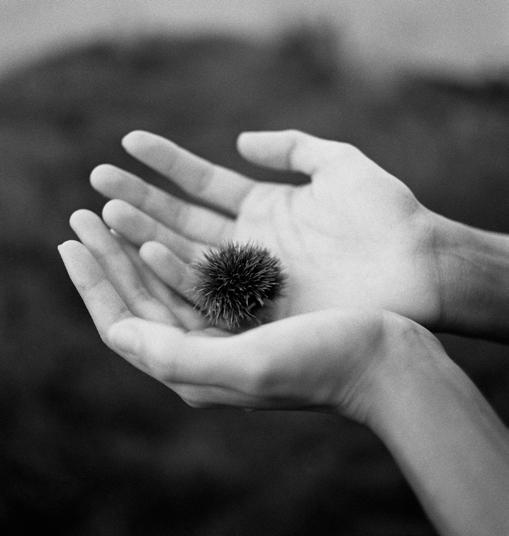


Fuelled by her experience as a refugee, Sara Kontar turns exile into art. The France-based Syrian photographer, filmmaker and visual artist transforms memory, displacement, and identity into intimate, layered stories. Through photography and film, Kontor captures the spaces between “here” and “there,” the past and present. Themes of disconnection, intimacy and resilience come through in monochrome images, quiet gestures, fleeting moments; fragments of memory tell of loss and profound insight and connect her personal history with that of a wider collective.
Can you share how your personal experience of exile and displacement has shaped your artistic vision?
Exile taught me to see what remains when everything familiar disappears. I hold on to small details, the objects we carry with us, the fragile spaces we try to make into a home, even if just for a moment. Much of my work begins there, in the space between memory and the present, between “here” and “there,” the near and the distant. Photography and cinema have become ways for me to trace these invisible threads, to give meaning to what exists in between.
Your work spans photography, film, and installations. How do you decide which medium best tells a story?
I have a special attachment to the still image, to the silence it holds, fixing memories that might otherwise vanish. Some moments demand that silence, a pause in time. I like to think of photography as a form of theft, in a world where I often feel I have no control over memory or place. Other stories need the flow of time, the rhythm of voices and movement, and that’s when film becomes essential.
Your work often examines both personal and collective narratives. How do you approach telling these intertwined stories?
I search for the personal thread that reflects a wider story. Small gestures, shared habits, and fragile rituals can all speak of exile, of endurance, of what remains beyond borders. Through the intimate, the collective naturally appears. What matters to me is not to speak on behalf of others, but to trace the connections between our experiences.
What sparked the idea for Al-Ayoun, your space for visual storytellers in Syria and the diaspora, and why was it important for you to create a space dedicated to Syrian storytellers? Al-Ayoun was born out of the need to bridge distances. Inside Syria and across the diaspora, artists often work in isolation. I wanted to create a place where stories could meet, where projects could breathe together. It is a way of safeguarding our narratives, of keeping them alive beyond the borders imposed on us.
Your work often embraces a monochrome or black and white palette. What draws you to this visual approach?
Black and white create a distance from reality. Living in a state of constant disconnection, I feel they express me more fully in the context of exile. The colours here do not resemble me, and the light feels different, lacking the warmth I grew up with. Perhaps one day I will return to colour photography, but maybe only when I can return to my homeland.
What themes or ideas do you find yourself returning to most in your films and photography?
I always return to exile, to the questions of home and borders. I feel tied to these themes, not out of choice but necessity. I did not choose exile, and if I had the choice, I would rather not have lived it, even if that meant I might never have become an artist. Exile, home, and borders are simply the natural shape of my life and experience.

Inspired by her Algerian roots and her love and respect for the finest materials, Lilia Yasmin’s ATLAL FROM GALBI is a love letter to heritage and craft. By using couture fabrics, Yasmin combines a timeless nostalgia with a very contemporary take on fashion. Her pieces combine craftsmanship with a sense of storytelling, coming together in a celebration of Arab identity, one of elegance, tenderness, and power. ATLAL FROM GALBI speaks of 1970s glamour and a sense of cultural memory.
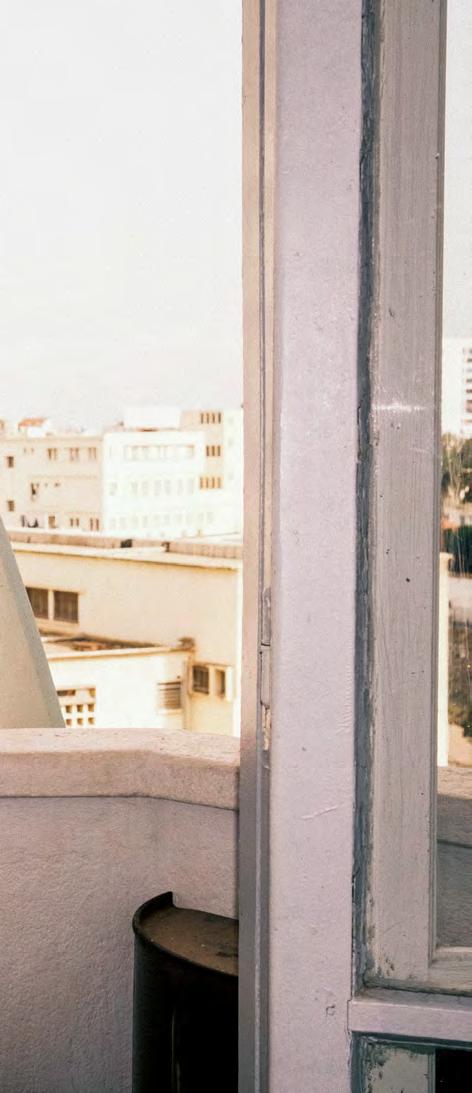
What inspired you to create ATLAL FROM GALBI, and what does the name mean to you personally?
ATLAL FROM GALBI was born from a desire to connect fashion with memory and culture. Growing up between different worlds, I always felt the importance of carrying my roots with me, while also embracing a contemporary, global perspective. The brand is a way to celebrate Arab and North African heritage through a modern lens elevating the symbols, stories, and aesthetics I grew up with and translating them into high-end fashion pieces that can speak to an international audience.
The name itself is deeply personal: ‘Atlal’ means ‘ruins’ in Arabic and is a song of Oum Khaltoum, and ‘Galbi’ means ‘my heart’. Together, it represents both nostalgia and resilience looking at the past with love, but also transforming it into something powerful for the future. For me, ATLAL FROM GALBI is about remembering where we come from while imagining where we can go.
What role does memory and personal storytelling play in your creative process?
For me, clothes are never just objects, they carry emotions, histories, and identities. I often start a collection with a very personal memory: my grandmother’s wardrobe, an image from Algerian cinema, or a piece of jewellery I saw growing up. From there, I translate that feeling into silhouettes, textures, and details that can resonate beyond me. It’s a way of transforming intimate moments into something collective, where people from different cultures can connect with the work, even if they don’t share the same background. That’s what makes the brand powerful: it’s rooted in something deeply personal, but it opens a space for universal emotion.
You use luxury house fabrics to reinterpret silhouettes, what draws you to these materials?
I choose luxury house fabrics not only for their elegance and durability, but also because reusing and recontextualizing them is a way to design more responsibly. My desire is that my customer can wear my design for a lifetime. It also a way to create a dialogue between worlds, and that tension is at the heart of ATLAL FROM GALBI.
Your work is described as emotional storytelling through clothing, how do you translate emotions into garments?
For me, emotions translate into garments through details that carry memory. A cut inspired by a family photo, embroidery reminiscent of traditional jewellery, or a colour that recalls a moment, all these choices come from feelings rather than trends. I try to capture the poetry of nostalgia and transform it into pieces that people can wear every day. That way, the clothes don’t just dress the body, they carry a story and a state of mind. For me, my job is done when the customer becomes the storyteller. If someone asks them about a garment and they explain the cultural reference behind it, then the piece is doing its job, it’s transmitting memory and culture through clothing.
What do you want people to feel when they wear ATLAL FROM GALBI?
I want people to feel a sense of pride, and connection when they wear ATLAL FROM GALBI. Pride in themselves, in their individuality, and in the stories that the clothes carry. Even if someone doesn’t share my background, I want them to feel part of a bigger cultural dialogue, like they’re wearing a piece that holds memory, heritage, and meaning. At the same time, I want them to feel powerful in the present: confident, elegant, and contemporary. For me, the true success of a garment is when it feels both personal and universal, when someone wears it and feels they are carrying a story worth sharing.
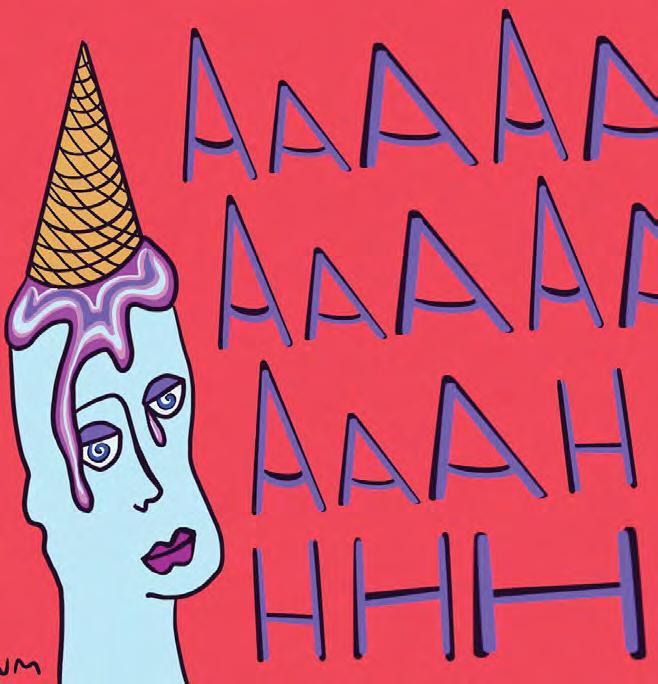

Palestinian-Jordanian graphic designer and illustrator Nour Milhem has built a practice that feels both playful and profound. Based in Dubai, she channels her cultural roots and global perspective into bold, colourful works that blur the line between imagination and storytelling. Her illustrations often invite audiences to reconnect with their inner child, while also carrying deeper layers of identity, resilience, and activism. With a style that embraces imperfection as a form of honesty, Milhem’s work resonates as it speaks to both the eye and the heart, offering beauty, depth, and a reminder of the power of creativity to inspire change.


Growing up Palestinian-Jordanian and now working in Dubai, how have your cultural roots influenced your artistic style and storytelling?
Being Palestinian-Jordanian, creativity and craft feel deeply rooted in who we are. Our culture is full of poetry, beauty, purpose, and knowledge—and all of that finds its way into my work, sometimes subtly, sometimes more directly. Living and working in Dubai exposed me to a mix of cultures, languages, and beliefs, which gave me a wider lens on the world. At the same time, it reminded me of the importance of staying true to my own roots. I try to embrace both, drawing inspiration from my culture and from the people around me, so that my creative outcomes reflect authenticity while still engaging with the diversity of my surroundings.
How do you balance creating visually engaging art with the deeper themes of identity and resistance in your work?
For me, it’s all about creating what feels necessary in the moment. I’ve learned not to force it, sometimes I need to express something tied to identity or resistance, in hopes that it resonates or brings comfort to others. Other times, I just need to make something bold and colourful that reflects my own personal life, even if its meaning is less obvious.
The visual appeal draws people in, but what sustains their connection is the depth layered beneath, whether that’s cultural resilience, personal stories, or lived experiences. I see it as creating work that speaks to both the eye and the heart, letting beauty and meaning coexist.
Can you walk us through your creative process when starting a new piece? Where do your ideas typically come from?
For commissioned pieces, I always start by respecting the brief and its theme. From there, I like to add a layer of surreal, childlike imagination that makes it personal. With independent work, ideas usually come from everyday life, things I observe, conversations I overhear, or random thoughts that stay with me. When I start creating, I enter a kind of space where reality and imagination blur, and I let the piece unfold naturally.
What’s your favourite colour to work with, and does it have a special meaning for you?
I’m always drawn to shades of blue and purple, especially electric blue and vibrant purple. They’re soothing but also bold, they make other colours pop while leaving a strong impression. To me, they represent positivity and creativity, bringing energy and balance to my work.
For London-based Syrian fashion designer Zeina Issa, more than clothing, fashion is a central pillar of identity. As she pursues her Masters at Central Saint Martins, Issa creates incredible pieces that speak to lived experiences and heritage, particularly those of Arab Muslim women. Having fallen in love with fashion through Project Runway, Issa sees it as her life path and a way to embrace her cultural heritage having once distanced herself from it. Issa’s work is nothing less than a contemporary exploration of faith, culture, and the nuances of Arab and Muslim womanhood.
How did you first get into fashion, and what drew you to pursue it seriously as a career?
Fashion has always been part of me. As a child, I used clothes as a way of understanding myself, but the real turning point came in seventh grade when I discovered Project Runway. Growing up in Abu Dhabi in the 2010s, I hadn’t realized fashion could even be a career. From that moment, I knew it was what I wanted to pursue, and after years of convincing my parents, I eventually went on to study design at university.
How has your Syrian heritage shaped the way you approach fashion and design?
That’s a hard question. I’ve been away from Syria for over 15 years, ever since the war began, and because of that, I felt disconnected from that part of myself. In my earlier work, I barely confronted it, but in recent years, I’ve felt a strong desire to reference and reinterpret my heritage within my practice. My upcoming final Master’s collection is where I’m definitely exploring this more, approaching it organically in a way that feels authentic to who I am. With so few Syrian designers in the industry, part of my motivation is to create the representation I once longed to see when I was younger.
What personal experiences most influence the stories you tell through your garments?
My work is shaped by my experiences as a Muslim and Arab woman. I often explore my relationship with faith and cultural identity, as well as how personal identity is shaped at the intersection of the two. I am interested in what it means to navigate openness or restriction in these spaces, and how women like me position ourselves within them. These are realities many Arab Muslim women experience but do not often speak about, sometimes because they are taboo. My garments materialize those emotions and contradictions, capturing what it feels like to exist between and outside of imposed perceptions.
Can you walk us through your design process and how you start a project?
My process begins with intention, thinking about what I want to say, who I’m speaking to, and why it matters. I start with the personas I’m designing for, and they guide all my research through historical garments, art, films, or personal archives. Styling is a critical step, where I work with pieces from my wardrobe while keeping my research in mind, intersecting historical or past references with something distinctly my own. Simultaneously, I experiment with fabrics, prints, and unexpected materials, guided by my research and personal lens. Finally, through collaging, which is my favourite part, I develop design ideas.
You use unconventional materials in your designs. What role does experimentation play in your process, and how do you choose which materials to work with?
Designing the textile is my favourite part of making garments! I constantly push myself to experiment with new materials, approaching each choice meticulously, as it defines the very essence of the piece. Some of my previous projects include using wooden beads to reflect heaviness, repurposing a wedding dress into a bridal jersey, and even experimenting with grass, chandelier crystals, and 3D printing.
How do you balance traditional craft with contemporary aesthetics in your work?
I love traditional craft. Handmade work has such depth and presence. To bring it into a contemporary space, I often combine it with unexpected materials or reinterpret it through modern silhouettes.
What is one piece in your own wardrobe you could never part with, and why?
100% my belly dancing belts! I’ve been collecting them for years and now have 25 pieces, all second-hand, I might add. At university, the jingling of my belts lets everyone know I’m in the studio. They’ve become almost like a sense of home, elevating any outfit, carrying Arab identity, and always reminding me of who I am.

Moffat Takadiwa’s creative career is a story of rehabilitation and reuse. Hailing from Zimbabwe, Takadiwa creates monumental sculptures using objects salvaged from garbage dumps. Carefully collected and meticulously sorted by colour and form, these fragments of consumer excess are turned into thoughtful works of unexpected beauty. These works, often reclaimed “post-industrial fabrics,” transcend their origins, assuming the aura of ritual objects that tell of the world around us, waste and, intriguingly, culture. On top of all this, Takadiwa uses his practice as a platform to uplift and rehabilitate his community, building a centre to support his people through his art.

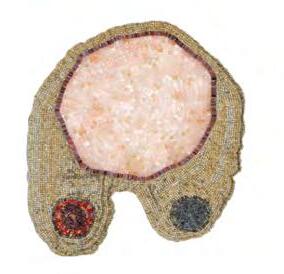
Can you tell us how your journey as an artist began, especially working with discarded materials?
I have been interested in creative ideas from a very young age, even as far back as preschool. I grew up as a quiet child and enjoyed spending time in isolation, working on drawings or moulding with clay. My passion for experimenting with various materials led me to move from the small farming town of Karoi, where I grew up, to Harare, the capital of Zimbabwe. It was in Harare that I began my formal training and engagement with art, gaining a clearer understanding of what it truly meant.
Throughout my childhood, my parents provided unwavering support for my artistic pursuits. During my time at Harare Polytechnic College, I studied art during a particularly challenging period when the country was facing its worst economic crisis. We often couldn’t afford art supplies, so many students, myself included, had to find alternative ways to complete our assignments. This reintroduction of materials into my life reminded me of my childhood, where I played with different

items and created various things. My father worked in the only large shop in my small town, so I was surrounded by everyday products that fuelled my creativity.
How has growing up in Karoi and your Korekore heritage influenced your artistic vision? My work is heavily influenced by communal knowledge systems and various methods of doing and undoing. When I was young, Karoi had several craft-related projects aimed at supporting women and young people. The area lacked resources, so we had to improvise a lot, which led to significant re-use and repurposing of objects. Now that I am an artist living in the city, I still view the world through the lens of a country boy. I question the culture of accumulation and the hype surrounding products and brands, as well as their divisiveness among young Africans. This shift in everyday culture reveals the lingering effects of colonialism.
Growing up in Karoi, I never realized that I was different. You only come to understand the uniqueness of a language and culture when you are exposed to something different. As a young
person, I didn’t pay much attention to the important discussions around language and material culture. However, I am now beginning to delve into these topics, as I believe that with growth comes a greater curiosity about the past and the desire to revisit cherished memories.
What first inspired you to start transforming everyday objects into art?
Initially, I was thrilled by the idea of viewing trash as potential materials, especially since we, as students, were struggling to find traditional resources.
I found inspiration in the ‘Made in China’ labels that were starting to dominate the market. Engaging in conversations with my peers about the economic and social changes I observed at the dumping sites became a new obsession for me. I began visiting various dumping sites and drew immense creative inspiration from the seasonal changes and the rich narratives present in these locations.
What role does environmental awareness play in your creative process?
I strive to present a comprehensive and distinctly nonWestern perspective on environmental awareness, drawing from a rich tapestry of references and traditions that often go overlooked. It’s important to emphasize that discussions surrounding environmental consciousness are not new to the global South. For instance, in my country, the words for pre-colonization are “pasi chigare” which translates to “when the earth was still seated” and intrinsically connected to notions that connected the environmental disasters with colonization and that predate both the concept of the Earth as we know it today
and the environmental disasters that have shaped much of our modern landscape.
How do you see your work engaging with Zimbabwe’s post-colonial identity?
It is very difficult to separate culture from everyday life. After years of digging through dumping sites, I can tell you that Zimbabweans currently import almost everything they use in their daily routines. I have created several works that question how Zimbabweans perceive themselves as having indigenous solutions and being a sovereign country, while their daily waste tells a different story—one of a colonial hangover and dependence on foreign goods, lacking self-sustenance and cultural identity.
People are shaped by what they eat and use every day. Can you imagine that four decades after independence, Zimbabweans still consume Sadza made from white or yellow maize? This maize was introduced by the colonial administration to feed livestock, not for human consumption, yet it has become our staple food and is now considered part of our culture.

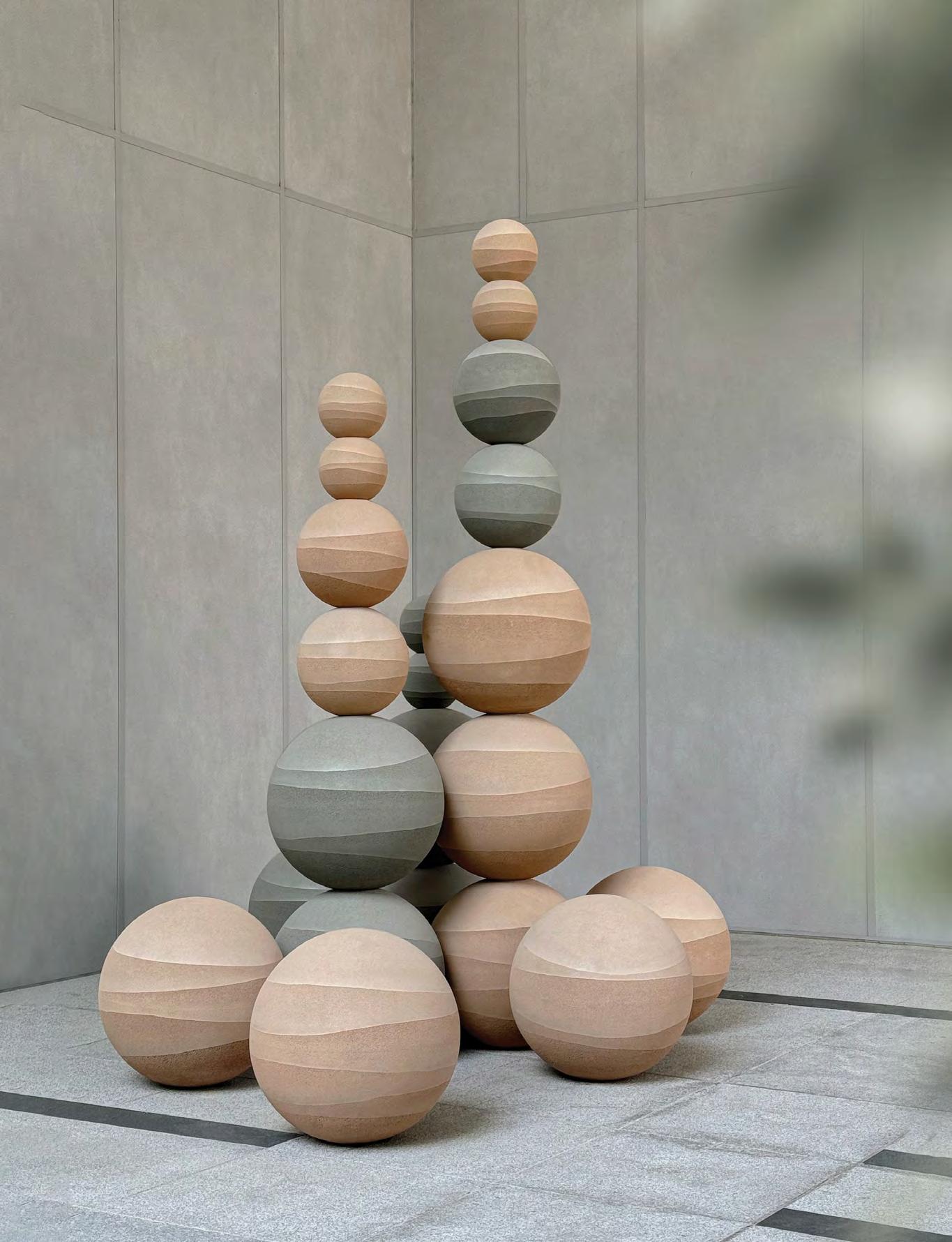
Dubai design studio Karim + Elias is turning grains of sand into a language of craft and culture. Founded by Karim Tamerji and Elias El Hage, the studio reimagines one of the region’s most abundant resources as a study of both heritage and innovation. By combing ancient rammed-earth techniques with contemporary design, their work positions sand as more than matter, it becomes narrative, connecting sustainability, identity, and regional history in forms that feel at once timeless and new.
What first drew you to working with sand as a central material in your creative practice?
We had experience exploring the material and technique many years back, and it seemed so contextually appropriate to open a new artistic chapter with it. Essentially, our studio’s work bridges two narratives together; one of adopting a local material with meaning, desert sand, and one of preserving an ancient artisanal technique, rammed earth.
Sand has existed timelessly and, in many ways, paints a meaningful picture of the region’s history, culture and identity. Instinctively, we saw this as an opportunity worth celebrating while asking ourselves: “How can we use the most abundantly found local material as a cultural ode to the larger region? What tangibly bridges the boundaries between these neighbouring lands?”
When you say “sand is a material with meaning,” what deeper message or emotion are you hoping to convey through it?
Celebrating an artform through context is the lifeblood of what our studio represents. It’s the recognition of geo-heritage at its core. We seek to revive an ancient craft rooted in heritage and in the region’s past, and to adopt the most available natural materials. Through creative exploration, we developed our personalized approach towards rammed earth in an effort to preserve the ancient art of “sculpting with sand”. Much like the preserved artistry of sculpting marble across Europe, or the mastery of carpentry in the far East, we consider ourselves revivalists of a traditional and localized craft, now reimagined through a contemporary lens.
What are the biggest technical or artistic challenges you’ve faced when sculpting with sand?
The nature of each new project or task often determines how our craft develops and how we overcome new challenges. The challenges that come with each one often push the R&D forward, allowing us to find new ways to reinvent how we use and express the material through form, colour, composition and function. With both ‘IOTA’ (2022) and ‘From This Earth’ (2024), our two public art installations, each had us explore the geometry, textures and structural challenges of composing with modular spheres. Both allowed a perceptibly heavy material to appear contemporary, soft and seemingly weightless. With ‘The Desert Relics’ (2024), pushing our work to new boundaries with grander scales introduced an unprecedented challenge. And with our architectural ‘Sand Skin’ surfaces, textural composition becomes the larger point of focus.
How do you see your work reflecting or contributing to the cultural narrative of the UAE and the wider region?
In short, finding sustainable ways to reintroduce the material as a household name is something we consider high on our vision board. Nothing would make us prouder than seeing desert sand being utilized as alternative architectural or product design solutions to more internationally renowned approaches. Utilizing a material and craft that is of and from the region can contribute to what a ‘modern vernacular’ means today.
When fashion is stripped down to its core. Clean lines, minimal sets, and sharp silhouettes take centre stage in raw black and white. A bold flash of red cuts through the simplicity. Fresh, modern, and refined – this is fashion, bold and loud with nothing to hide.





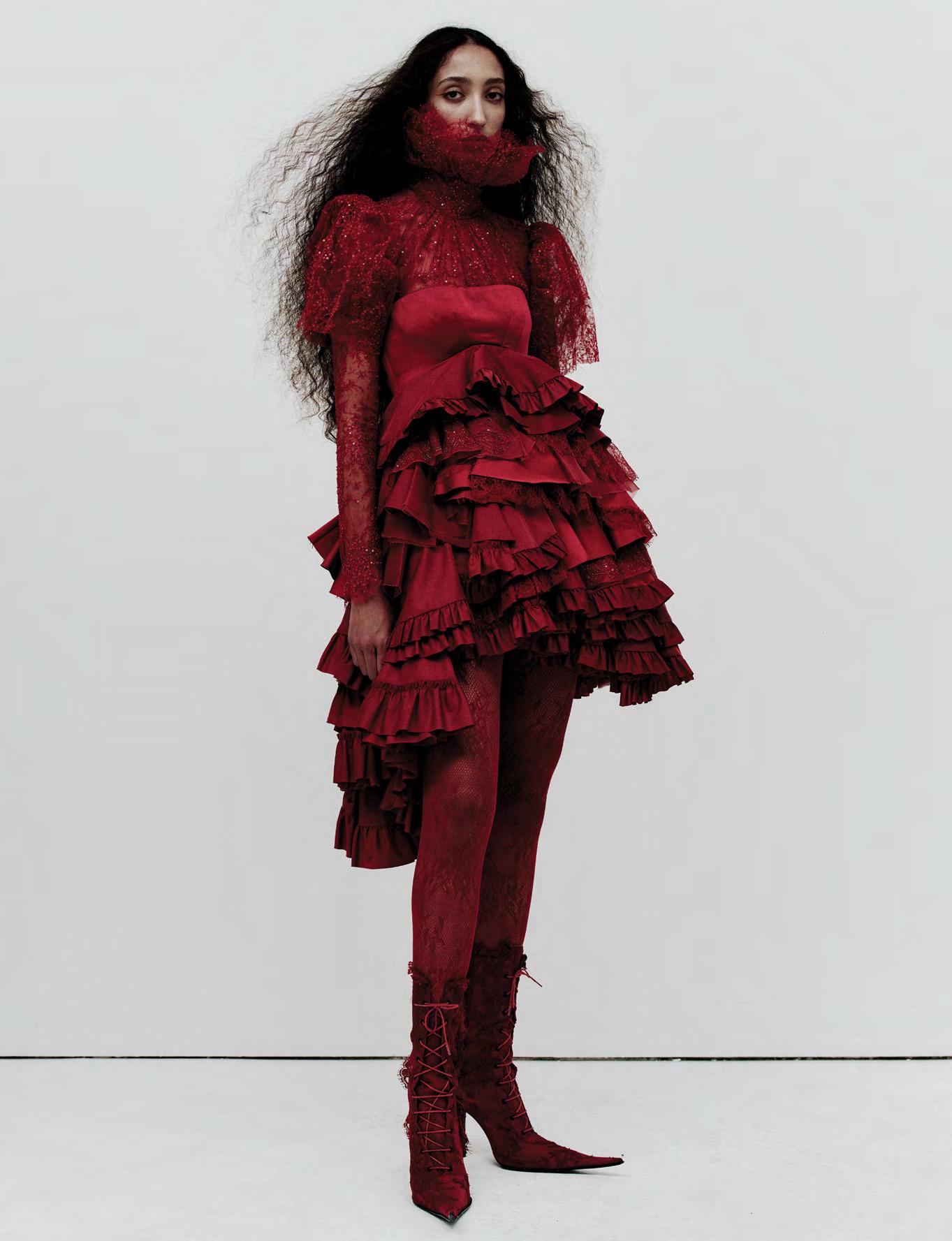







AI, fashion, and mythology are converging to reshape the meaning of art and architecture.
words NADINE KAHIL


When Larisa Bulibasa reflects on the beginnings of her artistic journey, she does not start with paintbrushes or canvases, but with blueprints. Trained at UCL’s Bartlett School of Architecture, one of the world’s most prestigious design institutions, Bulibasa spent more than a decade working internationally as an architect. Architecture gave her the discipline of precision, the rigor of structure, and an appreciation for functionality. Yet even during those years, she was drawn to what she calls the “poetic side” of the built environment: the way spaces can hold stories, shape human behaviour, and evoke emotions.
Her move into the world of art and experimental design was not so much a departure, as it was an evolution. “Architecture taught me discipline, structure, and the importance of functionality, but I was always drawn to its poetic side, the way spaces can hold stories and evoke emotions,” she explains. Over time, this poetic impulse became harder to ignore, leading her to explore new territories beyond architecture. She began experimenting with visual art and technology, seeking ways to express ideas that transcended function.
One of the most distinctive aspects of Bulibasa’s current practice is her approach to artificial intelligence. For many, AI is a threat to traditional creativity. For Bulibasa, it is a collaborator. She describes it as a partner, one that expands the possibilities of imagination.
“For me, AI is not a replacement. I see it as a co-author in my creative process. I often use AI to generate atmospheres, forms, or concepts that spark new directions, which I then refine through my own sensibility as an architect and designer,” she says. The relationship is dialogic. AI offers unexpected prompts and raw material, while Bulibasa shapes them with her human intuition, critical thought, and aesthetic judgment.
This is not an embrace of technology for technology’s sake. Rather, Bulibasa sees AI as an instrument that allows her to access dimensions of creativity that would be difficult to achieve otherwise. “I embrace AI as a tool of expansion. Instead of resisting it, I integrate it into my practice to imagine possibilities that are difficult to achieve with traditional methods alone,” she explains. In architecture, she uses it to reimagine landscapes, environments, and structures imbued with wonder. Her belief is that AI, whether in design or any other field, will inevitably become part of professional practice. The real challenge, she insists, is not whether we use it, but how. “For creatives, the challenge is to use it meaningfully — as a way to enhance our voice, not replace it.”
Bulibasa’s “Fashion Runway” series exemplifies this philosophy of merging the contemporary with the timeless. The project takes brands from the world of high fashion and places them in imagined landscapes, ruins, labyrinths, and surreal environments where the ephemeral spectacle of the runway collides with the permanence of mythic architecture.
“The Fashion Runway series was about merging contemporary fashion with timeless narratives. Each brand carries its own identity, and I wanted to place them within dreamlike worlds — ruins, labyrinths, and imagined landscapes,” she says. Her fascination with ruins is more than aesthetic. For Bulibasa, ruins embody both fragility and endurance. They are fragments of civilizations that have collapsed, yet they persist as testaments to human aspiration and resilience.
“What’s next for me is to keep contributing to that vision: to use design as an instrument for positive change.”


In her images, colour operates as an emotional bridge, connecting the aesthetic of the fashion brand with the architectural setting. Each collaboration is chosen intuitively, guided by resonance rather than strategy. “The choice of brands was intuitive: I was drawn to those whose design language resonated with my own philosophy of beauty and storytelling,” she explains. The result is a series that feels both futuristic and ancient, at once a reflection on consumer culture and an exploration of how style can be reframed as myth.
Bulibasa is not slowing down. Her future projects continue to push the boundaries between of architecture, myth and the future, “Right now, I’m developing conceptual projects where architecture meets mythology and technology, and I’m also preparing to launch a line of furniture and decorative objects that carry this same philosophy,” she says.
For Bulibasa, design is never just about appearance or function. It is about meaning, emotion, and impact. “Beyond the projects themselves, I believe design is here to inspire — to make life more beautiful, to shift us out of the mundane, and to create experiences that uplift our mental and emotional well-being,” she explains. Too often, she believes, design is reduced to either utility or aesthetics. She insists it can be more: “I see it as a powerful force that shapes how we live, think, and feel. What’s next for me is to keep contributing to that vision: to use design as an instrument for positive change and to play a role in showing the world what better design can mean for our future.”
Bulibasa’s work reflects a broader conversation taking place across creative industries. As artificial intelligence becomes embedded in workflows from music to film to architecture, questions about authorship, originality, and authenticity loom large. Her perspective offers a reframing. Rather than seeing AI as a threat to human creativity, she positions it as an amplifier, a tool that, in the right hands, expands rather than diminishes human imagination.
This philosophy feels particularly relevant in architecture, a field that has always balanced the rational and the poetic. By blending AI with her training as an architect, Bulibasa creates works that are both precise and dreamlike, structured yet unbound by conventional limits. Her art demonstrates how technology can be infused with humanity rather than drained of it.
Her trajectory from architecture to art also illustrates the permeability of creative boundaries in today’s world. The skills she honed in architecture, discipline, technical rigor, structural awareness, inform her explorations in AI-generated art. But equally, her embrace of art and mythology recharges her architectural vision, reminding her that structures are not just shelters but vessels of meaning.
In speaking with Bulibasa, one is struck not only by her vision but by her optimism. Where some see disruption, she sees opportunity. Where some lament the loss of tradition, she finds new ways to honour it. Her work with ruins and myth exemplifies this balance. They remind us of what is enduring, while AI offers a window into what is possible.
At the heart of her practice is a conviction that design has the power to transform lives. Whether through an artwork, a piece of furniture, or a conceptual building, she wants to create experiences that inspire and uplift. “Too often, design is reduced to utility or aesthetics alone,” she says. “But I see it as a powerful force that shapes how we live, think, and feel.”
As she moves forward with LB Design Lab, her studio that houses these explorations, Bulibasa remains committed to this mission. Her projects are not simply about producing objects or images. They are about proposing new ways of seeing, of connecting, of being in the world.
In an era where technology often feels alienating, her work suggests another possibility: that art and AI together can reconnect us with wonder, myth, and beauty. Architecture may have been her foundation, but it is through this hybrid practice of art, design, and technology that Larisa Bulibasa is building her most ambitious structure yet, a vision of creativity where the past, present, and future converge. ■


“The choice of brands was intuitive: I was drawn to those whose design language resonated with my own philosophy of beauty and storytelling.”

Anthony Adonis, in Cartier, talks language, music, chaos and the stories we tell.
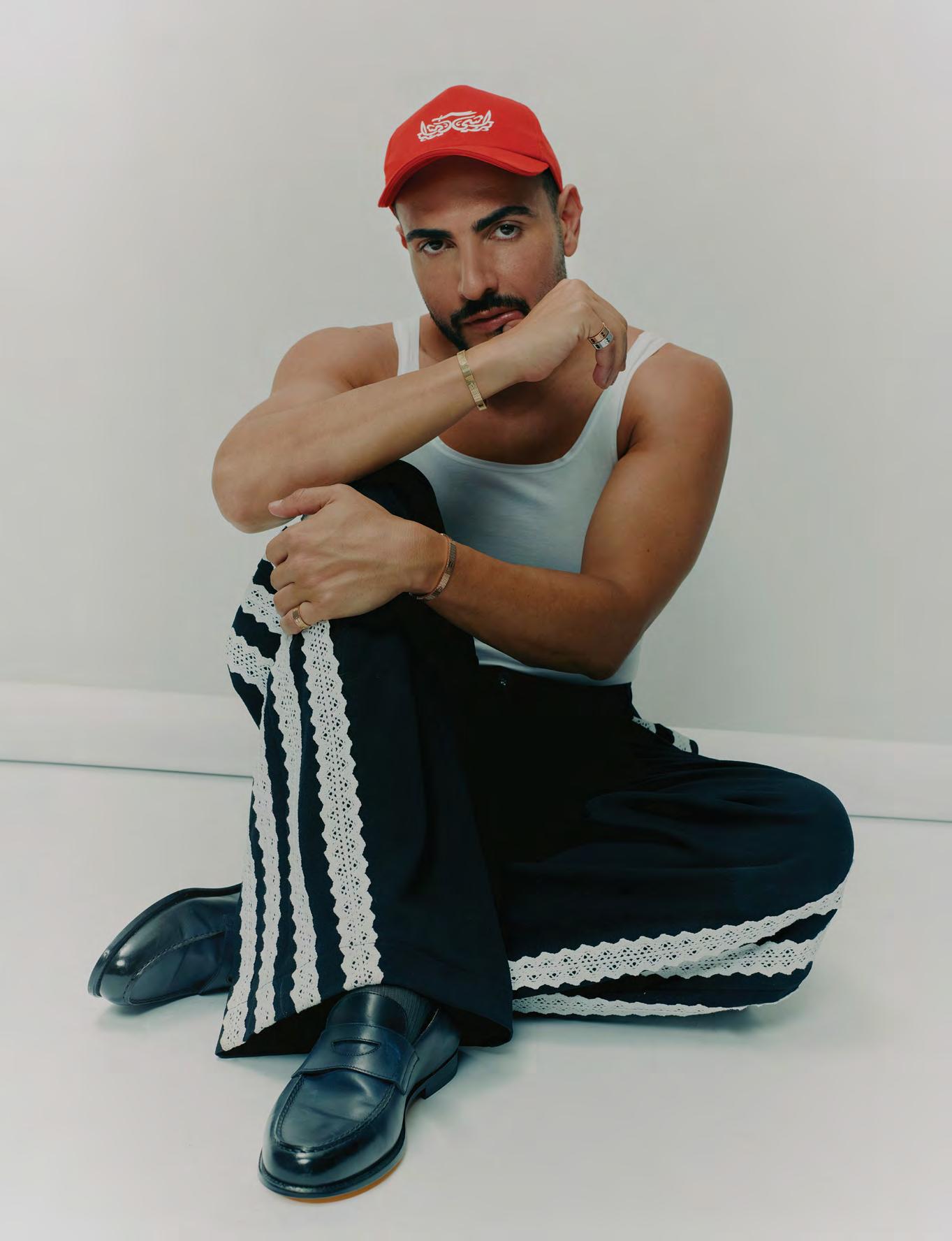

“I write a lot. Maybe 10% of what I write ends up in the songs,” Anthony Adonis says to YUNG. For him, words are sacred terrain: every Adonis song begins not with a beat or riff but with language, treated as “something delicate and sacred,” he explains. That reverence has defined the band from the very start. When Anthony and guitarist Joey Abou Jawdeh launched the band in 2011, they began quietly, almost stubbornly, remoulding the contours of Levantine pop from the inside out.
His songwriting is fundamentally word-centric as he notes, “Our music has always been about language, about the stories we tell”. He tinkers with multiple drafts on piano, revisiting verses and choruses until the phrasing lands with the right weight. But the lyrics are always the starting point, the music is the vessel, lovingly home built around each word. Over the years the band has grown “more playful” with instrumentation, he insists that “with lyrics we’ve been more rigid and careful, treating [the words] as something delicate and sacred”. Every colloquial turn-of-phrase, every lilt of dialect, is carefully crafted so that it “shines at its best in our songs” – a fitting credo for a band so deeply devoted to the nuances of Lebanese Arabic.
“With lyrics we’ve been more rigid and careful, treating [the words] as something delicate and sacred, so that it shines at its best in our songs.”
Though lyrics anchor their identity, Adonis’s sound has flowed through many styles over the years. Birthed amid Beirut’s cafés, the band’s early records wore an acoustic, folk-tinged sound, one of a generation still sketching its place. However, Anthony soon felt those four-chord indie motifs were starting to become limiting. By 2018, the band cut Nour in Beirut with producer Jamal Riachi, a record he calls “one of the milestones of our career”. That album wove in drum machines and synths for the first time, breaking out of their indie/alternative mould. He admits resisting this, fearing that to older fans they might appear to be “selling out.” In fact, he remembers clashing with producers over whether electronic elements had a place in Adonis’s music.
As Anthony puts it, the balance between the band’s organic elements (guitars, raw vocals, heartfelt lyrics) and new, structured elements “made our sound stand out.” He laughs that he finally understood what the older musicians meant when they advised openness: taking risks and embracing new tools is simply part of growing up as an artist.
“Sometimes
you live life in its best and most beautiful moments. And then the second day… an explosion could rip your house apart. The city is always, for better or worse, a theatre of surprises, something that has taught me to keep steady so that you don’t crumble if it takes you in unexpected directions.”




Each subsequent release burst further into new sonic territories that they once dared not touch: 2021’s A’da flirted with R&B and retro pop sounds, and 2022’s Hadith al-Layl embraced freer, more cinematic structures. Anthony says Hadith al-Layl “took us in a completely new direction,” and that it felt “wonderful to do something very different from what people are used to getting from us”. Each record has proven that Adonis can preserve its identity even as it reaches for the unexpected.
He makes no secret of his reverence for Arabic, especially the Lebanese dialect with its vast expressive potential. And it is so easy to pick that up in the poeticism that underlies all their songs, lines that stretch and coil, spoken cadences turned melodic. He often cites Lebanese composer Ziad Rahbani as a guiding light, saying Rahbani “freed the language” from rigid rules. What a striking phrase… to free a language. In Adonis’s songs, this means using dialect as playfully and powerfully as possible. Every phrase is chosen so that the Lebanese accent truly “shines at its best” on the track. In practice, this can mean double meanings, slang turns, or poetic repetitions - treating the colloquial tongue as a musical instrument in its own right. In Anthony’s hands, everyday speech becomes luminous.
Beirut itself looms over their work as both muse and adversary. “Sometimes you live life in its best and most beautiful moments. And then the second day… an explosion could rip your house apart,” Anthony says matter-of-factly. In his words, the city is “always, for better or worse, a theatre of surprises,” something that has taught him to keep steady, “so that you don’t crumble if it takes you in unexpected directions.” This hard-earned acceptance of chaos seeps into Adonis’s art: songs about sudden loss, stubborn hope or angry outbursts that carry the imprint of Beirut’s unpredictability. The city’s rhythms remind the band members that life can change in an instant, nothing is guaranteed, and that songcraft must capture that tension without flinching.
For all his meticulous writing, Anthony knows chance plays just as big a role. He laughs recalling “La Bel Haki,” a gentle pop number from Nour they nearly buried. “La Bel Haki was always meant to be a filler track… But it just sounded so naturally soothing,” he says. When they released it anyway, a Brazilian producer snapped it up as a telenovela theme. “The song travelled to Brazil and had Portuguese versions,” he grins. Overnight, a largely unknown Arabic song won a new audience and gave Adonis unexpected credibility.
Another twist hit the song “Ma’arfha,” from their seventh studio album. Its first demo was lush and orchestral - “like these show tunes from 1980s musicals” with strings and pizzicato. Producers Nasser al-Bashir and Amr Shomali completely reimagined it: “it evolved into this kind of dark synth track,” Anthony recalls. What began as a grand ballad ended up a pulsing, modern pop song and became one of his favourites. This just goes to prove that, for Anthony and other artists, constraints and random opportunities can collide to create something new. Follow where the music leads.
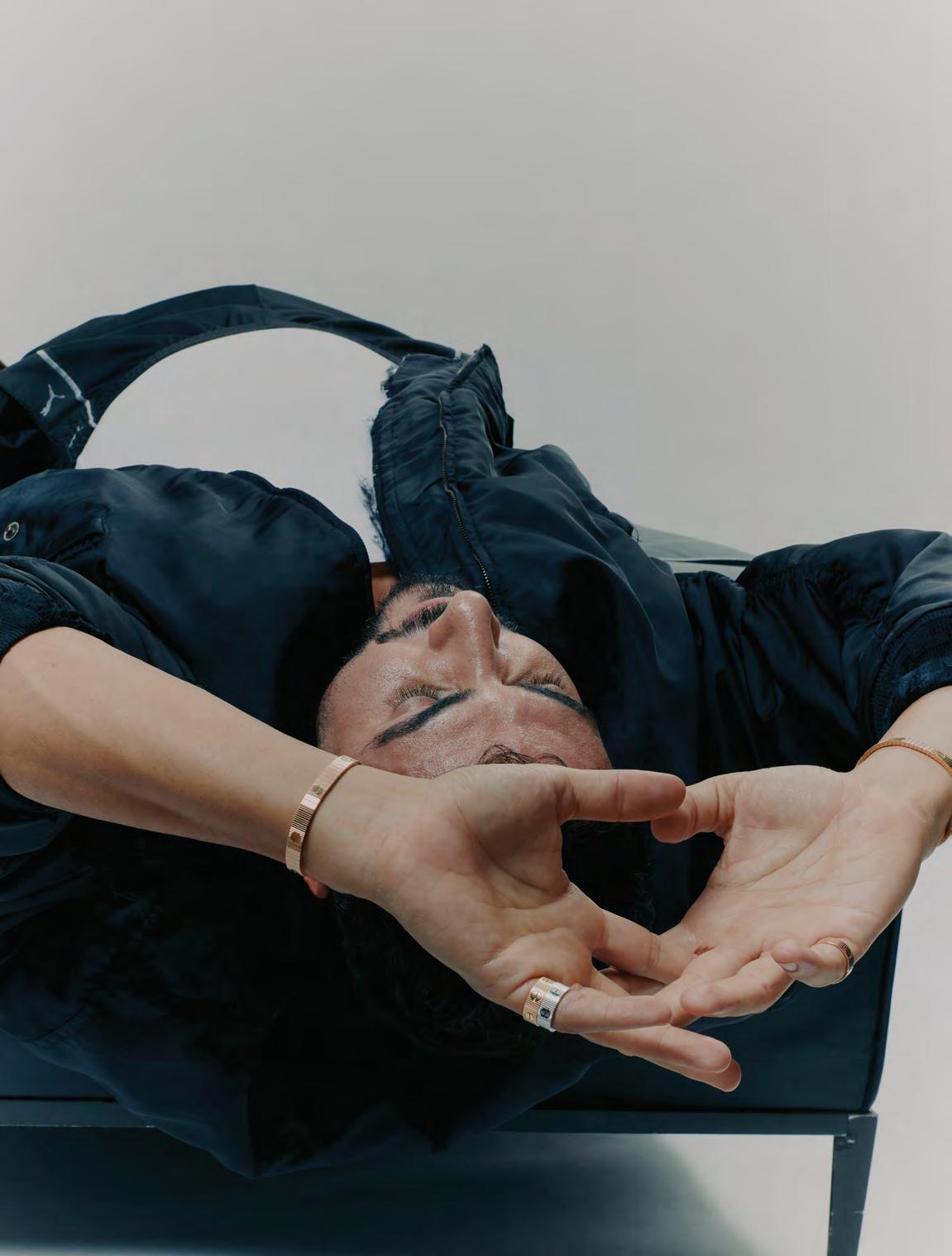


Anthony is just as fascinated by how songs escape their author’s control once released. One song from Adonis’s second album, written as a reflection on The Little Prince, has been lovingly misinterpreted by listeners. He explains that “the song is exactly telling the story of the Little Prince, from the point of view of one of the characters… I had read that book at the time while I was writing it.” Yet, he remembers a fan who sang the song to her unborn child, despite its original meaning. The artist says it was deeply moving, since “the song is about a young prince who left the world too soon,” that she reimagined it so tenderly. Her alternative meaning is “a very moving comment” that he still remembers “to this day”. Instead of correcting her, he embraces it, happy that a song could offer solace in an unexpected way.
Time has softened his once-rigid views about the craft. In his early days he thought the bare song itself was all that mattered: “I believed that the production of the song was the least important element in the making of a song,” he says with a laugh. “I would write a song on the piano… I didn’t have any interest in listening to different options of mixes.”
“These 10 years have been revolutionary… our industry is even more interesting now because it’s so prolific, so generous, so experimental.”
Back then, he thought a melody strong enough to survive on keys alone would remain intact under any treatment. In hindsight he calls that “arrogance.” Now he’s more open to experimentation. After working with different producers he acknowledges that production can add depth, even while insisting “if it’s good when you play on a piano… it means it’s a good song no matter how you dress it up”. He still writes lyrics and chords first, but today he checks on mixes, layers, and beats, anything to help a song speak.
He is also prolific, perhaps surprising even himself. He laughs that the band’s output is constant because “In my nature, I write a lot.” He describes mornings at the piano juggling three or four songs at once: writing a verse for one, a chorus for another, then switching back to a third. “I don’t know why that is,” he says, but it means the band always has a deep well of material. Most songs never get recorded, but that stream of ideas keeps the creative engine humming and prevents any sense of running out of fresh inspiration.
“I’m all for people trying the weirdest combinations, because if something new finds an audience, it shows there’s room for it.”
As he reflects on a decade of music, Anthony notices that his relationship with uncertainty has changed. Asked what 2011 Anthony would find shocking about 2025 Anthony, he pauses and then says, “How much he is at peace and at ease with everything that just comes his way.” The fires and failures of his early career once felt like crises. Now he sees each twist as a teacher. Experience has taught him, he explains, that things usually work out. He admits it’s a form of self-education: where he used to worry, now he’s comfortable with the unknown, trusting that change is part of the journey. As he puts it now, there’s a confidence in knowing that even the least likely track or the smallest creative choice can bloom into something beautiful. In the end, Anthony seems most grateful that music, like life, is never static, but always full of surprise.
Adonis did not emerge alone. Over the past decade Anthony has witnessed a flowering of experimental Arab music that he once thought impossible. He admits that years ago “the options we had were very limited.” It was a mainstream industry hungry for formulaic stars. But today he marvels: “These 10 years have been revolutionary… our industry is even more interesting… because it’s so prolific, so generous, so experimental”. New artists mix Arabic lyrics with hip-hop, R&B, electronic and jazz in daring ways. He applauds it: he’s “all for people trying the weirdest combinations”, believing that if something new finds an audience, it shows there’s room for it. In this vibrant scene, Adonis both contributes to and benefits from a culture where each milestone of change simply encourages the next.
Still, the band’s durability cannot be explained by industry trends alone. What has kept Adonis together for 13 years is far less about fame than friendship and humility. “We’re friends before being bandmates,” he emphasizes. That order matters. This personal bond means creative disagreements never become fatal. They’ll argue heatedly one morning and be having dinner together by nightfall. Even line-up changes were smooth. When Anthony’s brother (the original bassist) left the country, Gio (a long-time collaborator) stepped in with no fuss.
Crucially, none of the members put all their eggs in one basket. “We have multiple careers,” he points out, “so if something gets tough, it’s not life or death for any of us”. They also keep themselves in check. In his words, “we never had an issue with oversized egos,” and that humility has helped them navigate album tours and label pressures intact. Ultimately, he believes their collective writing thrives: “As four individuals, when we come together, we make something greater... we’re always better, more creative”. The band’s unity lets them take risks they couldn’t take alone.
What’s next for Adonis? By all indications the evolution continues. Their latest album, Wedyan, drifts confidently across genres and moods, yet still circles back to the lyrical core that has defined them from the beginning. As Anthony puts it, Wedyan “makes us feel that we can preserve our identity, but at the same time, we’re going in a new direction.”
After 13 years of leaning into uncertainty, that sentence might serve as the band’s motto. As Anthony says, this very long-term view “opens the possibility of another 12 years,” insisting that what matters most is keeping the work open-ended. It “means we have the possibility to continue in unexpected ways,” he says. For fans that means there’s a lot more of Anthony’s poetic Lebanese songs ahead, even if we’ll only hear the polished 10%. ■

Redefining Arab identity, Razane Jammal, wearing Cartier, moves between screen, fashion, and literature with fearless authenticity.
creative direction SAIF HIDAYAH
styling MARIA TERESA STRIPPOLI
words NADINE KAHIL


When Razane Jammal walks into a room, the atmosphere shifts. Not in the way a celebrity draws attention with careful poise, but in the way a friend bursts into a gathering, bringing energy and warmth that makes you forget you were tired a moment ago. She talks quickly, laughs easily, and is as likely to share a deeply personal memory as she is to throw in a playful joke. In her world, astrology is as real as the sun in the sky. She times haircuts with the phases of the moon, avoids big decisions during Mercury retrograde, and will happily explain the difference in influence between a new moon and a full one if you are unsure. Beneath the humour and charm is a woman who has navigated the global entertainment and fashion worlds on her own terms, with resilience and an instinct for timing that would impress even the most sceptical astrologer.
Her career has unfolded like the lunar cycle she loves. Some moments have been bright and visible, others shadowed and still, but each one has shaped her into the artist and woman she is today.
Jammal’s presence on screen is magnetic, but her journey has been anything but easy. Many, internationally, first discovered her through The Sandman on Netflix, where she plays Lyta Hall, a character in the sprawling DC Comics universe. For Jammal, it was a breakthrough not just in scale but also in the way it broke long-standing stereotypes. “My baby face often lands me in innocent roles, but I was grateful for the chance to step into a character that carried both fierceness and strength,” she says. This time, she was allowed to be layered, strong, and human. She is also, she points out with pride, the only Arab in a DC Comics production, an achievement that still feels significant in an industry where representation moves slowly.
“Everything has to come from the heart. When it does, everything aligns and all the doors open.”
For her, acting has never been just about memorizing lines and playing a part. It has been a mission to challenge how Arab women are seen on screen. As a child, she never saw anyone who looked like her in the films she loved. She dreamed of Hollywood as a place where she might fit in, only to discover later that her identity complicated that dream.
Coming from a multicultural family, her upbringing took place across Lebanon, the United States, London, France, Dubai, and Egypt. She calls herself a third culture child, belonging everywhere and nowhere at once. Casting directors in the West often said she did not look Arab enough, expecting darker skin, darker hair, and a heavy accent. In the Arab world, she was sometimes told she was too Western, her Arabic too accented. Rejections from both sides could have been discouraging, but Jammal took them as challenges.
She threw herself into mastering accents, learning not only multiple Arabic dialects but also French, British, American, and Scottish. At first, she shaped herself into what she thought others wanted her to be. Over time, she began to embrace the fact that she did not need to fit anyone’s mould. She could create her own place in the industry.
Fashion embraced her, valuing her uniqueness, while film sometimes resisted. She learned that fashion offered polish and diplomacy, while acting demanded vulnerability and rawness. For Jammal, balancing the two worlds is a constant negotiation, deciding how to be refined without losing authenticity. Jammal was appointed as Dior’s Fashion Ambassador for the Middle East in 2022 and then became the One Dior Women’s Ambassador for both fashion and beauty in 2024. She also became a Cartier ambassador for the Middle East in the same year, representing the brand in campaigns and events.



“Things happen when you least expect them. Now, I believe in love at first sight.”
Her career faced a major turning point when her mother fell ill. At the height of her momentum, Jammal chose to become her mother’s primary caretaker. “Everything happens for a reason,” she says now, with a calm certainty. That period taught her to value family over ambition, and to understand that slowing down is not the same as giving up. When her mother passed away, Jammal found comfort in knowing she had been present for every moment. That devotion is something she carries with her into every decision.
Today, Jammal’s professional life moves at high speed. In 2022, she appeared in the Pan-Arab series Thaman, the first season of The Sandman, and the action period project Kira & El Jinn. This year brought Al Qadar, filmed in Turkey, and Asad, a film with Egyptian star Mohamed Ramadan. Her role in The Sandman grew in its second season. She also became a published author with her children’s book Lulu and Blu, about a vegetarian lioness who dares to live differently. The story mirrors Jammal’s own life, finding the courage to defy expectations, embracing friendships across differences, and creating a world on her own terms. The book has been a success and will soon be integrated into schools. She is now preparing to launch a children’s app and is exploring the idea of adapting the book into an animation or audiobook.
Despite the hectic schedule, she is entering a new stage of life. At thirty-eight, she speaks openly about wanting to slow down, and perhaps to start a family. “From one country to another, I cannot sit still. Now, all I want is to rest,” she says. She is not certain where that will be, but she knows it will be somewhere in the Middle East.
Her connection to Lebanon is deep and unwavering. She describes walking through Beirut and knowing she is never truly alone. If her phone dies, ten strangers will offer her a charger. She loves sitting in a hair salon surrounded by women of all ages, exchanging stories over cups of coffee. She treasures the sense of community, which she also finds in her professional collaborations. She works only with brands and teams that align with her values. Her partnerships with Cartier and her talent agency, MAD Solutions, are built on mutual respect and genuine connection. “Everything has to come from the heart,” she says. “When it does, everything aligns and all the doors open.”
She has learned to trust in timing. Losing out on a Marvel role with director Mohamed Diab once left her in tears for days, but soon after she was cast in The Sandman, which fit her far better. “Everything meant for her happened for her. Everything meant for me happened for me,” she says of her friend who got the Marvel part.
She is convinced she is protected, perhaps by her late mother, perhaps by that belief itself. That trust has made her fearless. She no longer hides her emotions or forces herself into a polished public image all the time. Therapy has helped her understand her own protective mechanisms, regulate her nervous system, and reconnect with her inner child. She believes being Lebanese is its own kind of superpower, shaped by the traumas of political crises, wars, and economic collapse. These experiences taught her resilience, the impermanence of money and status, and the importance of savouring every moment with loved ones.

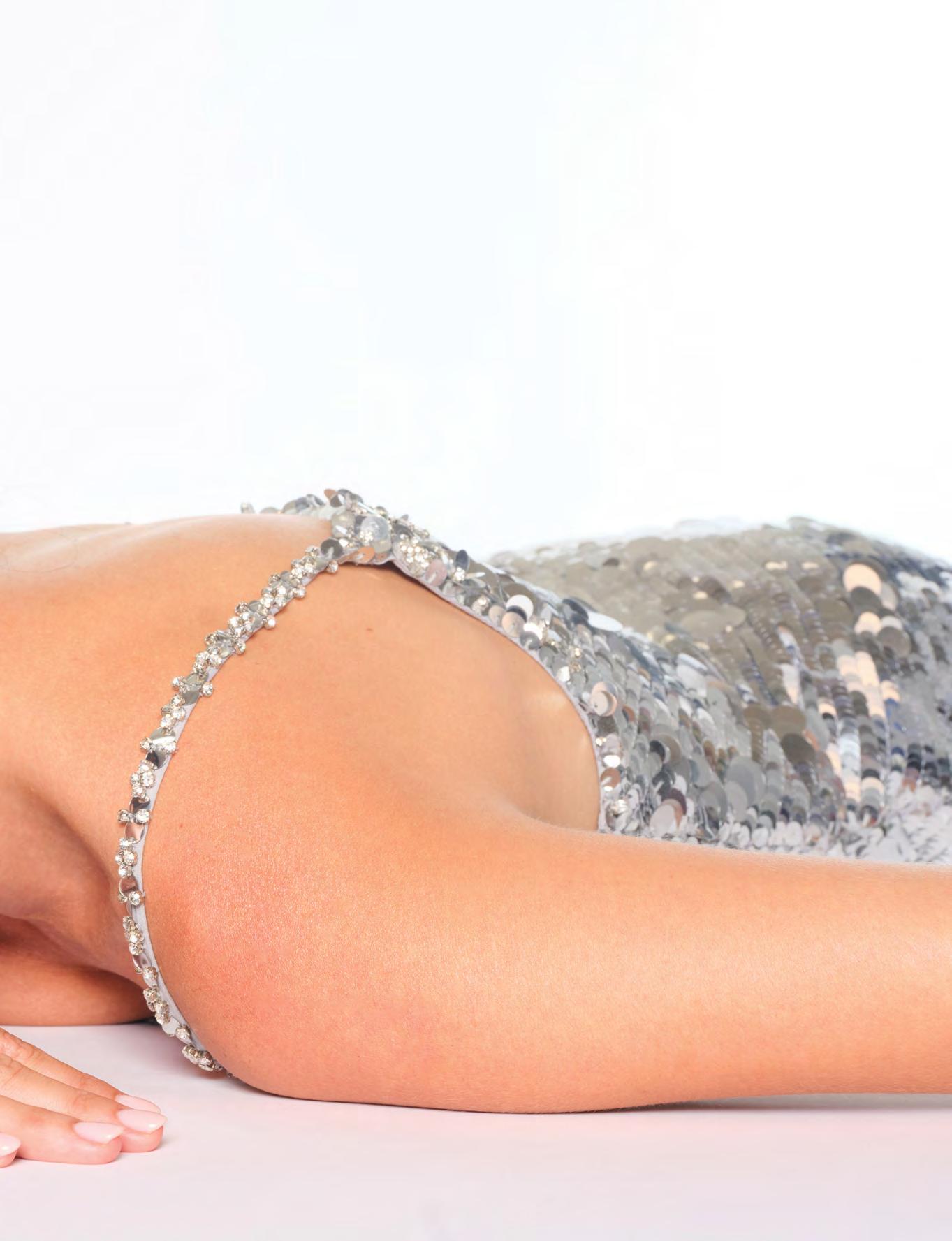
“My baby face often lands me in innocent roles, but I was grateful for the chance to step into a character that carried both fierceness and strength.”




When asked about love, Jammal expresses that she believes in love at first sight and knows through experience that everything happens when you least expect them it to.
One thing she will not do is compromise her work. She will continue to reinvent herself, to create, and to say no to projects or partnerships that do not feel right. Her art and photography, which she has never shared publicly, may one day find their audience. Her book may evolve into new forms. The important thing is that every choice remains authentic.
This clarity comes from two decades of persistence. Early in her career, she often faced dismissive questions like “What have you done?”
She worked on three projects that screened at Cannes, acted in a Golden Globe–winning series, and appeared in a Kanye West film, yet Lebanon did not embrace her immediately. Egypt did, in 2014, when she starred opposite Hend Sabry in Embratoreyet Meen, audiences responded enthusiastically. That momentum slowed when she stepped back to care for her mother, but her return has been powerful.
Her friendships are as central to her life as her work. She is fiercely loyal, the friend who shows up first in a crisis. She surrounds herself with women who inspire her and share her values. When she launched Lulu and Blu, friends offered space, catering, and design as gifts, creating an event that embodied the book’s message about finding your tribe.
She laughs about being called a diva. For her, the word means being unapologetically herself and maintaining high standards, not arrogance. Her humility comes from her parents, who were the kind of people to stop and help strangers on the road. Her siblings keep her grounded, uninterested in her fame.
Off camera, she describes herself as unhinged, funny, and unfiltered. She values privacy and resists turning her personal life into constant content. “If my selling point is my personality, then you always have to be likable,” she says. “You cannot have a down day.” She prefers to let the work speak for itself.
Jammal’s story is one of persistence, self-definition, and alignment. She grew up without a clear blueprint for the life she wanted, so she created her own. It is a story of taking risks, pausing for family, and having the courage to be seen as she truly is.
Like the heroine in her children’s book, Lulu, Jammal has stepped outside the rules of the animal kingdom. She has crossed invisible boundaries, made friends in unlikely places, and proven that the most important work is creating a world that feels true. When she says everything happens for a reason, it is not a hollow expression. It is the lived truth of a woman who has spent her life chasing the moon and, at last, finding a home beneath its light. ■
YUNG talks to two of the region’s rising stars, Stephanie Atala and Mahmoud Yassin. Adorned in Cartier, they talk about love stories, screen magic, and stepping into the past.
photography EMILY WHITE
styling POLINA SHABELNIKOVA
words MAI EL MOKADEM & MARIANA BAIÃO SANTOS



220 Youm (220 Days), now streaming on Netflix, has quickly become one of the region’s most talked-about dramas, weaving together stories of love, loss, and family across generations. In Episode 10, the spotlight shifts to Maryam’s parents, Lina and Seif, whose youthful romance unfolds in the 1980s. Played by two of the Arab world’s brightest rising stars, Stephanie Atala and Mahmoud Yassin, their story adds depth and resonance to the series’ larger narrative.
Atala steps into the role of Lina, a young woman caught between desire and duty, while Yassin portrays Seif, whose quiet resolve and emotional complexity anchor their relationship. Together, the pair bring to life a love story marked by nostalgia, tension, and vulnerability. In talking to each, they reflect on their craft, the challenges of embodying such layered characters, and the on-screen chemistry that made their collaboration unforgettable.
Here we start with Stephanie Atala:
When did you first realise you wanted to become an actress, and what was your very first role?
It happened in the strangest, most unexpected way. I was a painfully shy child, yet always mesmerised by the magic of cinema and theatre. When I was about four, I was at a restaurant where they were filming a TV commercial with another child who had a meltdown. I went over to comfort him and somehow ended up booked for the role. After that, I did several commercials as a kid.
As a teenager my shyness returned, but acting became a way to escape myself and step into other people’s lives. At university, I threw myself into theatre and short films that travelled to festivals, slowly landing bigger roles. It grew naturally from there and I’ve been in love with it ever since.
What have been the most defining moments in shaping your craft so far? Each step has shaped me, not just as an actress but as a person. That first childhood commercial showed me acting could be real. My first short film in university gave me the validation I needed to pursue it seriously. Theatre was transformative too - especially Lies and Likes, a demanding monologue about social media, and later performing for six months in a large-scale production directed by Georges Khabbaz.
On screen, Crystal was a breakthrough, airing on MBC and becoming the #1 trending show for months on Shahid, reaching millions across the Arab world. Cinema has my heart - especially Iman, which travelled to festivals worldwide, and Farah Farah, a UK-UAE co-production. This year I filmed a French series in Paris, set to premiere in 2026, it feels like a door opening to the international stage. All these moments remind me the journey is just beginning.
How do you stay creatively inspired?
By really living. As an actor, you need to keep filling your inner world to have something real to draw from. Music is always with me, sometimes I even wake up humming melodies. I watch endless films and series, always carry a book, and surround myself with creativity.
I come from a family of musicians and my husband is one too, he composes, arranges, and performs, so being around that energy keeps me inspired and ambitious. Curiosity is everything; it keeps the art alive.
With 2025 being such an active year for you, what upcoming projects or goals excite you most?
This year has been full of milestones. Personally, I got married, and having that creative partnership has completely shifted how I work. He’s my best friend and collaborator, always brainstorming with me, it makes me braver.
Professionally, I’m especially excited about the French series I shot in Paris earlier this year. Being half French, joining a purely French production meant a lot. It will air in 2026, and it feels like the beginning of a whole new chapter.


“Energy is important, but what I really try to do is leave behind a trace, something the audience remembers even when I’m no longer on screen.”
Can you describe the essence of your character in Salma and what drew you to her?
I play Mirna, and she’s a roller coaster, one of those once-in-a-lifetime roles. Honestly, I hesitated. To portray her truthfully, I dove into understanding how people with those traits think, researching paranoia and even psychopathy. She’s incredibly dark, and in our region, audiences often blur the line between actor and character. I knew people might hate her, and me.
But that fear made me say yes. I wanted to show my range, to step far outside who I am. Mirna embodies everything dark, everything I’m not, and it was liberating to dive into her completely.
What was the atmosphere like on set? Were there any moments that stood out or unexpected challenges you faced?
Shooting Salma was surprisingly light-hearted despite the heavy role. It was my second time on a long-format Turkish project, we filmed in Istanbul for nine months, so I was prepared for the pace and the feeling of living abroad. The set felt like family, especially with with Takla Chamoun and Nicolas Daniel, who played my parents. Playing someone as dark as Mirna could have been draining, so I protected my energy - always reading, listening to music, or joking with the crew between takes. That balance kept me sane through 220 days on set.
The role is intense - how did you prepare for Mirna, and has it affected how people see you in real life?
Absolutely! People often tell me I look very innocent, so being offered someone so dark was unexpected and exactly why I wanted it. With little prep time, I threw myself into the script, pushing past my limits. Experience gives you layers, and I poured all of mine into Mirna.
And yes, people see me differently now. At the airport recently, a woman walked by and said, “I hate you… why did you do that to her?” It’s strange, but also the greatest compliment, if audiences forget you’re acting, you’ve done your job!




As an actor, you need to keep filling your inner world to have something real to draw from… Curiosity is everything; it keeps the art alive.”
Your portrayal of Lina, a young Maryam’s mother in the 1980s, is central to 220 Days. How did you approach embodying both the spirit of that era and the nuances of her character?
Every role teaches me about myself. Lina was no exception, preparing for her, with director Kareem El Adl, felt like therapy. She’s calculating, impulsive, even cruel at times, the complete opposite of me.
Exploring her psyche expanded my understanding of human nature. It was a challenging but deeply rewarding process that pushed me as both an actor and a person.
Episode 10 explores Lina’s love story with Seif in a flashback. What was it like to perform those emotionally layered scenes?
It felt almost like stepping into a dream. Episode 10 had this softer, romantic tone, and the director encouraged open dialogue, which made the process very collaborative. I researched the 1980s to capture the era, and the transformation - the hair, makeup, clothes, even the vintage sets - helped me slip fully into her world.
It was rich with emotional highs and lows, and I’m grateful I got to portray such a tender chapter of her story.
This scene received a lot of attention, especially the fact that you’re singing… Tell us about that and take us into your music career, will there be one?
I loved singing ‘Ana Hawet w Entahet’ in the series! It’s such an emotional piece from an older era. The director suggested it, and it became even more special because my brother, Christian Atala, arranged it on piano and recorded it in his studio. Music has always been part of my life; I come from a musical family, and collaborating with them and my husband fills the process with joy.
The way the song was placed made the moment feel incredibly romantic, I think that’s why it touched so many people. Singing and acting are my two great loves, and yes, there’s more music coming. I’ve released a few songs, and on October 14th, I’ll release a new love song called Halat Gharam. It’s about how women love - fully, courageously, and freely - and it’s very personal to me. Going forward, I want to merge music and acting more through storytelling music videos.
— Stephanie Atala



“My view of heroism in
storytelling has evolved… Today, I find more meaning in playing characters who stumble, doubt, and even fail. That vulnerability is where true heroism lives.”
— Mahmoud Yassin
Did stepping into the role of a mother from a different generation bring any unexpected challenges or fresh inspiration?
It definitely stirred something in me. I’m not a parent yet, but playing one made me think about what kind of mother I’d want to be. It reminded me that if I ever do become one, I want to be fully ready and give the best version of myself. That role planted a seed of reflection I’ll carry with me.
What’s next for you?
Up next is a mix of everything I love: more cinema, new series, and possibly a Ramadan project if it comes together. There are international premieres ahead, especially for a French film, and plenty of travel and appearances along the way. Music will take centre stage with my new single Halat Gharam in October and quietly, I’ve been writing my own film for over a year. It’s still under wraps, but it’s finally coming to life.
And finally… would you like to collaborate with Mahmoud again in the future?
It was such a pleasure! When you’re playing a duo on screen, there’s this emotional ping-pong that only works with trust, respect, and chemistry and with you, it just felt effortless. There was this unspoken spark between us that made the scenes come alive. You’re incredibly talented and have such a bright future - I’d love to collaborate again.
And here we talk to Mahmoud Yassin:
As an actor, how do you strike a balance between trusting the director’s vision and bringing your own personal interpretation to a character, especially in a series like 220 Days?
As an actor, I’ve learned that balance comes from respect. I respect the director’s vision and trust the bigger picture they’re holding, but at the same time I don’t mute my own instincts. I like to bring pieces of myself into the role - sometimes a gesture, a silence, or even a certain rhythm - that can make the character breathe in a way only I can offer.



“When you’re playing a duo on screen, there’s this emotional ping-pong that only works with trust, respect, and chemistry — and with you, it just felt effortless.”
— Stephanie Atala
In 220 Days, your character isn’t at the centre of the story, but still contributes to its emotional tone. How do you approach smaller roles with quiet impact? For me, no role is ever “small.” In 220 Days, my character wasn’t at the centre of the story, but I knew he could carry a certain emotional tone. I approached him with care, focusing on presence and nuance. Sometimes quiet impact lingers longer with audiences than loud moments.
Do you believe that certain characters “find” you at the right moment in life? Did your role in 220 Days teach you anything you weren’t expecting to learn? I truly believe characters find you at the right moment. This role came when I needed to reconnect with stillness. It reminded me that subtlety can be powerful, and that not everything has to be spoken out loud to be deeply felt.
When you’re playing a character with limited screen time, what becomes your focus: presence, energy, or something else entirely?
With limited screen time, my focus is presence. Energy is important, yes, but what I really try to do is leave behind a trace, something the audience remembers even when I’m no longer on screen.
What’s something your character in 220 Days was carrying, emotionally or psychologically, that viewers might not catch at first glance?
What my character in 220 Days carried was a quiet loneliness. He wasn’t broken, but there was a hidden fragility beneath his surface. I don’t think every viewer catches it on first glance, but it’s there, between the lines.
Our on-screen relationship in 220 Days has a certain quiet tension, there’s warmth, but also restraint. How did you approach building that dynamic from your side, and what do you think it added to the emotional texture of the series?
Working together was about building tension without over-explaining it. We created a dynamic where warmth and restraint coexisted. That “in-between” space gave the series a tenderness that felt real - the kind of silence that speaks louder than dialogue.


“For me, no role is ever ‘small.’ Sometimes quiet impact lingers longer with audiences than loud moments.”
— Mahmoud Yassin
“Playing Lina was like stepping into a dream… rich with emotional highs and lows, and I’m grateful I got to portray such a tender chapter of her story.”
— Stephanie Atala
How has your view of “heroism” in Arab storytelling changed over the years, especially when it comes to playing male characters?
My view of heroism in Arab storytelling has evolved. For a long time, heroes were written as flawless men who never cracked. Today, I find more meaning in playing characters who stumble, doubt, and even fail. That vulnerability is where true heroism lives.
What does vulnerability look like for men in Arab media today? And is it something you feel comfortable embodying on screen?
Vulnerability for men in Arab media today is slowly becoming more accepted. To me, it doesn’t weaken a character; it humanizes him. I’m comfortable embodying that on screen, because I think audiences are hungry for truth, not perfection.
Coming from a family of storytellers, artists and huge legacies, do you ever feel the pressure to prove something new, or has your definition of success shifted with time?
Coming from a family of storytellers and artists, of course there’s pressure - but over time, my definition of success shifted. I no longer chase proving myself. I focus on telling stories that matter to me, because that’s where authenticity lives.
What’s something you’ve only recently started to understand about yourself as an artist?
Something I’ve recently understood about myself as an artist is that I don’t need to rush. Art isn’t a race. The deeper I live, the deeper my performances become.
If you weren’t in the public eye, do you think you’d still be telling stories in some way? How?
Even if I weren’t in the public eye, I’d still be telling stories. Maybe through writing, maybe through directing - because storytelling is not just a profession for me, it’s part of how I process life.
Your father left behind a powerful legacy in Arab cinema. How has that shaped the way you see this industry? Are there lessons he passed on that still guide your choices today?
My father’s legacy is a guiding force. He taught me that cinema is larger than fame - it’s about responsibility to the audience. His lessons on discipline, humility, and respect for the craft still shape every choice I make.
Streaming platforms like Shahid are bringing in new formats and new expectations. How do you see your role evolving in this changing landscape?
The Middle Eastern audience is evolving quickly, especially with platforms like Shahid changing how stories are consumed. I see my role evolving with it - embracing new formats, experimenting with fresh narratives, and staying open to ways of connecting with audiences that go beyond tradition. ■




This season is all about contrast, bold statement bags from Moschino and Louis Vuitton meet timeless icons from Céline and Chloé, making a chic return just in time for cooler days.



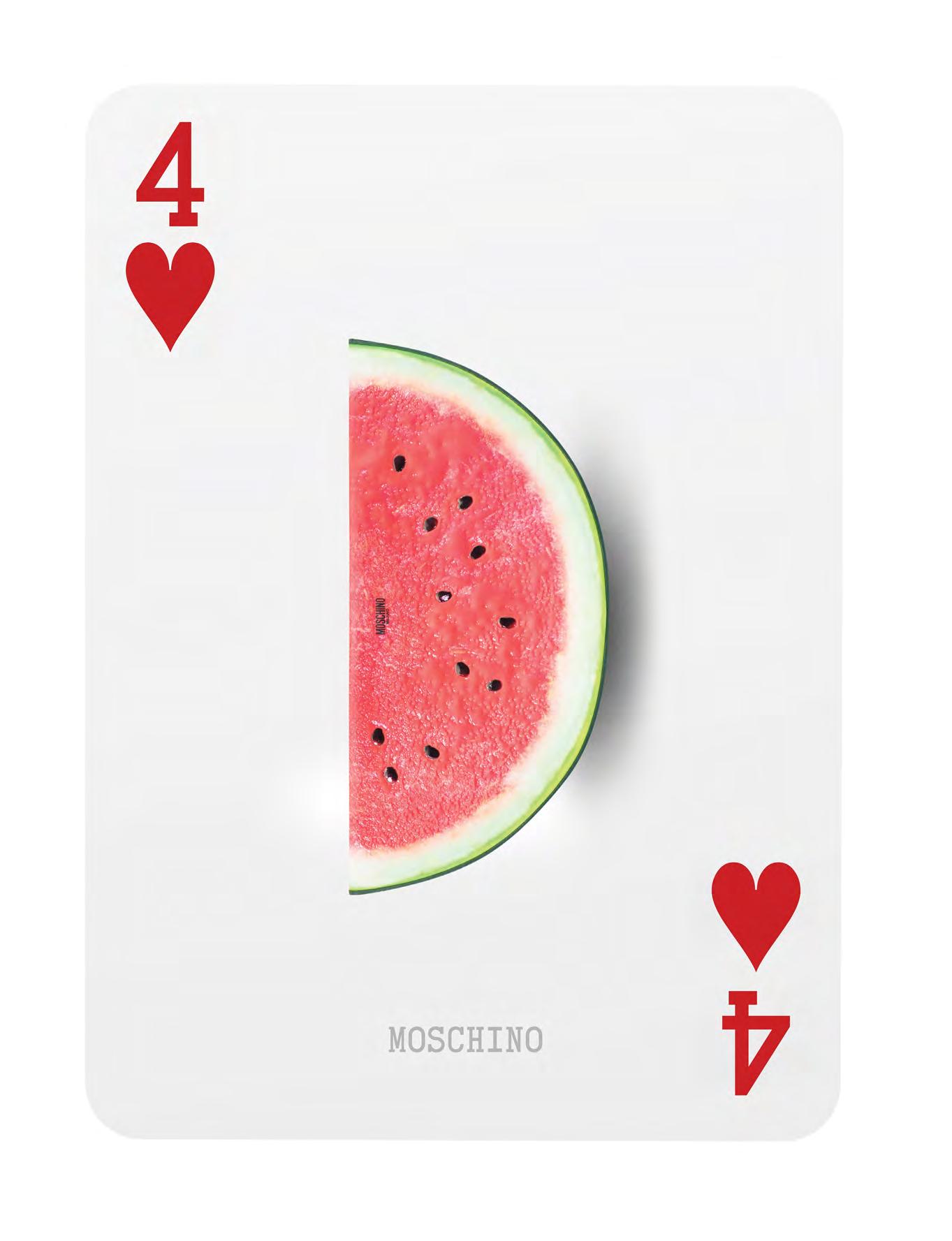
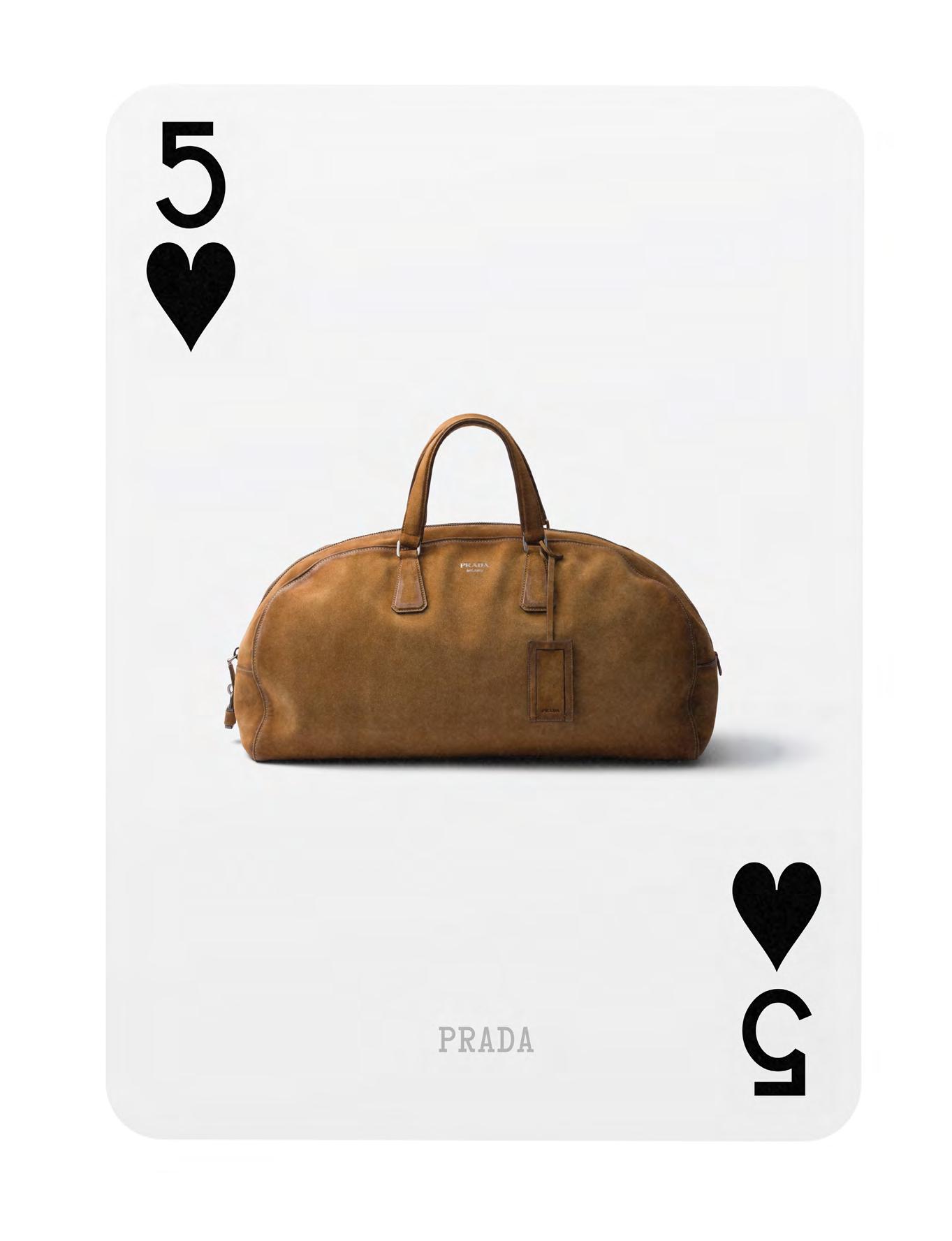


A generational dialogue between those designing as Gen Z, and those designing for it.

Fashion has always reflected the era it was born in, but what happens when an entire generation grows up in flux? Crisis layered on crisis. A million tabs open. Fashion weeks and ceasefires sharing the same timeline.
For Gen Z designers from the MENA region, and for the older designers speaking to their tastes, anxieties, and aspirations, the answer isn’t to escape reality; it’s to confront it. Between crumbling systems, algorithms, and a rising appetite for cultural reclamation, they’re building a design language that’s both personal and politically aware.
Here, we speak to seven rising designers in an exploration of what it means to design for a generation shaped by uncertainty and reinvention. Together, their responses form a mosaic of a generation that refuses to separate the aesthetic from the political, the nostalgic from the experimental, the global from the local.
There’s no single look or label that binds them. What connects them instead is a shared instinct to remix; to take what’s been handed down and turn it into something else. Something honest. Something that holds both the weight of heritage and the weirdness of now.

Amina Galal designs clothes that are about holding contradictions. “Being a Gen Z designer means refusing to separate creativity from conscience,” she says to YUNG. Born at the hinge point between the pre-digital world and the hyper-digital now, Galal’s work exists in the space between both. There’s a nostalgia in her silhouettes — for slowness, tactility, and craft — but also a sharp curiosity for the aesthetics and urgency of the present. “This in-between space deeply informs both my vision and my values,” she explains. Her collections, drawing from overlooked Egyptian traditions like crochet and tally embroidery, are never static. They’re layered, re-contextualized, and placed in conversation with streetwear, luxury codes, and youth culture. “We do not choose between tradition and modernity, we remix them,” she says.

Galal is clear-eyed about the politics of fashion. “Inclusivity is not a buzzword for me, it is personal,” she says. Her brand honours the work of Egyptian craftswomen by inscribing their names on the labels — a small but powerful act of visibility and acknowledgment. “Generations before us were hyper globalized, it was the rise of Americana, and they fully lived inside that dream. Gen Z, on the other hand, has realized there is uniqueness and beauty in reclaiming our origins.”
Even her approach to digital culture is layered. Though she admits she’s more inward than algorithmically inclined, she sees platforms like Instagram and TikTok as tools for translation. “It forces me to translate something personal into a language that can resonate universally.”
When asked what Gen Z really wants from fashion, Galal doesn’t hesitate: “Gen Z wants honesty.” For her, fashion is less about glossy campaigns and more about memory, resistance, and belonging. “We want clothes that tell us where they come from, who made them, and why they matter… Fashion that speaks honestly, that carries memory, that creates dialogue, and that dares to tell the truth about who we are and where we come from.”

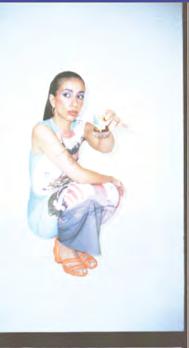


For Elissar El Hammoud, fashion isn’t a job description or a generational tagline. “I’ve never really thought of myself specifically as a Gen Z designer,” she tells YUNG. “I just happen to be Gen Z, and I like designing and making clothes.” That clarity, casual, but firm, sums up her ethos. She’s not trying to fit into fashion’s legacy systems, and she’s definitely not trying to romanticize burnout in the name of creativity. “I don’t think the traditional fashion calendar is relevant to my process,” she explains. “And I also don’t agree with the idea of overworking yourself, exploiting others, or draining resources just to create.”
For the founder and creative director, design is intuitive. Honest. Sometimes slow. “If I’m not feeling inspired to make a new collection, then I simply won’t. Forcing creativity doesn’t make sense to me because nothing good comes from it.” Her rejection of the hyper-competitive grind comes from a real place — “I thought that meant I’d never find my way into fashion,” she says — but over time, she’s carved a space that feels true to her own pace, her own values.
That same honesty extends to how she sees the role of fashion today. “Clothes used to be an extension of yourself, reflecting your values and interests,” she says. “Now it often feels like people are just copying Pinterest mood boards without really understanding the subcultures or context behind trends.” Inspired by Lebanese and Palestinian life, her pieces feature symbolic prints, narrative photo transfers, and references that resist trend-chasing in favour of personal truth. “This brand is and will always be political. It was born out of my own process of trying to understand my identity and searching for the kind of representation I felt was missing for an Arab woman like me.”
As for the conversation around community, she’s sceptical of how easily it’s commodified. “There’s definitely a need for community, but sometimes people confuse that with just buying into capitalism,” she explains. “A community is more than a T-shirt with a logo.” While she loves the joy of recognising a piece out in the world — that subtle ‘we get it’ connection — she also sees the pressure to stand out, perform difference, and skip the storytelling. “Fashion used to be about creating a feeling, an art form,” she says. “You valued each piece, and it became part of your life’s journey… like your mum would wear a coat for twenty or thirty years and then pass it on to her daughter.”
Still, she acknowledges the paradox of social media: how doomscrolling becomes both inspiration and burnout. “It’s wild to think my designs have been places I haven’t even seen… but posting often feels overwhelming.” Her hope? To keep exploring how to tell her story with clarity and care, even in a world that demands constant output.


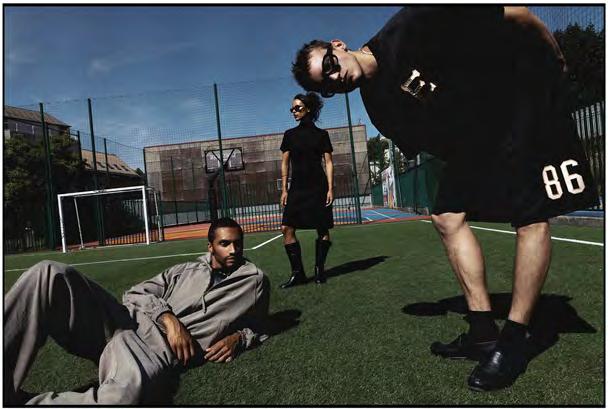
To speak Gen Z’s language, language without losing your own—that’s the tightrope co-founder and CEO Fahad Aljomiah walks at his brand. “We treat Gen Z less as a target and more as collaborators,” he says, explaining how everything from short-form videos to live pop-up feedback informs the direction of each drop. Flowered in Saudi culture but globally tuned, the brand’s identity doesn’t lean into either-or. “Heritage is our base layer; trend is the dialogue,” Aljomiah adds. Whether referencing home through motifs and casting, or distilling Parisian streetwear codes into Saudi silhouettes, the result is a label that feels as intentional in Riyadh as it does on Rue Saint-Honoré.
However, that fusion is never empty aestheticism. “Representation sits upstream of the product,” he notes, pointing to inclusive sizing, styling, and storytelling that puts identity before product. Every hoodie, tee, and accessory is a vehicle for visibility. “For us, the ‘statement’ is baked into the clothes: conversation-starting pieces that let different identities show up and be seen,” he tells us. “Originality, individuality, and culturally charged style have defined us since launch.”
Even digital isn’t just a marketing tool here; it’s part of the design feedback loop. “The goal is visibility and authenticity,” Aljomiah explains, always pulling back to one central idea: Saudi creativity belongs in every room, without compromise.



The Algerian designer behind Eargrillz is less interested in heritage and more drawn to hyperspecificity: your ear, your story, your choices. “I don’t sit down with cultural heritage on my desk,” Yacine Hamdani says. “I start clean.” His custom ear pieces are sculpted using moulds of the wearer’s ear, then brought to life with 3D printing, metalwork, and a finish of futuristic intimacy. “Being a Gen Z designer means I let technology lead and design follows.” In one piece, a client found a symbol of healing after hearing loss. In another, it’s simply a look no one else could wear — or pull off. “Heritage shows up in my work, but only through the subconscious and never forced,” he explains.
Hamdani avoids global trends entirely, and nor does he drape himself in the codes of the past. “My vision is for Eargrillz to feel like an extension of someone’s imagination, almost like plugging into their dreams to create the piece they always wanted.” Instead, he sees digital culture as a feedback loop for energy: “The audience is not passive… they push the energy forward.” Even the technology that enables Eargrillz shapes the final design. “I don’t fight the machine,” he adds. “I work with it.” In an industry built on mass, Eargrillz offers the opposite: singularity.
So if Gen Z’s fashion wish is total freedom, could custom be the most radical answer? “If I could, I would step away completely and let the customer and the machines create something beautiful. What Gen Z wants from fashion is freedom, and at Eargrillz that is exactly what we give them,” he concludes.


“What Gen Z truly wants is to wear their identity. Wearing something that touches you — that gets you — becomes a way of speaking back to the world”
-Jomana Elbendary
69-R7r7a feels like it was built in protest of trends. Founded by Yossef Gamal and Jomana Elbendary, the Cairo-based label is about unravelling the noise of modern life and rethreading it into something meaningful. “The internet has made everything move too fast,” Gamal says. “There’s chaos, moral disparity, and a kind of collective memory loss.” Their work doesn’t try to tidy that mess up; it channels it into their upcycling.
Each piece is made from reclaimed materials, warped into something intentionally out of place. “We’re not here to mimic what’s trending globally,” Elbendary comments. “We have our own path.” That path involves handcrafting one-of-one garments that speak more like sculptures than fashion. Nothing is mass, and every item — from patchworked silhouettes to cryptic text details — carries that signature R7r7a spirit: raw, resistant, and restless.
For Gen Z, this sense of rawness feels like truth. “Gen Z is probably the most self-aware generation,” says Gamal. “When a piece reflects that — when it feels like it understands them — they wear it as a kind of mirror.”
“What Gen Z truly wants is to wear their identity. Wearing something that touches you — that gets you — becomes a way of speaking back to the world,” Elbendary adds. In that sense, 69-R7r7a is giving Gen Z the tools to say something with their clothes, even if no one else understands the language yet. ■ 69-R7r7a
When the city shut down, the night turned up. Shot against the chaos of London’s transport strikes, this editorial dives headfirst into the intensity of nightlife, the sweat, the stares, the grit that makes the scene feel alive. Raw bodies, real moments, fashion unfiltered. Because in this world, the show doesn’t stop, it just finds another stage.





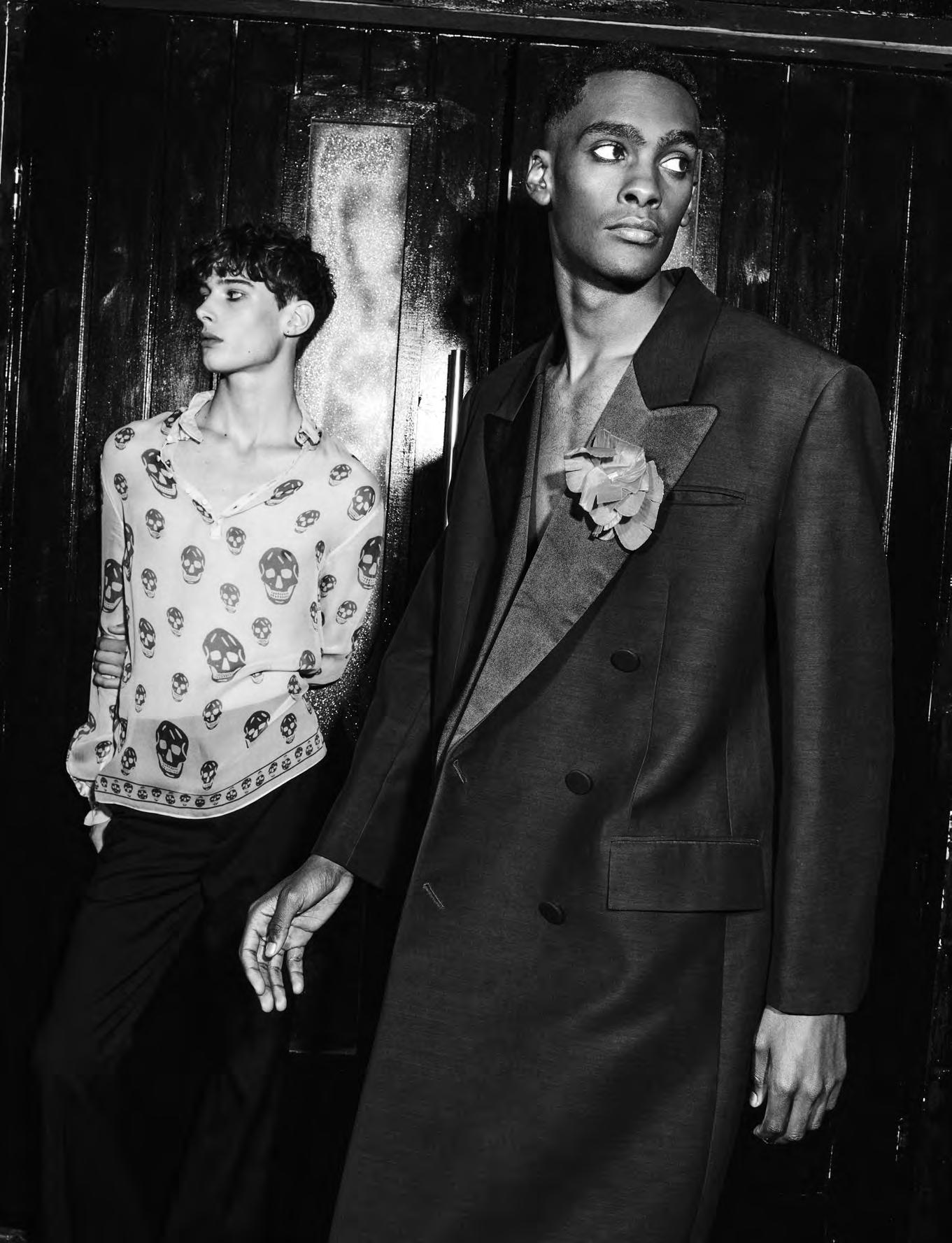
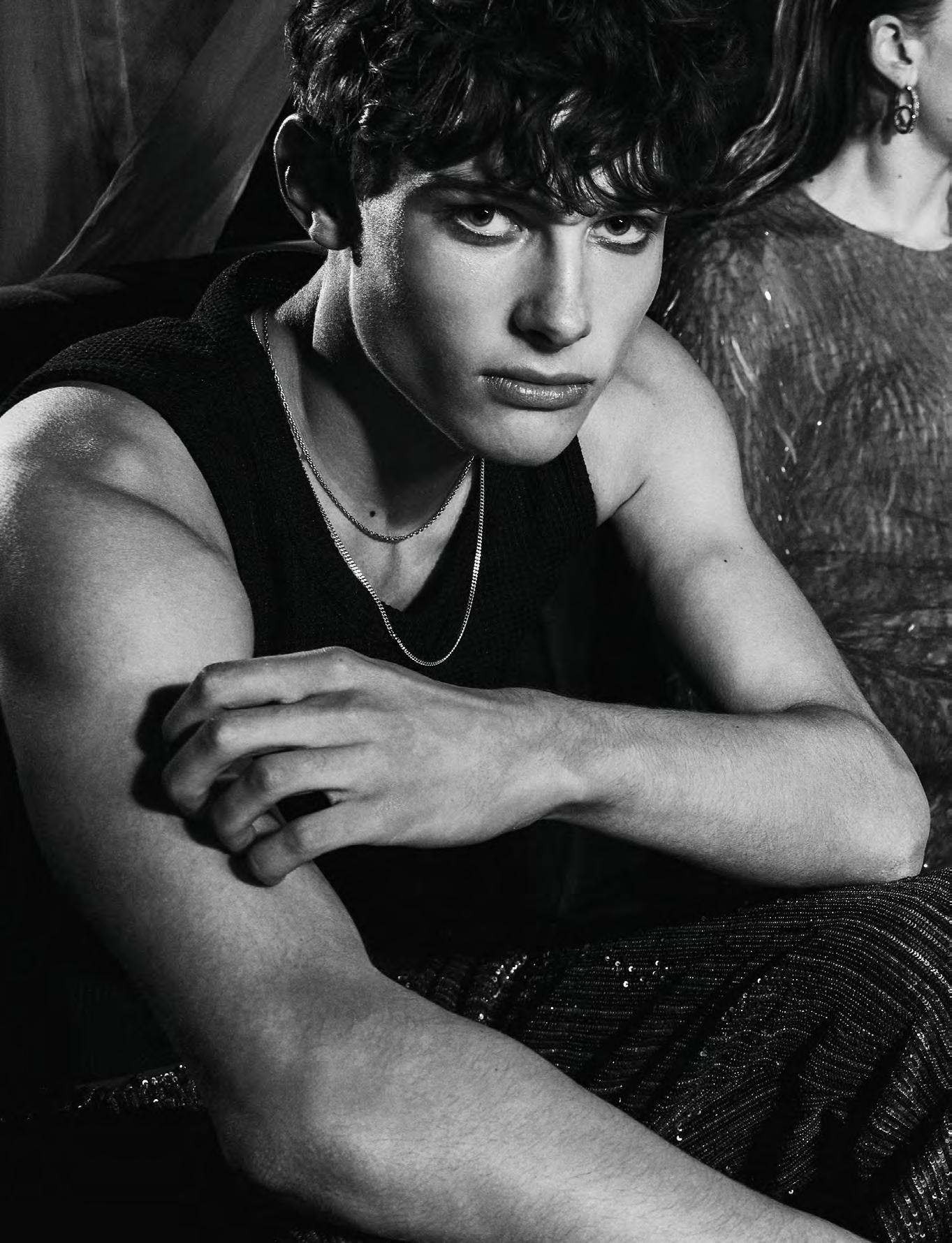



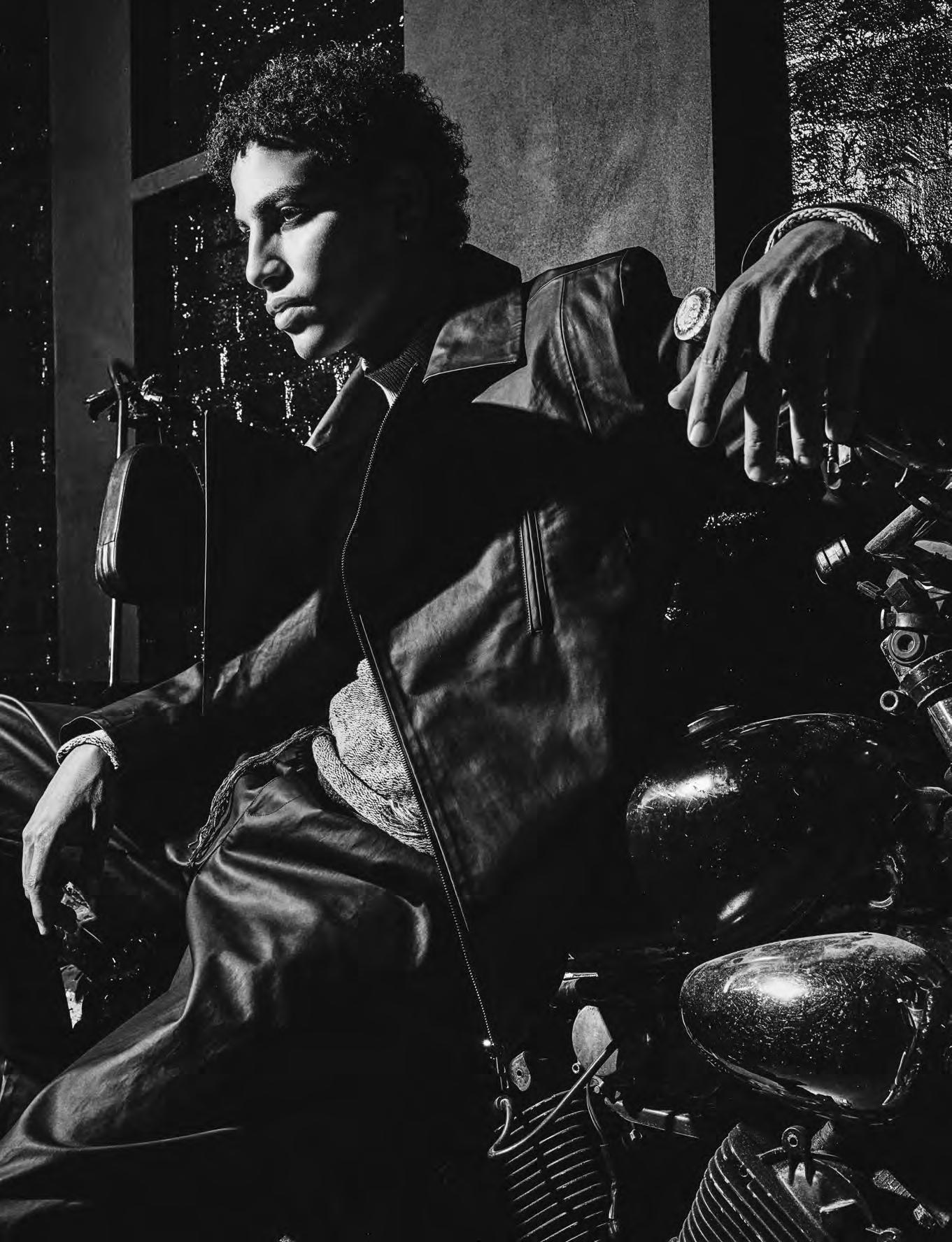
On TikTok, the “10k Step Shoe” is rewriting what it means to be stylish, one blister test at a time.
words MARIANA BAIÃO SANTOS
Forget stilettos! The new city-girl flex is a shoe that can survive 10,000 steps and still look good in a mirror selfie. On TikTok, girls from London to New York to Copenhagen are clocking their mileage and dragging their shoes along for the ride, turning sidewalks into runways and podiatry tests in one. The so-called “10k Step Shoe” has become the ultimate litmus test: if it can’t handle a day in the city, it doesn’t deserve priority in your wardrobe.
TikTok has become the testing ground for every kind of city-girl shoe, from flats to clogs, kitten heels to trainers. The question isn’t “Is it pretty?”, but “Will it survive the mileage in style?” Clips show girls in Copenhagen striding in ballet flats, Londoners pacing in loafers, New Yorkers daring to take a kitten heel across downtown. The reviews are equal parts chic and chaotic: blisters, durability, and whether a shoe still feels chic after hour five.
What makes the 10k Step Shoe so addictive to watch is its mix of fantasy, reality and true recommendations. Shoes that look effortless on Instagram suddenly face the brutality of subway stairs, cobblestones, and long commutes. It’s proof that the new city uniform isn’t about what you wear to dinner, but what can actually keep up with your life.
These are the shoes doing the rounds on TikTok as the stars of the urban mile. From split-toe curiosities to floral-drenched collabs, they’re the kind of footwear that looks runway-ready but lives for the pavement. Let’s break down what each pairs signals in the city-girl universe:


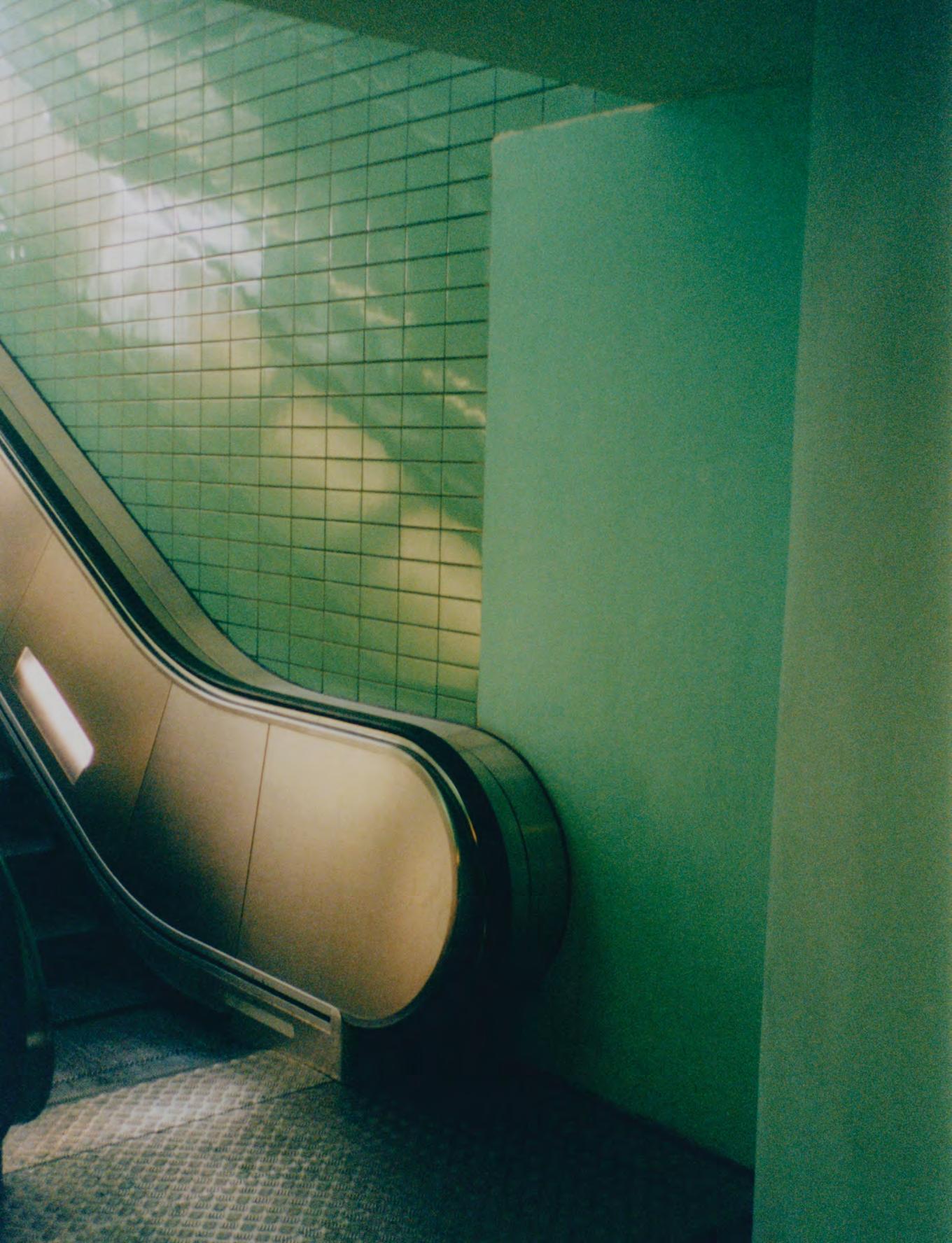





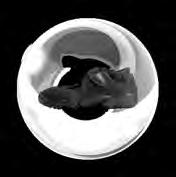

Miu Miu’s boat-loafer hybrids, like their leather-bleached, collegiate-inspired designs, offer vintage texture with slip-resistant soles that breeze through drizzle and metros alike. They elevate commuter chic with their blend of practicality and fashion pedigree, these definitely make a statement.
Whether it’s their ballet-inspired Mary Jane (Runway Ballet) or leather flats, Tory Burch brings polished ease to high-step-count days. The pliable leather moulds to your foot, while details like straps keep them camera-ready on park benches and crosswalks. Editors also applaud their durability for the streets, even in slick urban commutes.
The limited-edition Asics collaborations layered over runner-friendly GEL-Terrain bases are where function met couture. With ripstop mesh and romantic 3D floral appliqués, they bring a dose of fairy-tale femininity to every gritty cobblestone strut. It’s fashion-forward cushioning and yes, TikTok can’t scroll past them.
Iconic and divisive in equal measure, the split-toe Tabi continues to intrigue, think hoof-shaped avant-garde mischief that started in ’89 and refuses to fade. When Rihanna steps out in them, pyjamas and all, you know they’ve elevated from cult oddity to TikTok trend royalty.
Comfort icons, reinvented for autumn: thick yet chill, made from premium materials like suede, wool felt, and cork footbeds that practically hug your arches. Editors now style them with chunky socks, plaid suits, and cardio-chic sensibility, turning the once-granola sandal into street-style armour.
Part sock, part shoe, all balance. With its split-toe design and airy, adjustable straps, the Air Rift simulates barefoot freedom while cushioning every sidewalk sprint with trademark Nike Air tech. It’s an ergonomic city staple that’s equal parts wearable and weird, in the best way possible.
Built for both pavement and backroads, the Ecco BIOM C-Trail is your waterproof partner in crime. GORE-TEX lining keeps city rain at bay, while the BIOM Natural Motion footbed and grippy rubber outsole ensure you stay grounded and fresh no matter how many miles you log.
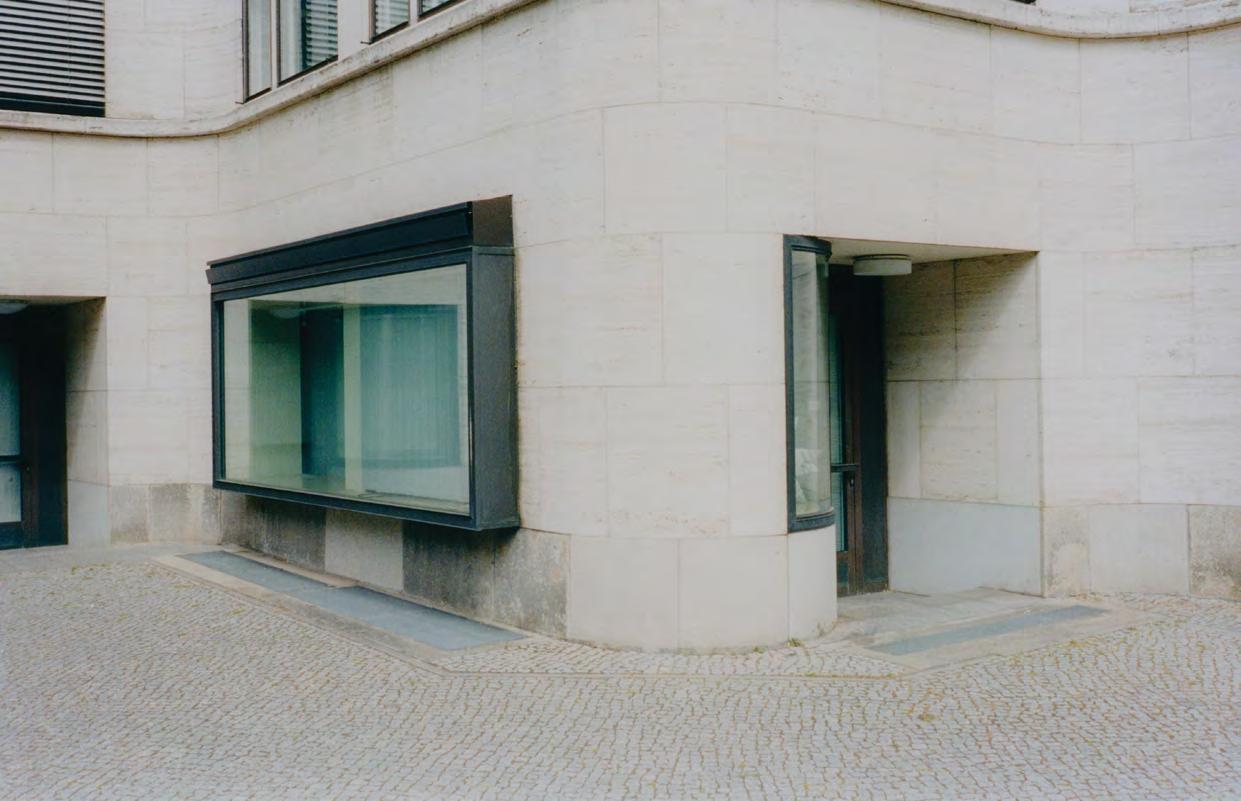
What makes the 10k Step Shoe so fascinating is that it’s never just about footwear. It’s a shorthand for identity: are you a Birkenstock realist, a Tabi provocateur, a Tory Burch traditionalist, or a Cecilie Bahnsen dreamer? In the TikTok era, the shoes you walk in say as much about you as the bag you carry or the coffee order in your hand.
Wellness culture has also slipped quietly into the wardrobe. Hitting 10,000 steps used to be something your Fitbit nagged you about; now it’s a fashion statement. Comfort is chic, practicality is aspirational, and the “daily walk” has become a lifestyle category in itself.
Walking, too, has turned into a kind of luxury. To live in a city where you can walk everywhere, to own the right shoes for the mileage, to curate your steps like you curate your outfits, it’s urban privilege disguised as health-conscious living.
In the end, the 10k Step Shoe isn’t really about the number, it’s about rejecting shoes that only look good standing still. Comfort has become chic, practicality aspirational. The shoes that survive 10,000 steps aren’t badges of performative wellness, but declarations of how women actually live in their cities. They’re proof that endurance and ease are the new markers of style. ■


photography EMILY WHITE
styling MONTY COOKE

Autumn/Winter 2025 reimagines the Visetos monogram through cosmic palettes, bold textures, and a fusion of heritage and futurism.




MCM charts the next phase of its cosmic odyssey with Chapter III of From Munich to Mars, a visionary Autumn/Winter 2025 collection that reimagines heritage through the prism of retro-futurism. Designed for Mavericks in perpetual motion, this latest instalment fuses cyber-galactic fantasy with the meticulous craftsmanship of the brand’s Munich roots, striking a delicate balance between timeless artistry and future-forward design.
At its core, the collection revolves around MCM’s iconic Visetos monogram, boldly reinterpreted in vibrant palettes, experimental textures, and consciously sourced materials. The journey unfolds across three chromatic ‘movements’: deep-sea blues evoking the endless expanse of the cosmos; grounded khakis that pay homage to Earth’s raw terrains; and a luminous, celestial finale that returns to the brand’s signature cognac hues.
Silhouettes expand, utility is reimagined, and classic motifs are reshaped, offering a wardrobe for modern explorers moving seamlessly between the tangible and the virtual. MCM doesn’t just look to the stars; it captures the spirit of a future already unfolding. ■






Joe Chalita traces Lebanon’s journey from Phoenician textiles to modern couture, urging a new generation to rediscover its roots.


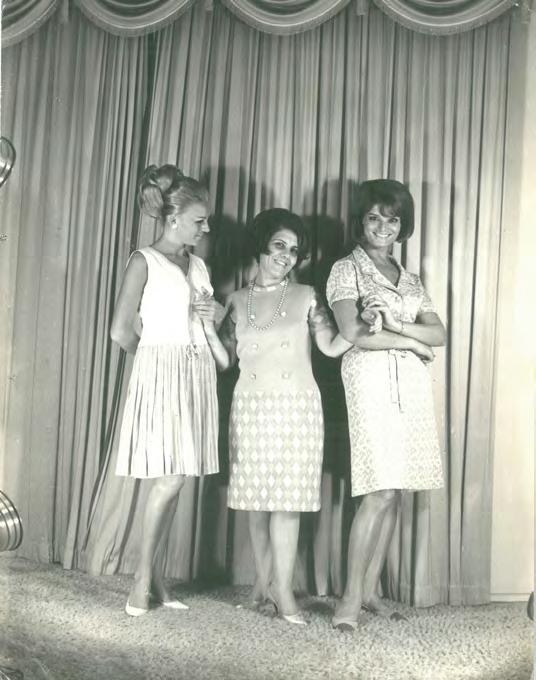
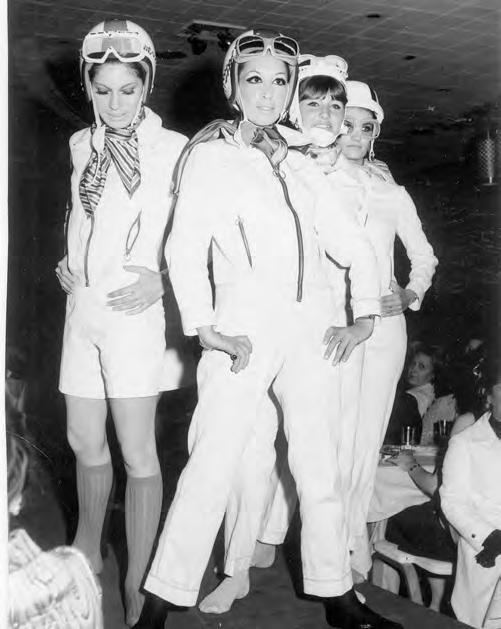

Fashion in Lebanon is often associated with the dazzling red-carpet gowns of international stars, yet behind this contemporary success lies a far deeper story, one rooted in thousands of years of heritage, craftsmanship, and cultural exchange. Few voices have worked as tirelessly to uncover and preserve this history as Joe Chalita, who began his career far from the ateliers of Beirut. Trained first as a solicitor in Sydney, Chalita eventually turned to fashion, where an early mentorship with Elie Saab set him on a path that would bridge personal identity with national legacy. Since launching his own label, his work has evolved beyond couture into a broader mission: to document, archive, and celebrate Lebanese fashion’s forgotten narratives. Here, Chalita reflects on the evolution of Lebanese fashion, its unique East-West identity, and the urgent need to safeguard a heritage at risk of being lost.
Can you tell us about your journey into fashion and what inspired you to focus on Lebanese design?
Although I studied law and became a qualified solicitor in Sydney, I was raised in an artistic household thanks to my mother, who inspired me from childhood. Creativity was always a part of me, but I chose to pursue law first. After becoming a lawyer, I returned to college to study fashion in Sydney. In 2007, I was selected as a candidate on the TV show Mission Fashion under the guidance of Elie Saab. I was flown from Sydney to Beirut to participate, and Elie Saab himself announced that I was his favourite and extended an invitation for me to join his design team.
I launched my own label in 2009 and worked as a couturier between Sydney and Beirut. Being born and raised in Australia gave me a sense of nostalgia for my roots, and I became increasingly curious about my heritage. My trips back and forth to Lebanon growing up deepened my attachment to my Mediterranean identity. I was fascinated by Lebanon’s geography, ancient history, and cosmopolitan culture, which felt so rich compared to the life I knew in Australia.
What motivated you to start documenting or exploring Lebanese fashion history? Was there a particular moment, event, or influence that sparked this interest?
I began questioning our fashion identity, our heritage, and our folklore, which played little to no role in our daily lives. We don’t know much about it, and that absence made me want to dig deeper. I wanted to discover and revive our fashion heritage, and that search became the starting point of my journey. Since the Lebanese Civil War of the 1970s, there has been a lack of initiatives to preserve and archive Lebanon’s fashion history, despite its richness, uniqueness in the region, and global connections. Much of Lebanon’s traditional artisanal work and craftsmanship are now on the verge of extinction, if not already lost. This unfortunate reality created in me an urgency to start researching our fashion heritage, including clothing traditions, artisanal practices, and the individuals who shaped the industry in the past but were rarely, if ever, credited.
How would you describe the evolution of Lebanese fashion from the early years to today? What are some key milestones or changes you’ve witnessed? Lebanon has been a vital player in the history of fashion since antiquity. This is rare — not many countries can trace such profound contributions back to ancient times. As Phoenicians, we gave the world the gift of purple dye, which became the colour of royalty. That was the start of our fashion legacy. In the modern era, Lebanon kept pace with the rest of the world. The 1920s saw the rise of couture houses in Beirut, with Frenchstyle ateliers opening and Madame Djenny, of Russian heritage, becoming the first couturière in Beirut. In the 1950s, names such as Madame Salha, who gained recognition in Parisian social circles — and Joseph Harouni helped shape the local scene.
The 1960s marked Lebanon’s golden era on many levels. International models of Lebanese origin such as Andrée Acouri and Mona Ross rose to fame, walking for houses like Dior, Balmain, Yves Saint Laurent, and Nina Ricci. The 1970s introduced avant-garde designers like Jacques Cassia, who brought bold experimentation to Lebanese fashion.
The pre-war era was vibrant and sophisticated, positioning Lebanon as a true fashion capital of the region. This weight of history is the foundation on which our contemporary international designers, who now dominate red carpets around the world, continue to build.
“As Phoenicians, we gave the world the gift of purple dye, that was the start of our fashion legacy.”
How do you see Lebanese fashion balancing tradition and modernity, especially when presenting internationally?
Designers like Robert Abi Nader and Elie Saab were the first to gain international acclaim, celebrated for bringing Eastern glamour and aesthetics to Europe. Lebanese fashion quickly became synonymous with that Middle Eastern glamour.
However, today the conversation is evolving. Designers are questioning more deeply what it means to create a truly Lebanese style — not just a general “Oriental” aesthetic. My project, Lebanese Fashion History, has played a crucial role in sparking this reflection. It is the first platform dedicated to studying Lebanon’s fashion history, and it has inspired both designers and enthusiasts to explore our identity and heritage through fashion.
In your opinion, what makes Lebanese fashion unique compared to other fashion hubs in the world?
It is our geography, the meeting point between East and West. It is our history, a deeply cosmopolitan culture that has always embraced both.
Lebanese fashion reflects this duality. Our designers understand the Oriental woman, but they also understand the Occidental woman. This double embrace creates a unique synergy in our designs, one that speaks fluently to both worlds.
How has technology, social media, and the rise of digital platforms affected the fashion scene in Lebanon and the wider region?
Digital platforms have democratized fashion, giving visibility to voices and talents that might otherwise remain unseen. In Lebanon, social media has been crucial for designers to reach international audiences, especially given the lack of strong local infrastructure and institutional support. It has allowed our creativity to transcend borders, even in times of crisis.
What advice would you give to emerging designers or young creatives entering the fashion industry today?
Be sure of your fashion identity. Develop a strong brand DNA and signature style. This usually comes from within, either you have it or you don’t. Above all, it must come from passion, because passion is what sustains you in this industry.
Are there challenges or opportunities specific to Lebanese designers in the current global market?
The greatest challenges stem from Lebanon’s ongoing political and economic crises, as well as the lack of structural support for the creative industries. But nothing stops the Lebanese spirit. Our designers continue, adapt, and push forward despite the circumstances. In fact, this resilience often fuels their creativity.
Looking forward, what trends, ideas, or directions do you see shaping the future of fashion?
For Lebanese fashion, the future lies in going back to the roots, questioning our identity more deeply and finding ways to express it authentically. My platform, Lebanese Fashion History, has become a catalyst for this, stirring curiosity and inspiring designers to study our heritage more seriously. My initiatives are already playing a key role in this direction, universities and fashion colleges in Lebanon are working with me, and I am conducting workshops and lectures to ensure that students and young creatives are exposed to the richness of our fashion history. In the end, identity is everything. Fashion without identity is empty. Lebanon’s strength lies in its history, and that will continue to shape its fashion future.


I walk into the apartment where Andrée Acouri is staying and am greeted by a woman whose presence fills the room before she speaks. She is 85, yet she radiates the same poise, elegance, and quiet confidence that made her the first Lebanese model to walk the world’s most prestigious runways. She rises to greet me, her smile warm, her nails painted a delicate pink, her movements deliberate and graceful. She sits surrounded by memories: black-and-white photographs of her mid-stride on Parisian catwalks, draped in exquisite gowns, her gaze calm yet piercing. She looks at me and declares with pride, “I was the first. I am and remain the first Lebanese model.” She’s not being boastful this is simply true, the statement of someone who carved a path where none existed before.
Her career began almost by chance. In 1962, while visiting Switzerland with her sister-in-law, she was approached by a designer who recognized in her something rare, an elegance at once effortless and commanding. Soon she was working with the fashion houses that defined haute couture: Yves Saint Laurent, Dior, Chanel, Jean Patou. Most significantly, she became the fitting model and muse for Nina Ricci, a role she held for seven years. “I didn’t plan to be a model,” she tells me. “It simply happened. And when it did, I gave it everything.”
Her story cannot be separated from Lebanon’s history, for she returned home during the country’s golden age of the 1960s and 70s. Beirut then was alive with optimism, cosmopolitan energy, and a love of chicness that rivaled Paris or Rome. Acouri fit perfectly into this world, yet she gave back to it in ways that went beyond her personal fame. She transformed her apartment in Sanayeh into a school for young women who dreamed of modeling, training them in posture, movement, and above all, confidence.
Her most famous protégée was Georgina Rizk, who arrived as a shy teenager of fourteen. Under Acouri’s guidance, Rizk blossomed into a poised young woman who would go on to win Miss Lebanon in 1970 and, the following year, make history as the first, and still the only, Arab woman crowned Miss Universe. “Georgina was like a daughter to me,” Acouri recalls, her eyes glistening. “Watching her succeed, watching her carry Lebanon’s name to the world, that was one of my proudest moments.”
YUNG talks to Lebanon’s first model, Andrée Acouri, to learn about her legacy. From Paris runways to mentoring Lebanon’s first Miss Universe, Accouri continues to inspire at 85.
That belief in individuality remains her strongest conviction, and it is what makes her wary of today’s beauty culture. “Now everyone looks the same,” she says, shaking her head. “The same lips, the same eyebrows, the same poses. True beauty comes from individuality. It comes from your own personality, not from trying to be someone else.” Her words are not bitter, but weighted with the authority of someone who has witnessed beauty at its most authentic, when designers sought to highlight essence rather than erase it.
Fashion was always part of her upbringing. Her father, who worked with textiles, taught his children to identify fabrics by touch, silk, cotton, wool, linen. He stitched clothes for them himself, simple yet chic, always from the finest materials. “I was born into it in a way,” she reflects. “It was natural for me to step into that world.” That sensitivity to fabric and form made her an ideal muse for designers, someone who didn’t just wear clothes but understood them.
As our afternoon together draws to a close, she flips through her old photographs once more. In each image, she is poised and present, her elegance undimmed by time. Yet it is not the glamour of the runway that lingers. It is the way she continues to live, with humility, gratitude, and joy. “I’m still learning,” she tells me with a smile. “ I read, I walk, I keep moving. Life is beautiful when you live it with gratitude.”
Andrée Acouri’s story is not just that of a model. It is the story of a pioneer, a teacher, and a woman who opened doors for others while carrying herself with unwavering dignity. It is the story of Lebanon’s golden years, and of the elegance that survives in its people. As I leave, her words linger with me, words both timeless and urgent: “Never try to be someone else. Confidence is the most beautiful thing you can wear.” ■
photography YASMINA HILAL Styling YARA GHAOUCH
PUMA partners with YUNG STUDIO to spotlight its low-profile icons with a campaign that refuses to play by the rules. Four silhouettes: Speedcat OG, Speedcat Ballet, Mostro, and H Street, step forward not just as sneakers, but as statements.
Low Profile is more than a design code. It’s an attitude. A generation that questions, explores, and creates its own rhythm and rules finds itself mirrored in these shoes: intent over appearance, presence over conformity. They are, simply, Made Different.
Each silhouette tells its own story. The Speedcat OG is sleek precision with racing DNA. The Speedcat Ballet fuses elegance with street edge. The Mostro, with its daring profile and forward design, remains ahead of its time. The H Street strips style back to raw speed, fast, unapologetic, untamed.
This spirit comes alive through a cast of regional talents whose identities embody movement and defiance. Dany, a barber and model, pulses with unapologetic expression. Rana, a bioengineer, turns every step into a statement. Boxer Andy Charanek channels focus and fight. Kade claims individuality through presence and style. Lilia Haj, a Mayyas dancer and choreographer, transforms rhythm into her own language.
Set against raw urban backdrops, the visuals collide streetwear with elegance, heritage with edge. The campaign speaks a global language while rooted in the region’s cultural pulse, where modernity and tradition intersect. Through this lens, PUMA’s Low Profile collection reaffirms itself as more than footwear, it’s an emblem of individuality and a generation that refuses to be boxed in.
Because some things aren’t made to fit in. They’re Made Different.







Photographer Tanya Traboulsi and her endless quest for identity.


“Family images are part of who I am. They fill the silences, answer questions, and stitch together fragments of identity.”
Photography holds a singular power: it captures fleeting moments and preserves them, allowing them to linger in the memory long after they have passed. Through a single image, viewers are transported to a past they never lived, yet the past has shaped the present. A photograph can reveal the essence of an object, the quiet beauty of a transient scene, or the unguarded lives of people in their everyday worlds, transforming the ordinary into something eternal. It allows us to explore memory, heritage, and identity, offering glimpses of what might otherwise remain intangible, and giving shape to the emotions and histories that define us.
For Beirut-based photographer Tanya Traboulsi, this power has been present since her earliest memories, ever since she received her first camera and, from that moment, documenting the world around her became second nature. This habit then took form as her dedicated artistic practice, a way of exploring life, memory, and the places and people that shape her. Growing up between Lebanon and Austria, she experienced the complexity of belonging firsthand. Moving between cultures and countries left her in a constant state of questioning: where was home, and to whom did she truly belong? These early experiences of dislocation, longing, and reflection would come to define much of her work.
Returning to Beirut after years away, Traboulsi found herself drawn to the city as both subject and companion. Photographing its streets, its people, and the rhythms of daily life became a ritual, a way to impose order on chaos, to hold onto fleeting moments, and to document a Beirut that continues to evolve. Her images weave together personal memory and collective history, blending family archives with contemporary observations, creating a visual narrative that spans generations. Each photograph invites the viewer into a story, asking quiet questions; Where? What? Why? When? All this leaves space for connection, empathy, and reflection.
Traboulsi’s work is intimate yet expansive, personal yet universal. Through her lens, Beirut becomes more than a city: it is a vessel of memory, emotion, and identity. Her photographs are not only records of time and place, they are mirrors of experience, capturing the delicate interplay between past and present, self and community. It is this delicate, evocative language of photography that forms the foundation of her practice.
What first drew you to photography, and when did you realize it could become your life’s work?
I received my first camera when I was about four or five years old. From then on, I always had one with me, documenting everyday life around me. But it took me a long time to understand that photography could be more than a habit, that it could become an artistic practice and a life’s work. In my early twenties, I started spending time with photographer friends who were still studying and often asked me to model for them. That’s when the fascination really began. By my late twenties, around 2006, I found myself seriously flirting with the idea of dedicating my life to photography.
Growing up between Lebanon and Austria, how has this duality shaped your sense of belonging and identity as an artist?

Belonging has always been a complicated subject for me. Living between two countries and cultures left me in a state of constant confusion, never fully at home in either. For years, I struggled to call one place “home.” This disorientation is very present in my earlier work. My recent work, however, feels more grounded (at least to me) as if the process itself has given me clarity. Now I know that I feel closest to myself in Lebanon; it is the place where I have experienced both the greatest happiness and the deepest sadness.
“I’m a minimalist at heart. I work with one camera, one type of film, and that’s it. I’m not interested in equipment or elaborate setups.”
How did Beirut become such a central theme in your work?
I grew up in Beirut, but we left when I was seven, as the Civil War intensified. I returned thirteen years later. During those years away, I longed for Beirut like one longs for a lover - or perhaps for the feeling of belonging that only Beirut ever gave me. I would ask my mother every day when we would return, but her answers were always vague, which only deepened my anxiety. When we finally did return, I immediately began photographing - first friends, family, and daily life, then more intentionally, shaping my practice around the city. Today, photographing Beirut has become a structured ritual for me: I walk, I shoot, I develop and print in the darkroom. This rhythm gives me a sense of order in a city that can be very chaotic. The project has become a life’s work, always evolving, always growing into new chapters. I hope it will one day stand as an archive of feelings, as a record of a Beirut that continues to age and change.
Your work often explores belonging, identity, and memory. Why are these themes important to you personally?
Because I spent much of my youth searching - for where I belonged, where I came from, and why I didn’t feel at home in Austria. Memory kept me alive during those years. I clung to flashes of memory - the smell of jasmine, the sound of the sea, a handful of treasured photographs I looked at again and again. They carried me through, giving me a fragile but vital sense of home.
How do you approach blending personal family archives with your own photographs to create new narratives?
For me, the story doesn’t begin with my own photographs, it begins decades before, even before my parents met. Family images are part of who I am. They fill the silences, answer questions, and stitch together fragments of identity. When I weave them into my work, it feels like completing a puzzle that stretches across generations.




In your eyes, how does photography serve as a tool for storytelling in ways that words sometimes cannot?
Images can speak with a language all their own. Words tell one kind of story, images another, but when combined, they form entirely new narratives. A single image, or a sequence of them, leaves room for the viewer to imagine, to project, to complete the story with their own details. That openness, that freedom, is what I find so beautiful about photography.
Your series, Beirut, Recurring Dream has been shown widely across Europe and beyond. What has the response been like, and how has it evolved across different cultural contexts?
The response has been overwhelming in the most touching way. Many people have shared their own stories with me, and in those exchanges we found points of connection - sometimes through my images, sometimes through shared experiences with other photographers. I didn’t expect such warmth, such resonance. It’s humbling, and it eases some of the loneliness that often comes with this work.
You’ve published books full of your work, what made you want to create them? I’ve published three books so far, and I think of them as chapters, each representing a stage in my practice. My most recent book, A Sea Apart, is closest to my heart. For the first time, I feel I’ve found a gaze that truly belongs to me - a way of seeing that reflects back my own self.
Your first short film, Son of the Sun, recounts the Beirut port explosion. Do you see yourself continuing with moving images?
I’d love to explore filmmaking further, and I know I will eventually. For now, though, I’ve slowed my pace. The events of recent years forced me to re-centre, to look inward and re-think priorities. The idea of making another film is still there, waiting quietly in the background.
“Today, photographing Beirut has become a structured ritual for me: I walk, I shoot, I develop and print in the darkroom.”
How do you navigate the emotional weight of working with such personal and collective memories?
For me, it isn’t a burden. It’s a source of inspiration. Engaging with memory, trauma, and emotion helps me recognize my own and, in turn, grow - both personally and in my practice.
Where do you find inspiration outside of photography? And how do you know when a project is finished, especially when dealing with such recurring themes?
The sea is my refuge. It calms me, clears my mind, and gives me hope. As for projects, I don’t believe Beirut, Recurring Dream will ever truly end. I like immersing myself in one long-term work rather than scattering my attention across many. In the past too (Untitled Tracks, Lost Strange Things), I worked this way - slowly, consistently, carefully, letting things ripen in their own time. Nothing good ever comes from rushing.
There’s a striking rawness to your work. Why is that important to you, and what do you hope it conveys?
I’m a minimalist at heart. I work with one camera, one type of film, and that’s it. I’m not interested in equipment or elaborate setups. I prefer to use what I have at hand. That limitation forces me to be creative, to push against the edges of what’s possible.
Your work carries a strong sense of nostalgia and feels timeless, even in today’s modern world. How do you achieve that balance?
I think it has to do with how I see. My eyes have been trained over time to notice certain things and to filter out others. I don’t go searching. It’s more intuitive - the result is what you see in my images.
If you weren’t a photographer, what do you think you’d be doing instead? Honestly, I can’t imagine being anything else anymore. It took me many years of confusion to reach this clarity, and now I can’t picture another life.
If you could photograph anyone, living, historical, or fictional, who would it be and why?
My great-grandmother. Her face carried so many stories. She lived through so much, but she passed away when I was still very young. I never had the chance to sit with her properly, to listen, to ask questions. Photographing her would have been a way to hold on to all that history. ■



words MAI EL MOKADEM

MENART celebrates the quiet certitude of delicacy at a time when everything seems hard.

For its latest edition, MENART Fair to Paris with a theme that feels like both a poetic and a defiant gesture: The Power of Softness. At a time when headlines are dominated by conflict, division, and uncertainty, the fair offers an alternative lens, one that sees softness not as fragility, but as an act of strength, a deliberate stance of empathy in the face of hardness. MENART dares to ask, what if tenderness was our most radical act?
Founded and directed by Laure d’Hauteville, MENART remains the only European art fair dedicated entirely to modern and contemporary art from the Middle East and North Africa. d’Hauteville is a Paris-based artistic consultant whose career bridges the cultural currents of the Middle East and the West. A former cultural journalist, she has been a fixture on the international art scene since 1991, curating platforms that champion dialogue, discovery, and representation. In 1998, she founded Artuel in Beirut, the region’s first international modern and contemporary art fair, followed by initiatives like JABAL for emerging Lebanese artists, Artparis-Abu Dhabi, and the Beirut Art Fair. In 2021, she launched MENART Fair.
From October 25th to October 27th, this year’s edition deepens its mission by bringing together artists from Lebanon, Saudi Arabia, Egypt, Jordan, the UAE, Iran, Sudan, Palestine, Tunisia, and beyond, creating a nuanced portrait of a region too often reduced to geopolitical shorthand. The works on view, ranging from embroidered narratives of survival to quietly subversive performances, demonstrate that tenderness and political urgency are not opposing forces, but intertwined threads.
ness, when wielded with intention, can shape worlds. Here, we talk to Laure d’Hauteville about this year’s exhibition, themes, perception and more.

Taking place as part of Paris Art Week, MENART Fair 2025 is as much a cultural bridge as it is a curated showcase, inviting European audiences to encounter the MENA region through its own voices, textures, and emotions. In doing so, it reaffirms a truth at the heart of its theme: that soft-
This year’s theme is “The Power of Softness”, a striking contrast to the geopolitical tension we’re living through. What drew you to that concept, and how do you define “softness” in an artistic context?
In today’s world, marked by uncertainty and tension, I believe “softness” is not weakness—it is a form of strength. In an artistic context, softness means empathy, openness, and the ability to connect beyond cultural or political divides. Art has this incredible power to touch hearts gently yet profoundly, creating bridges where words fail. Through “softness,” artists can challenge rigid narratives, invite dialogue, and inspire change without aggression—like water shaping stone over time. This theme resonated with me because it reflects the inclusive, humanist spirit I want to convey through MENART Fair: a space where diverse voices meet, in peace, beauty, and respect.
MENART Fair is the only European fair dedicated to modern and contemporary MENA art. What does that responsibility mean to you—especially in a Western art landscape that often overlooks this region?
Representing MENA art in Europe is both an honour and a responsibility. Too often, this region’s artistic voices are overshadowed by political narratives. MENART Fair offers a platform where artists are seen for their creativity, diversity, and cultural depth—not just their geography. My mission is to foster recognition, dialogue, and inclusion within the Western art world, ensuring MENA artists take their rightful place on the global stage.

“In an artistic context, softness means empathy, openness, and the ability to connect beyond cultural or political divides.”
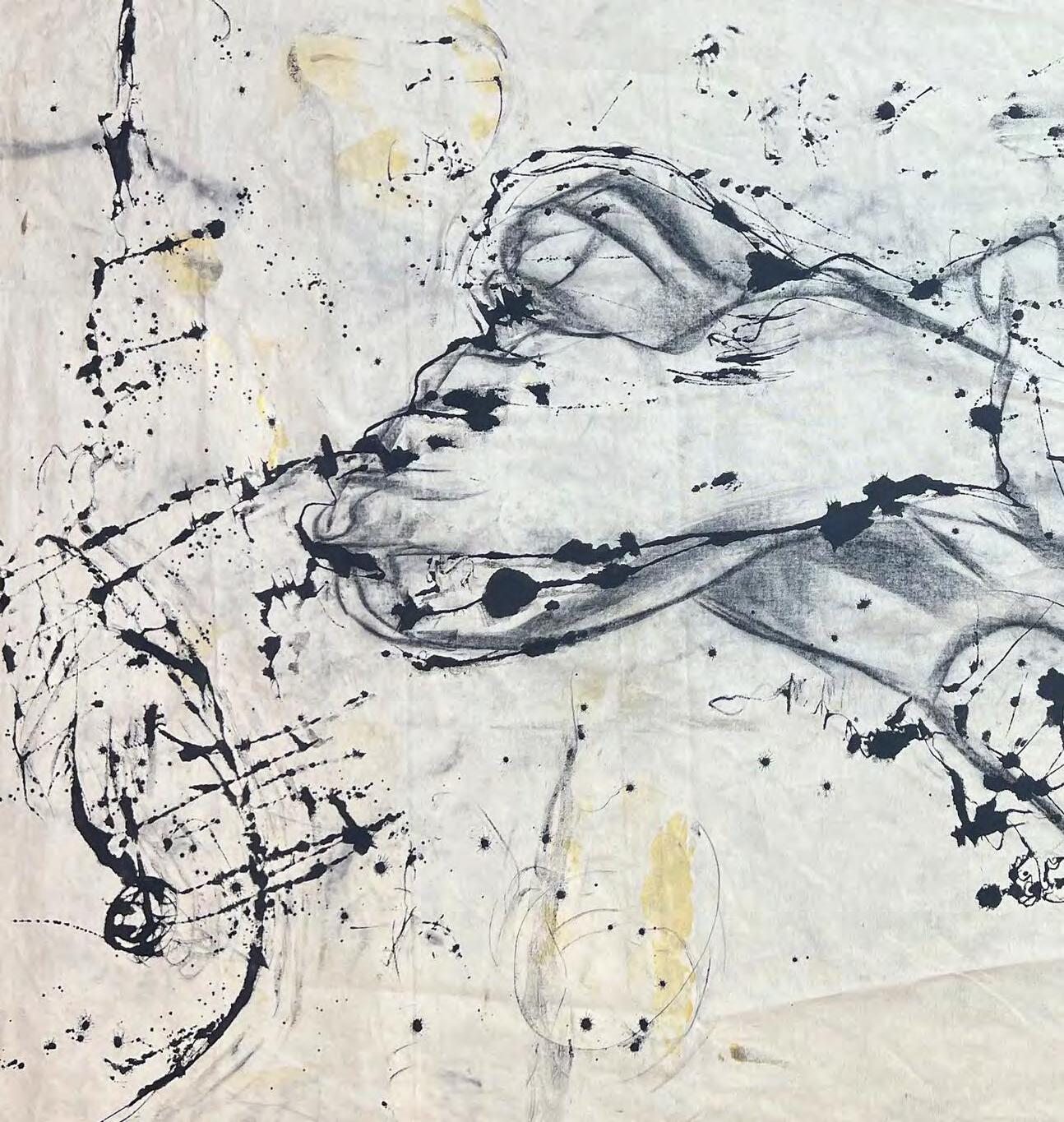

Oussamah Ghandour, Dreamer, 2017, ink and charcoal on canvas, 60 x 100 cm
You’ve described MENART as “intimate” and “approachable.” What elements of curation, artist selection, space, or programming help achieve that?
Intimacy comes from scale and intent. We keep MENART Fair human-sized, allowing real conversations between artists, collectors, and visitors. Curation is selective—each artist’s work is given space to breathe. The layout is open and welcoming, and programming mixes exhibitions, talks, and performances that invite participation. It’s about creating an atmosphere where discovery feels personal.
This year’s curation spans an emotional register, from Johanne Allard’s war-scarred textile, to Kevork Mourad’s live, cross-disciplinary monotype performance. How do you balance tenderness with political weight in the fair’s storytelling?
Art from the MENA region often carries both beauty and urgency. At MENART Fair, we don’t separate tenderness from political weight—they coexist. By placing poetic, intimate works alongside pieces addressing conflict or identity, we show the full spectrum of human experience. The balance comes from trust in the artists’ voices and from curating with empathy, allowing viewers to feel before they judge.
Was there a particular inspiration that anchored the curatorial approach for 2025?
The inspiration came from observing how many MENA artists respond to turbulence with poetry rather than anger. One moment that anchored this edition was encountering a work that blended fragile textiles with stories of migration— it was both deeply personal and universally resonant. It crystallized the idea that softness can be a deliberate, powerful stance, and guided the curatorial choices for 2025.
After last year’s bold focus on women artists, this edition continued to foreground underrepresented countries and voices. How do you ensure authentic representation rather than token inclusion?
Authenticity comes from long-standing relationships and deep knowledge of the region. I work closely with galleries, institutions, and artists to ensure their voices lead the narrative. It’s not about ticking boxes, but about showing the richness and complexity of the MENA art scene—its diversity of media, perspectives, and stories—on its own terms. Every inclusion must feel essential, not symbolic.
Gender parity is a mandatory criterion for galleries at MENART Fair. What has the response been to this curatorial standard, and has it reshaped gallery submissions or artist selections?
The response has been overwhelmingly positive. Many galleries welcomed the challenge, seeing it as an opportunity to highlight women artists who might otherwise remain in the shadows. It has encouraged more thoughtful submissions and revealed an incredible wealth of female talent across the MENA region. Rather than limiting choices, gender parity has expanded the fair’s artistic range and enriched its narratives.
The fair acts as a cultural bridge between MENA artists and European audiences. What kinds of dialogue or discoveries have most surprised you over the years?
The most surprising moments are when European visitors connect personally to a work from the MENA region—recognizing a shared emotion, a memory, or a struggle they thought was unique to them. These encounters dissolve stereotypes and open space for real dialogue. Often, collectors and curators discover artists they’d never encountered before, and those relationships continue long after the fair. That, to me, is the real bridge.
With artists from Iran, Sudan, Palestine, and Tunisia, this edition is particularly regionally rich. How do you navigate the political and poetic layers of showing work from such complex cultural contexts?
Navigating the political and poetic requires sensitivity and trust in the artists’ voices. We approach each work as a personal narrative that transcends politics while rooted in it. By presenting art that balances raw emotion with aesthetic nuance, we invite viewers to engage beyond headlines and stereotypes. This layered approach respects complexity and opens pathways to deeper understanding.
MENART Friends, your non-profit cultural arm, has grown into a dynamic ecosystem that supports and promotes MENA art beyond the fair itself — through exhibitions, residencies, collector trips, and more. How has this extended programming shaped your mission beyond just the art fair?
MENART Friends has transformed our mission from a fair to a vibrant cultural ecosystem. It allows us to support artists year-round through residencies, workshops, and educational programs. This extension deepens our impact by fostering community, encouraging dialogue, and creating sustainable networks—far beyond the fair’s temporary frame. It’s about building lasting relationships that nurture MENA art and its audience.



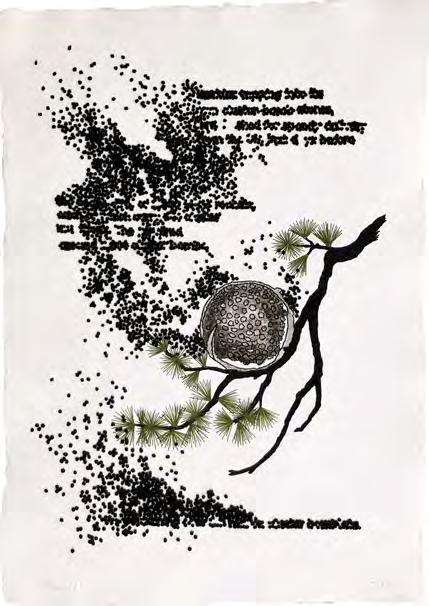
This year marks MENART Fair’s official inclusion in Paris Art Week. How does this shift your vision for the fair, both in terms of visibility and responsibility within the European art scene?
Joining Paris Art Week is a significant milestone that brings greater visibility and responsibility. It challenges us to raise our standards and amplify MENA artists’ voices on one of the world’s biggest art stages. This inclusion reinforces our commitment to cultural exchange and diversity, while inviting a broader European audience to engage deeply with the richness of the region’s contemporary art.
Looking ahead, what kind of legacy do you hope MENART Fair leaves in the art world—and in the broader cultural imagination of the MENA region?
I hope that MENART Fair leaves a legacy of visibility, respect, and connection. More than a marketing event, it should be remembered as a platform that changed perceptions—showing MENA art as vital, diverse, and contemporary. Ultimately, I want it to inspire ongoing dialogue, cultural pride, and lasting bridges between the region and the wider world.
And finally, how do you personally stay inspired? What keeps you coming back, year after year, to champion this corner of the art world with such clarity and care?
I stay inspired by the artists themselves—their courage, creativity, and resilience. Each year, I’m moved by new stories and fresh perspectives that challenge and enrich my understanding. Championing MENA art feels like a meaningful mission, a way to amplify voices too often unheard. That sense of purpose and connection keeps me coming back, with passion and care. ■
words NADINE KAHIL

History, innovation, and memory converge in the city’s most iconic spaces.
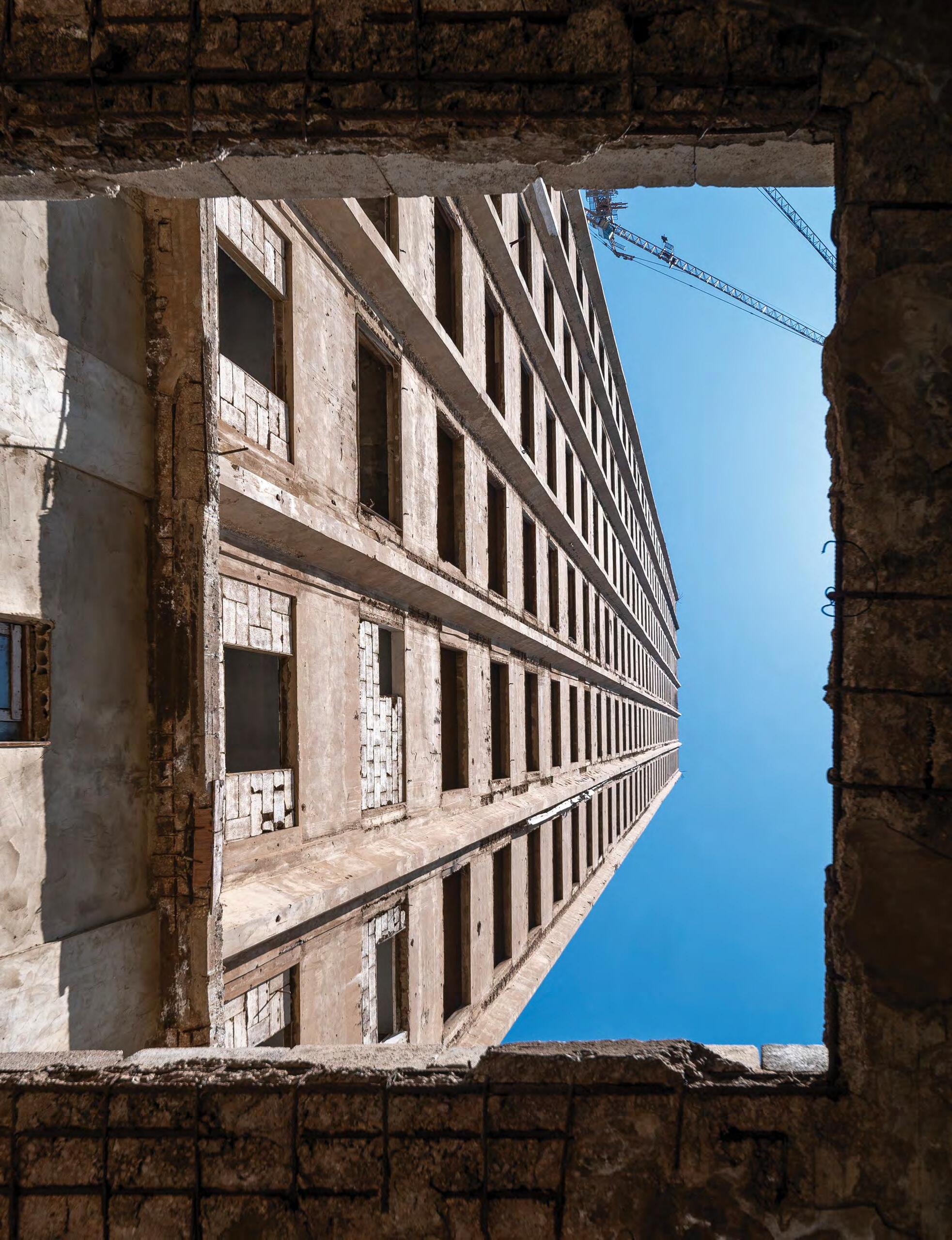
Beirut has long been a city where history and innovation coexist, often in tension, sometimes in harmony. This October, that delicate balance takes centre stage as We Design Beirut returns for its second edition. For five days, the city’s historic landmarks, from the Roman Baths to the modernist Immeuble de l’Union, will transform into stages for design, craft, and dialogue.
More than an exhibition, We Design Beirut is a statement. Anchored in the pillars of empowerment, preservation, and sustainability, the event creates space for designers, artisans, students, and educators to collaborate and exchange ideas. This year’s theme, legacy, revival, and continuity, feels especially poignant in a country where the threads of cultural memory are constantly tested yet never severed.
The program spans six exhibitions across seven locations: At the Abroyan Factory, Threads of Life and Métiers d’Art celebrates the endurance of textile arts and craftsmanship, pairing artisans with contemporary designers to push the limits of technique and form. At Burj El Murr, an unfinished war-era skyscraper turned cultural site, the Design in Conflict student exhibition examines how architecture and space are shaped by conflict. Curated by Archifeed founders Teymour Khoury and Yasmina Mahmoud, in collaboration with Tarek Mahmoud and Youssef Bassil, it gathers projects from nine Lebanese universities into a charged conversation about design’s role in fractured landscapes.
Gregory Gatserelia curates Totems of the Present and the Absent at Villa Audi, a tribute to SMO Gallery’s impact on Lebanese design. At the Roman Baths, Of Water and Stone, curated by Nour Osseiran, and produced by Stones by Rania Malli, reinterprets rituals of cleansing and gathering through marble installations. Immeuble de l’Union, a modernist landmark in Sanayeh, reopens after renovation by architect Karim Nader with a retrospective exhibition, Union: A Journey Through Architecture and Light. Meanwhile, a new Emerging Designer Exhibition, Rising with Purpose, highlights talent under 30.
This year, We Design Beirut expands its reach with tours of Oscar Niemeyer’s Tripoli International Fair and the Saloua Raouda Choucair Foundation, ensuring that the narrative of revival extends beyond the capital.
If legacy is the keyword, then the most compelling stories are those of a new generation of creatives carrying forward their family traditions while making space for their own voices. Three such figures, Teymour Khoury, son of architect Bernard Khoury; Tarek Mahmoud, son of architect Galal Mahmoud; and Emma Jabr, daughter of ceramist Zein Daouk Jabr, embody that intergenerational dialogue.





Teymour Khoury is the co-curator of Design in Conflict at Burj El Murr. While his family name is synonymous with prominent architects, his path was not predetermined. “Design was never really part of my everyday life, at least not in the way people imagine when they hear ‘architect’s child,’” he recalls. “I never sought to fully understand my father’s work until I grew more mature and began to grasp its political dimension, politics being, and remaining, my primary intellectual focus.”
His formal education began at the American University of Beirut, where he studied Political Science and Public Administration. The shift to design came later, “These foundational years created a need to translate theoretical knowledge into more tangible outcomes, which led me to consider architecture and curatorial practices as potential mediums for that articulation,” he says.
His first project, co-curated with his father, was All Things Mustn’t Pass, an exhibition for We Design Beirut 2024 exploring the work of his grandfather, architect Khalil Khoury. “This was perhaps the first project that drew me into curation as a primary medium of expression, helping me understand its relevance from historical, political, cultural, and social perspectives.”
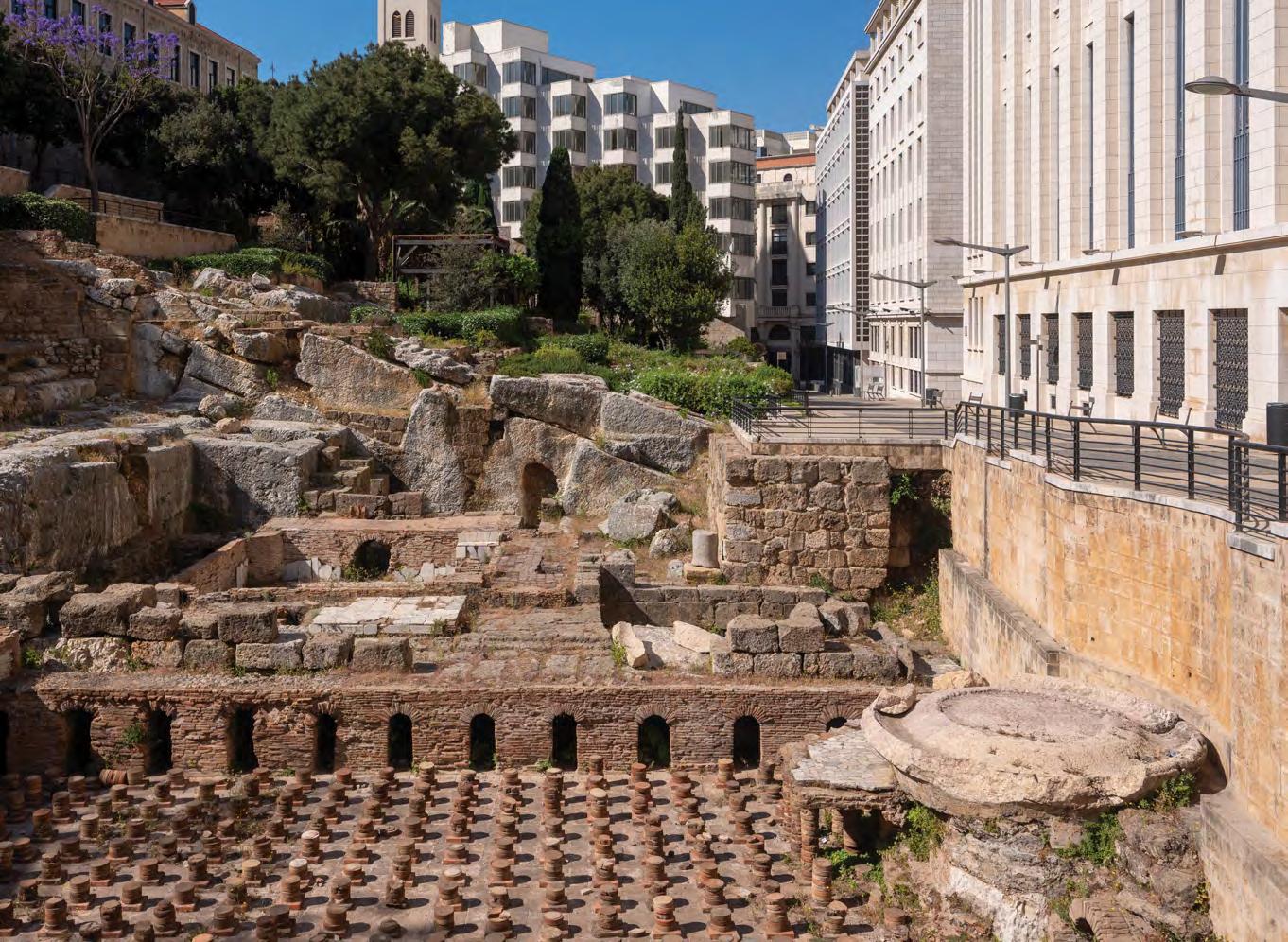
Design in Conflict, an exhibition gathering student work from nine Lebanese universities, will be staged inside Burj El Murr and promises a unique experience. Through Design in Conflict, Khoury hopes to create a space for young voices to respond to Lebanon’s turbulent history. “This will be the largest student architectural and design exhibition to ever take place in a country marked by so many crises, within such an unstable and complex urban environment,” he notes. “It is among the first opportunities to truly use architectural and design tools and methods to map recent political and urban events.”
When reflecting on how his generation interprets architecture, Khoury resists easy definitions. “We live in a period of extreme speed, commodification, and intellectual simplification,” he says. “I still like to believe there is space for deeper reflection, one where
architectural works and processes can be properly read, analyzed, and deconstructed without succumbing to simplistic definitions.”
Tarek Mahmoud’s family name is deeply established in Lebanon’s architectural world, but his own path was not straightforward. “I formed an interest in the design sector quite late, during the third year of biomedical engineering studies,” he admits. It was an internship at a French automotive design studio that first gave him practical insight into design’s meaning and value. “I was particularly impressed by the breadth of activities involved, the obsessive attention to minute details and, more importantly, what my engineer-

ing mind initially saw as arbitrary decision-making, but later understood to be a deeper emotional logic. I felt drawn to all of it.”
By 2021, he moved to Italy to pursue a Master’s in design, later joining a consultancy in Milan. This shift allowed him to combine his engineering background with a design philosophy grounded in problem-solving. “I view projects as problem-solving tasks that need to be broken down into smaller pieces. For me, design is about finding appropriate solutions to those pieces and reassembling them into a whole that is both coherent and meaningful,” he says.
Carrying the Mahmoud name, he is often asked about legacy. For him, it is a resource, not a burden. “I guess I am lucky seeing as I operate on a different scale and in different fields than my father
typically does. His legacy isn’t much of a weight I must carry but a source of inspiration I can draw from when circumstances allow or require it,” he says.
At We Design Beirut 2025, Mahmoud returns to a subject he explored in his Master’s thesis: the relationship between conflict and design. What makes the exhibition powerful is its context. Burj El Murr, unfinished since the civil war, has long stood as a scar in Beirut’s skyline. Staging a student exhibition there creates both a symbolic and physical confrontation with history. “This exhibition will present a hyperlocal perspective on conflict, one formed by the accumulation of violent events that, for over a century, have produced a permanent state of latency in which Lebanese people are perpetually dragged in and out of war,” Mahmoud says.
“We Design Beirut expands its reach with tours of Oscar Niemeyer’s Tripoli International Fair and the Saloua Raouda Choucair Foundation, ensuring that the narrative of revival extends beyond the capital.”



He hopes audiences will leave with a renewed understanding of design’s social dimension. “I aim to present a more rational dimension of design, one that remains deeply concerned with human needs. Contemporary international design events often focus on simplified artistic gestures, completely overlooking the broader value and impact that the design discipline can offer. In contrast, Design in Conflict looks to foster dialogues on its more pragmatic role.”
Despite his growing involvement in architectural discourse, Mahmoud envisions his own career evolving in other directions. “I enjoy designing objects with embedded technologies, and this is the path I’ve chosen to dedicate myself to. I am quite excited about the idea of designing objects for outer space.”
A Showcase Rooted in Resilience
Villa Audi was the site of Totems of the Present and the Absent, an exhibition curated by Gregory Gatserelia. Among the contributors is Emma Jabr, an emerging architect and designer making her debut with a deeply personal work. The daughter of ceramist Zein Daouk Jabr, she grew up surrounded by the rhythms of making. “My mother taught me to train my eye, to expose myself to design and aesthetics until it became second nature,” she recalls.
Jabr’s participation at We Design Beirut 2025 came through the event’s open call. “The theme at Villa Audi resonated with me, and when the chance arose to join, I felt it was the perfect place for my first showcase in the city that raised me,” she says. “We Design is more than an event, it is a platform that celebrates and amplifies Lebanese creativity, and being part of it feels truly special.” The exhibition gathers a range of designers exploring what it means to create totems in contemporary Lebanon, objects that hold both personal and collective meaning. For Jabr, the opportunity to situate her work within such a conversation is as much about belonging
as it is about standing out. “Some might find it daunting, but as a young designer I found it inspiring to exhibit alongside such great talents. What’s beautiful about We Design is that every piece, no matter how different, comes together to tell a larger story.”
Jabr’s piece, Bar Platine, is both a functional object and a symbolic gesture. “My totem, Bar Platine, is rooted in resilience,” she explains. “It honours the bon viveur spirit, our instinct as Lebanese people to choose joy and gather despite hardship. With its rotating shelves and layered form, it reflects Beirut itself: always in motion, always rebuilding. For me, it’s both a functional bar and a symbolic totem of strength, survival, and togetherness.”
That duality, the everyday and the symbolic, reflects her outlook as a young designer. To her, design is not about chasing trends or making a name in isolation, but about engaging with shared narratives.
Jabr is candid about the role her mentors and family have played in shaping her identity. “The way I design and think is very much a product of my mentors and family’s artistic heritage, and I feel fortunate to be surrounded by so many creatives,” she says. “We each have our own avenues of expression, but we also feed off each other, support one another, and exchange ideas openly.”
For now, Jabr is focused on making the most of her first public showcase. More than a career milestone, it is a chance to connect with her city. “On one hand, I hope the exhibition will open doors to future collaborations and opportunities, but on a more personal level, it’s about engagement,” she says. “If people walk away feeling inspired or moved, then I feel I’ve achieved something meaningful.” In a year when We Design Beirut is foregrounding legacy, continuity, and revival, Jabr’s work stands as a testament to the resilience of a new generation. ■
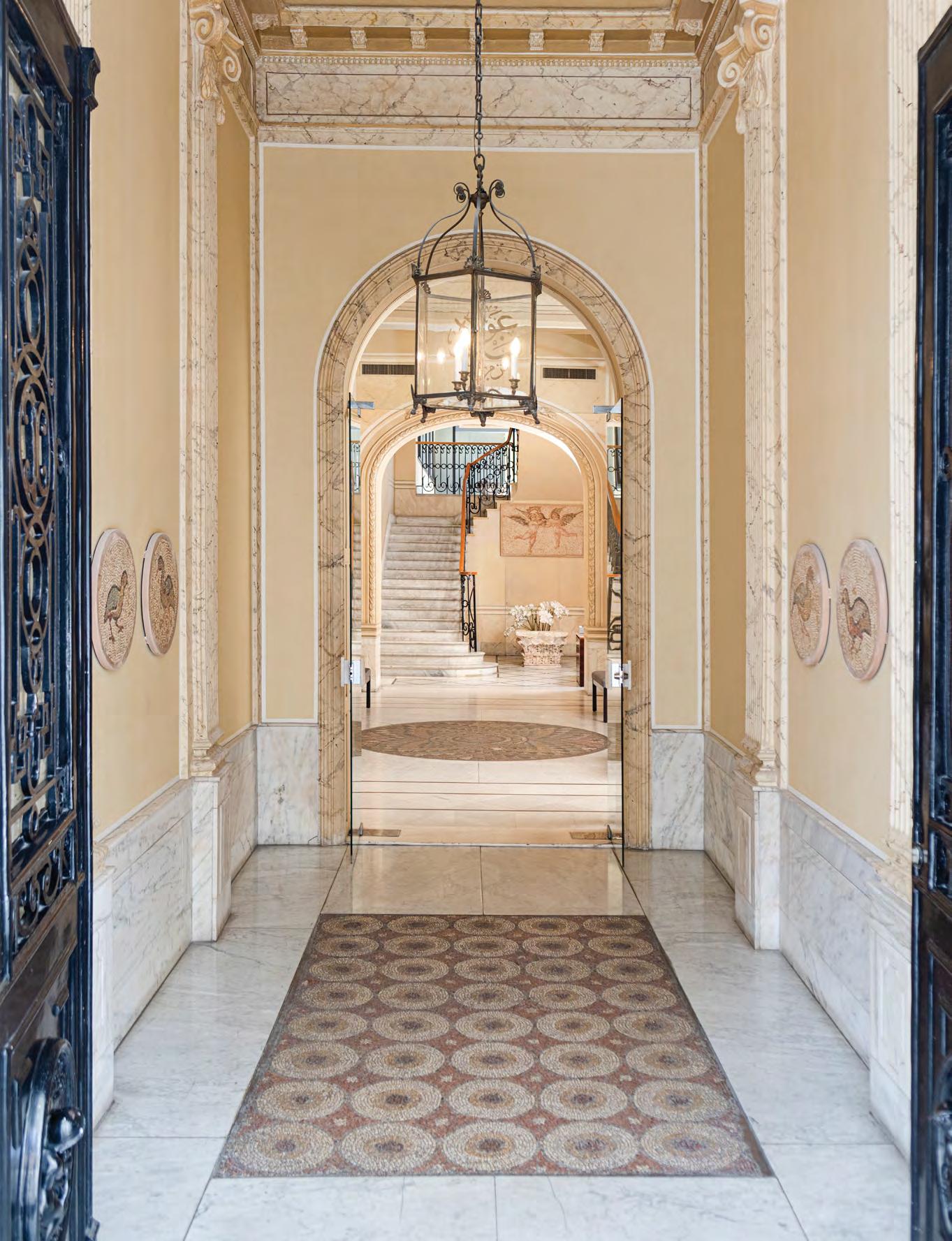

A meditation on music, meaning, and the algorithmic age.

We live in the age of infinite playlists. Music has become simultaneously more accessible and more distant. We can summon nearly any song with a tap. Yet, somehow, many of us feel strangely adrift in a sea of sound.
In this dawning era, sometimes heralded as the Age of Aquarius, a time marked by revolution and idealism, technology has shattered old barriers even as the emotional weight of music seems to wane. Digital streaming platforms (DSPs) promised a utopia of discovery and democratized access: an endless library at our fingertips. But something precious seems to have slipped away.
Despite offering unprecedented reach, the streaming economy has become a kind of Leviathan, a monstrous system that swallows most of the value. Everyone who works in the industry knows the uncomfortable truth: music itself is not what makes money anymore. Under the hood of Spotify, Apple Music and their kin lies a tiny perstream pay out (on average just about $0.003–$0.005). In other words, a million streams, the kind of number fans naively assume means riches, yields only a few thousand dollars, before managers, labels and distributors take their cut. Even if you did “go viral”, the math hardly pays rent. For independent artists, life on per-play pennies is unsustainable.
DSPs have had a tight grip on music. Algorithms dictate what gets heard, who gets playlisted, and ultimately, who survives. In the process of working on this story, I saw that chokehold for myself. I struggled to even get people to talk to me. Many declined interviews, others backed out, some ghosted. The silence itself felt like confirmation that there’s something here, something people don’t want to say out loud.
Meanwhile, the gatekeepers have simply shifted from radio DJs to data. Today’s playlists (RapCaviar, New Music Friday, algorithmic “Discover” feeds) wield enormous power over who gets heard. Landing on a major playlist can make or break a career and missing out often means obscurity. Every artist, major and indie alike, has little choice but to play by the platforms’ rules. The alternative is irrel evance. No one is immune. That might explain the silence I encountered while reporting this piece.
In effect, we’ve built a new pyramid. A handful of me ga-hits and stars earn the lion’s share, while everything else trickles up to the top. As the streaming giants ad just their rules, the middle class of music is squeezed even thinner. For example, Spotify’s recent change in 2024 means no track will earn royalties unless it hits 1,000 streams per year. This 1,000 is being sold as a way to aggregate millions of tiny pay outs and funnel them to busier artists, but in practice it flat-lines the income for the bottom 0.5% of streams. In practice it formal
izes an “underclass” of music subsidizing the hits, at the expense of emerging artists.
Global streaming revenues are indeed growing and paid subscriptions now exceed 750 million worldwide. But that growth has gone overwhelmingly to shareholders and a few giants. Streaming now accounts for about 69% of all recorded music income, yet ordinary artists see almost none of the windfall. For instance, the Middle East and North Africa (MENA) region was one of the fastest-growing markets (+22.8% in 2024,) but that prosperity flows into the same global pools and corporate profits. Local indie musicians feel little benefit. In short, the digital revolution solved piracy and created a vast audience, but it also centralized power in opaque corporate vaults. The platforms may have democratized access, but they have squeezed value.
The system now encourages efficiency at the expense of artistry. Features are designed with cash-grabs in mind: albums are padded with filler tracks to inflate stream counts. Apple even gives a ~10% bonus royalty for any song with a Spatial Audio version, a perk only labels with big catalogues can really exploit. Artists and labels have quietly gone along, rarely pushing back.

Even global corporations test the limits of this delicate balance. In early 2024, Universal Music Group pulled its entire catalogue from TikTok amid a bitter licensing standoff over pay and AI concerns, stranding many artists on that discovery platform for months. The episode was a reminder that the streaming status quo can be upended on a whim by a few big play-
In many ways, streaming has simply recast old problems in a new language. One might call it payola 2.0: instead of cash under the table, artists or labels agree to cut their own royalties by 30% in exchange for algorithmic favour (Spotify’s “Discovery Mode”). Though framed as a promotional discount, it has much the same effect: those who can pay in streams get boosted, those who can’t fall further behind. This is not mere conjecture. A UK parliamentary report specifically warned that algorithmic recommendation engines can “homogenise taste and disempower self-releasing artists.” In other words, the very technologies that promise endless choice may
Perhaps more insidiously, the streaming model has subtly rewired how music itself is made. With a 30-second listen now counting as a full “play”, artists have been tempted to front-load every track. Veteran music journalist Alan Cross puts it bluntly: Spotify’s rules “have subverted and changed song writing and production.” Hooks arrive almost immediately, intros vanish, and songs race to that 30-second mark to snag a pay out. As Cross observes, we now get “shorter intros… multiple sugar-high hooks… before the song is half a minute old,” all in service of the algorithm. Meanwhile, the playlist on shuffle does not tolerate discord or darkness. One jarring chord or slow bridge is often enough for a listener to hit skip.
The net result is a dumbing down of variety and depth. If a listener grows bored, the next track is always one tap away. In this sense streaming has turned music into a consumer activity, trained by mood tags and automatic playlists. We have drifted from the tactile joy of hunting down an album or building a personal mixtape.
Gone are the days of sitting with headphones or a vinyl record, intentionally listening from start to finish. Instead, the user experience now resembles a continuous mood playlist. Music is shuffled through the background of our lives, seldom commanding our full attention.
Artists who might invest in long, experimental tracks find little incentive to do so when a series of 15-second hymns can earn the same pay out. We are at risk of a cultural shift where attention and novelty trump experimentation and story. The long album as a journey is giving way to a hit-single as instant gratification.
Ma3azef journalist Omar Ghoneim captures it sharply: DSPs have “turned music listening into more of a consumer activity rather than an intentional act of listening and taste-making.” The sheer algorithmic saturation, he says, makes streaming “a horrible experience” compared to the tactile eras of cassette tapes, vinyl, or even personal iPods. Musicians have noticed. Rather than conceiving albums as narratives, many now engineer tracks to beat the machine. Ghoneim observes young artists purpose-build songs “for the algorithm, tracks with a 20-second hook but lacking any real substance, made solely to be favoured by the algorithm.” In other words, the first 10 seconds must be pure elevator-music-level immediate, and lyrics may consist of search-friendly vibe-tags instead of poetry. It’s not that great art has vanished, but the pathway to intimacy is now cluttered by metric-chasing.
This shift creates artistic pressure: write “playlist-safe,” quantifiable songs. Fans once lived inside an album; now they only briefly flirt with it. As singer Rita Loujdia notes, the industry has become “so number-obsessed” that even big streams feel empty if they don’t spawn real fans. She points out a harsh truth: “Fans still don’t fathom that you cannot make a living off streaming.” The glossy view that YouTube views or Spotify plays equal income is a myth. Loujdia laughs that we ought to refuse the narrative: millions of streams spread across labels “doesn’t equal a month’s rent, it shouldn’t be acceptable!” We’ve fed the beast with our attention, but as she puts it, there’s now a monumental productivity demand on artists, often juggling side-jobs, to keep churning out disposable singles. When those raw numbers surge yet lead to no new supporters, it is “even more painful,” she says. In streaming’s calculus, a million plays can feel meaningless.
Ghoneim agrees that the solution isn’t just in artists’ hands. He argues that listener action is the missing ingredient. While many artists publicly push back, he believes only collective fan pressure will move the needle. “Consumer action would hurt these giant companies a lot more,” he says, urging listeners to demand a fairer system. For him, that means platforms that empower fans to choose rather than be spoon-fed. He hopes for a streaming world where people can “acquire taste and curate their own music” again, perhaps even abolishing opaque editorial playlists. Interestingly, he concedes DSPs have helped some independents find exposure (especially in global markets), but that’s “the exception rather than the rule.” Overall, Ghoneim’s take is a call to arms for listeners: don’t passively accept the conveyor belt. We need collective re-tuning of the system by those using it.
There are more voices out there calling for pushback. Some experts urge platforms to consider a user-centric payment model, where each subscriber’s fee is divided only among the artists that listener actually plays. In theory, this would better reward niche fans and indie acts. Indeed, rivals like Deezer and SoundCloud have begun piloting such models. Others highlight that companies like Bandcamp operate on entirely different principles: artists there receive an average of 82% of each sale and fans have directly paid $1.56 billion to creators so far. It is a powerful proof-of-concept that fans will support artists if given the means to connect beyond the algorithm. Such models recapture the old-school intimacy of buying a record or concert ticket: you know the artist hears about your support. Creators are also eyeing traditional licensing and sync deals. In the US last year, music publishing (songwriter income from ads, TV, games, et cetera) jumped 13.4% to $7 billion, outpacing recorded music growth as more catalogues get pitched into film and ad campaigns. Compositions and sync placements turn out to be far more stable long-term revenue than a million tiny plays that barely pay a dollar.

We should step back and ask a deeper question: what is music for? If not purely an economic commodity, music is first and foremost a human expression, a way to heal, to protest, to commune. One could say that the very Age of Aquarius spirit is stirring within artists and listeners, demanding we reclaim this. The crumbling of old systems (industries, institutions, even cultural norms) presents a chance for renewal. Perhaps music, which once served as a sacred bridge between people, can find its way back to that transcendence.
Imagine if streaming platforms became mere pipelines of discovery, rather than the sole economy. The ideal would be to blend the convenience of streaming with the ethos of the old music era, where fans directly supported artists with their wallets and attention. In practice, this means treating Spotify and Apple as amplifiers for exposure, but not depending on them to pay the bills. Instead of banking on endless streams, artists could focus more on high-touch relationships: mailing lists, fan communities, and exclusive releases. It means writing music for love and meaning first, and trusting that genuine fans will follow, rather than writing for clicks. In this future vision, every concert ticket or vinyl sale is a human handshake of support, and each song is a message rather than a metric.
We don’t have to imagine this new world as impossible. Artists and fans are already feeling the pull towards it. Some musicians are de-emphasizing singles and trends in favour of crafting albums and narratives. Others are treating streaming numbers as a marketing funnel, a way to let new listeners discover the music, but then directing those listeners to deeper engagement (live shows, merch, fan clubs). In many ways, this struggle echoes age-old cycles: every time a new technology shakes things up, there are always inventive responses. The backlash to MTV, the rise of indie record stores, even the cassette mixtape, each was a reaction to a “too big to fail” distribution model. Now the revolution may be digital again, but its cure is as human as ever.
We should continue promoting regional or community-focused platforms that circulate money locally. In parts of Africa and Asia, new services (like MTN Music+ or Resso) use small bundles and community curation to reach audiences that big DSPs miss. In the Middle East, startups (Anghami, et cetera) tailor to local languages and payment habits. Even small moves, like strengthening local radio stations’ role or encouraging multi-artist events, can keep more revenue within a scene. By rooting music in its local community, fans and artists co-create a richer culture that resists being siphoned off by distant algorithms.
Lastly, listeners themselves have a powerful role. Instead of passively accepting algorithmic recommendations, fans can be intentional taste-makers. Curate your own playlists, share music with friends, and engage with artists on social media. Attend live shows, buy albums, join fan forums. Demand transparency and fairness from platforms. True appreciation comes from active engagement. By choosing to listen attentively, giving feedback to artists, and voting with our wallets (favouring fair-pay services when possible), fans can help realign the system.
Maybe there is a hybrid future in sight. Streaming remains our window to the world, but it no longer consumes all the value. We layer on a return to older virtues, direct connection, community support, artistic intention, to reclaim what was lost. In this vision, Spotify or YouTube is just one stage in a larger ecosystem, not the whole concert hall.
The path ahead will not be easy or immediate. Big tech and big labels are entrenched, and changing global habits takes time. But shifts are already underway: artists are waking up from the trance of chasing streams, and fans are remembering the joy of real discovery. The Age of Aquarius prophesied an era of enlightenment and collective empathy, perhaps music can lead the way by reminding us of our shared humanity.
We may never fully return to the vinyl-store era of yore, and some changes (like the dominance of algorithms) are here to stay. Yet as Loujdia puts it, we might still blend “the convenience of streaming” with “the financial ethic of physical music.” The future requires a collective wake-up: artists speaking openly, fans listening intentionally, and society valuing music not just as data, but as a shared experience. If we achieve that, the streaming paradox will be resolved not by tearing down technology, but by re-centreing meaning and humanity at the heart of music once again. ■
Bold lips, radiant skin, unforgettable autumn statements!
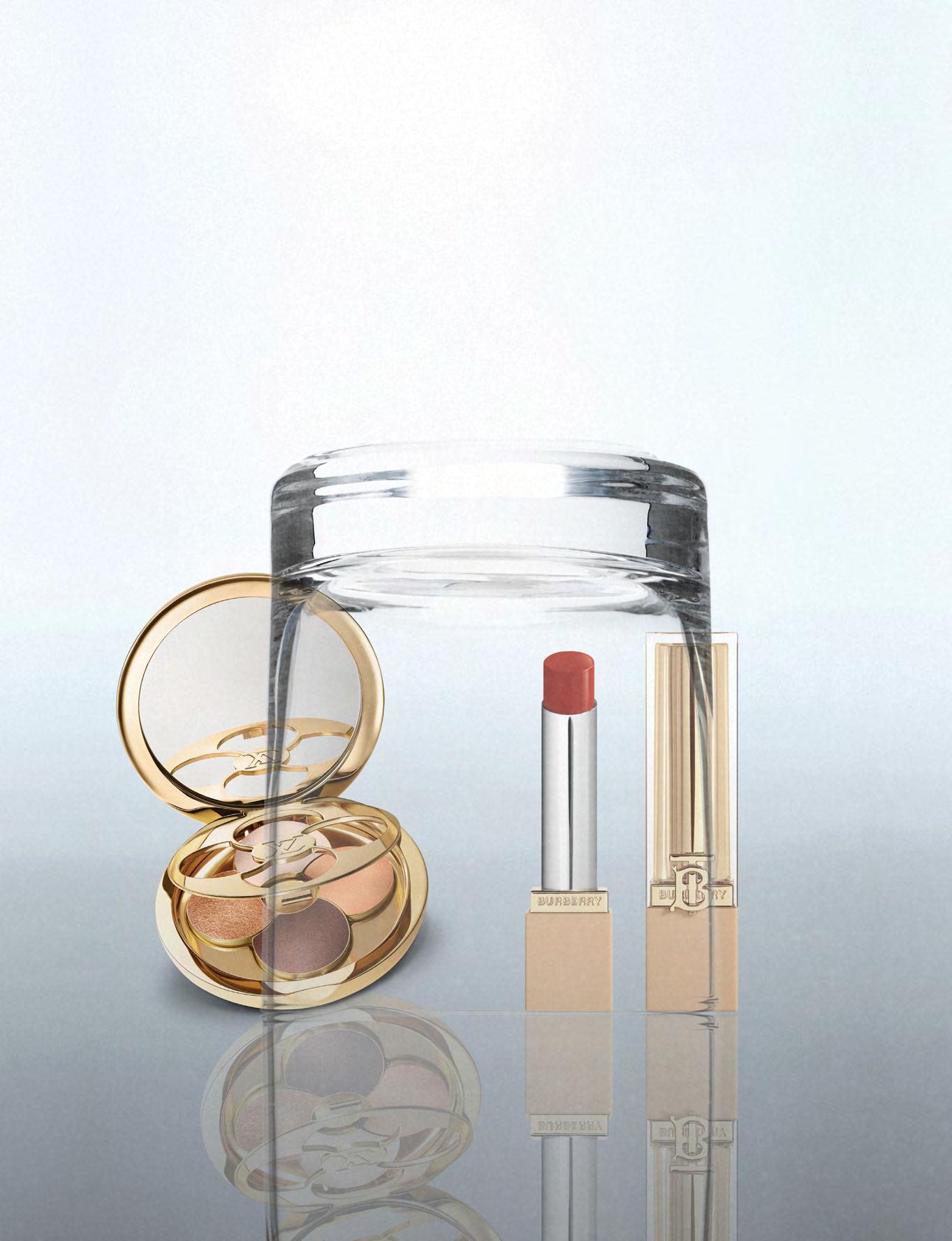
graphics
MAYA MAGED
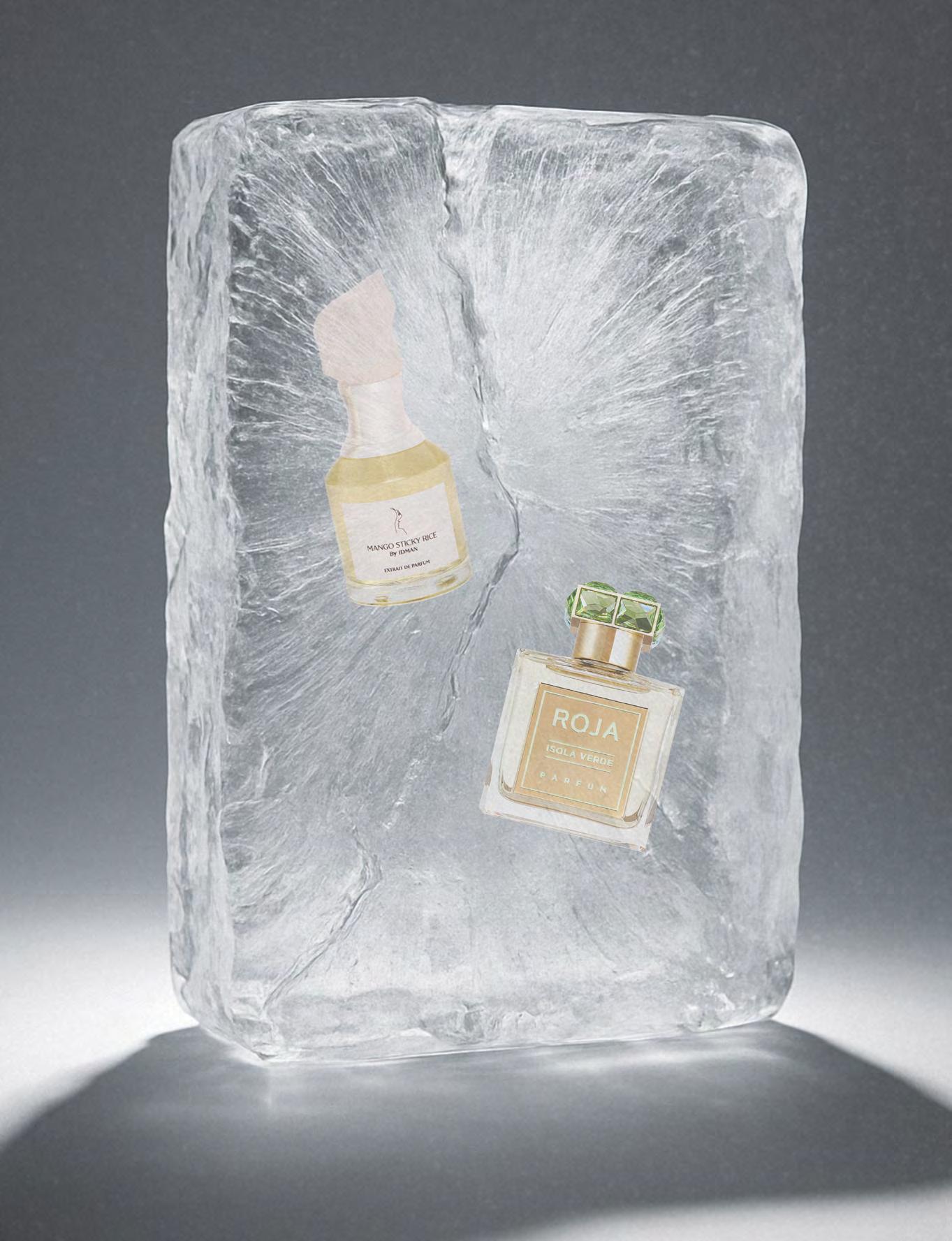






Bottega Veneta steps deeper into the world of perfumery with the launch of its new “Mezzanotte” fragrance collection, a trio of perfumes that explore the emotional and sensory terrain of midnight, its mysteries, and its quiet intensity. Following the debut of the house’s inaugural fragrance collection last October, “Mezzanotte” extends this olfactory journey with scents that draw on precious woods, rare ingredients, and the timeless artistry of Venetian craft.
The name “Mezzanotte,” meaning “midnight” in Italian, signals the direction of this collection: dark, enveloping, and intimately textured. Midnight is not only a moment in time but also a state of being, a threshold between endings and beginnings, stillness and transformation. In this spirit, Bottega Veneta has crafted perfumes that encourage pause, renewal, celebration, and awareness, translating the atmosphere of the night into three distinct fragrance expressions.
At the heart of the collection lies the idea of an olfactory Intrecciato, a continuation of the house’s signature weaving motif. Just as strips of leather are woven together to form Bottega Veneta’s iconic patterns, global essences are intertwined here to create fragrances that feel layered, tactile, and alive.
The first of the trio, “Hinoki,” takes inspiration from Japan’s revered hinoki wood, long used in sacred architecture. Combined with fir balsam and sensual patchouli, the fragrance conjures the sensation of walking through an ancient forest where light filters softly through branches and silence reigns. Both grounding and uplifting, it offers a meditative moment of balance, a fragrance for those seeking harmony amid the turbulence of everyday life.
By contrast, “Goodmorning Midnight” carries the spark of festivity. Playful and radiant, it is built on the refined depth of Thai oud and the lushness of rose, but with an unexpected twist: the sweetness of wild strawberry. The result is a perfume that feels celebratory, a toast to oneself, or to life’s shared moments. Its spirit is open, generous, and alive with possibility, the olfactory equivalent of laughter at a midnight gathering.
Finally, “Almost Dawn” turns toward the first light of morning. Deep chestnut, precious truffle, and sweet vanilla combine to form a fragrance that is both intimate and expansive, dark yet filled with optimism. It embodies transition, from night into day, from contemplation into action. “Almost Dawn” invites the wearer to embrace new beginnings, to see the beauty in thresholds and transformations.
The design of the bottles reinforces the narrative. The perfumes are housed in organically shaped glass vessels, each topped with a uniquely coloured wooden cap and placed on a cylindrical base of black Marquina marble. The design is rooted in Venice, the city that defines Bottega Veneta’s spirit. The volute-like shape of the glass recalls Murano’s centuries-long tradition of glassblowing, with a surface that replicates the effect of mouth-blown glass. The marble base echoes the walls and facades of Venetian churches and palazzi, grounding the perfumes in a sense of history, permanence, and place.
Together, the three perfumes form more than a collection, they create a dialogue about time, memory, and craft. Midnight becomes a lens through which Bottega Veneta explores contrasts: light and shadow, solitude and celebration, intimacy and expansiveness. With “Mezzanotte,” the house reaffirms its approach to fragrance not as an accessory, but as an extension of its design philosophy, an art form where materials, tradition, and modernity are woven together into something enduring.
As with its fashion and leather goods, Bottega Veneta’s fragrances resist excess, choosing instead to highlight craftsmanship, materiality, and quiet power. The “Mezzanotte” collection is no exception: three singular scents that invite their wearers into the subtle, complex world of midnight. ■
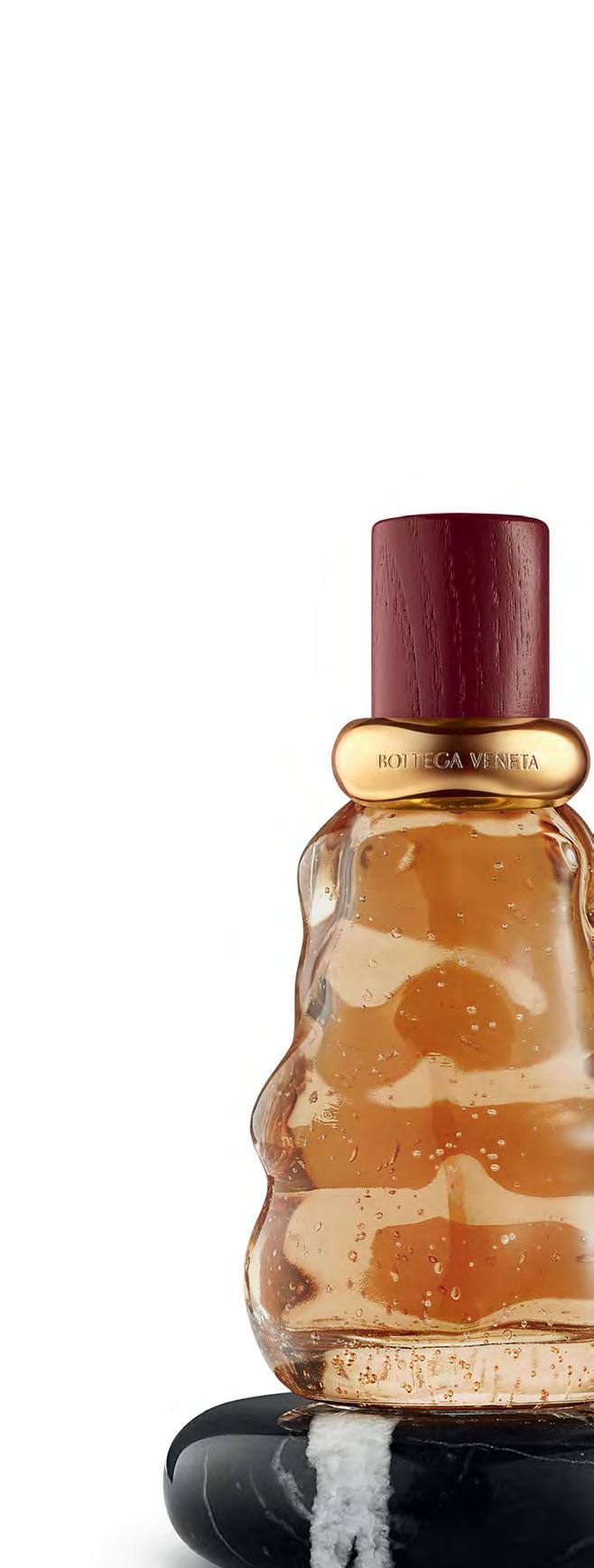
Bvlgari offered up two new Octo Finissimos and embraced “living metal” at Geneva Watch Days 2025.


Across a decade of radical engineering, Bvlgari’s Octo Finissimo has rewritten the rules of ultra-thin watchmaking, not as a parlour trick, but as a language of modern elegance. Ten world records in eleven years speak to the wonders of Italian design distilled into pure geometry and Swiss precision, expressed through metals, minerals and concepts you don’t usually see on a wrist. At Geneva Watch Days 2025, Bvlgari staged its first full retrospective of the Finissimo saga and unveiled fresh chapters, in the form of an artist collaboration and a marble-dial tourbillon alongside a new “living metal” addition to the Bvlgari Aluminium line, all of which sharpen edge for a new generation.

Watch Business Unit Managing Director Jonathan Brinbaum carries a clear credo from years working in beauty and fragrance: eeling first. “One of my strong beliefs is that we need to put emotion into watchmaking,” he says. “When you buy a 50K, 100K watch, yes, you will be convinced by the technicity… but at the end, what makes you move forward with the purchase is the emotion you carry when you hold it,” he says. The ultimate source of that emotion? “Everything that we’re doing is born in Rome… Rome is an endless source of inspiration.”
That framing is why Bvlgari’s Geneva Watch Days presence leant educational as much as it did new metal. The brand conceived “the retrospective as almost a museum visit… a moment of sharing… explaining the saga” in an event Brinbaum calls “independent, client-focused… a qualitative moment of talking between passionate people about watches.”
The perfect example of this passion is the Lee Ufan x Bvlgari collaboration. Inspired by static rock and limitless possibilities of a mirror, the piece is an Octo Finissimo with a mirroring dial in a hand-finished, etched titanium case and bracelet, limited to 150 pieces and powered by the BVL 138 micro-rotor, and of course, with an overall height of just 5.5 mm. The stunning piece was challenging to say the least, “Trying to find the right techniques to pay justice to the thinking of Fabrizio [Fabrizio Buonamassa Stigliani, Creative Director and Designer for Bvlgari Watches] and Ufan… the audio treatment, the manual abrasion of the bracelet. Because at the end, no compromise could be made on the thinking of the artists.” The end result, the gorgeous, scratched bracelet is almost, dare we say it, brutal?
Few materials are as Roman, or as unruly, as marble. Bvlgari’s Octo Finissimo Tourbillon Marble sets a deep-blue Italian marble dial into a 40 mm platinum case just 4.85 mm thick, driven by the handwound BVL 268 (1.95 mm; 52-hour reserve). Limited to 30 pieces, it pairs jewellery-grade aesthetics with microscopic tolerances.
Brinbaum doesn’t sugar-coat the challenge: “The marble is a very difficult material to work on.” Not only that, each piece had to be carefully selected, each is unique, each is differ ent, “because it’s of course the choice of the stone, but then it’s also how you’re going to work on it to integrate it in the dial,” he says. The challenges might have been extreme, but the end result is remarkable.
The final of the three new offerings sees the Bvlgari Al uminium story embrace bronze for the first time in the Bvlgari Bronzo, launched as a 40 mm GMT (calibre B192, 50-hour reserve) and a 41 mm chronograph (calibre B381, 42-hour). This is all about bronze’s natural aging, and patinas, a surface that evolves with you. Brinbaum is direct: “It’s a living material, and what I truly believe is each piece is going to become unique for the client that is going to wear it.” He’s equally frank about educating buyers: “Yes, you may have signs of oxidation on your skin… a bit of patina that’s going to appear on the watch… that’s part of the DNA… which then creates your own watch that is going to react to your own skin,” he says with obvious enthusiasm of the piece that’s perhaps the best example of a collector’s watch.

The remarkable Bronzo stands apart from the Finissimo pieces, but, perhaps, is the ultimate signal for Bvlgari. It’s alive, evolving and moving forward. Each piece, Finissimo or otherwise, is a unique exploration of the owner’s tastes and desires. At the heart of all this, records, materials, or design mean little without wearability and soul. Finissimo remains a slim, architectural profile that slides under a cuff with materials chosen to amplify both function and feeling; while the Bronzo explores entirely new territory. The whole point is to evoke emotion, point to the skill and talent of the maker and showcase incredible design in a wearable timepiece. And here, Bvlgari have excelled themselves. ■
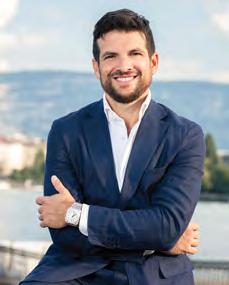
“It’s a living material, and what I truly believe is each piece is going to become unique for the client that is going to wear it.”
- Jonathan Brinbaum
From state-of-the-art fitness to restorative rituals, Montenegro’s SIRO Boka Place sets a benchmark for wellness-focused retreats.
words NADINE KAHIL
When we boarded a flight bound for Montenegro, the brief was clear: experience a new kind of hospitality where performance, recovery, and exploration converge. High above the clouds, the journey unfolded through comfort and seamless service, the kind that Turkish Airlines is known for, setting the tone for the days ahead. By the time we landed in Tivat, the Adriatic shimmered below like a sheet of glass, and the promise of SIRO Boka Place, Kerzner International’s latest wellness-forward hotel, felt almost cinematic.
SIRO, pronounced “sigh-row,” is no ordinary brand. Launched in 2024 with SIRO One Za’abeel in Dubai, it is built on five core biohacking pillars: nutrition, fitness, sleep, recovery, and mindfulness. These aren’t marketing buzzwords, they’re embedded into the architecture, programming, and the smallest touchpoints. SIRO Boka Place, the brand’s first European property, takes these principles and layers them with a distinctly Montenegrin sensibility: the call of the mountains, the pull of the Adriatic, and the slower rhythms of Porto Montenegro.
From the moment you arrive, the environment signals that you’re in for something entirely fresh. The lobby is light-filled and pared-back, the lines clean, the palette calming. Every space feels purposefully designed to reduce mental clutter. Even the rooms, whether studios, suites, or the new SIRO Apartments, extend the wellness philosophy. Temperature-regulating mattresses, blackout curtains, and a curated pillow menu aim to optimise sleep. A Swedish ladder leans against the wall for in-room workouts, while the recovery cabinet is stocked with a yoga mat, stretch bands, and a meditation cushion. It’s a subtle but effective shift: here, even your downtime becomes part of a larger performance ecosystem.
The Fitness Lab, spanning over 1,600 square metres, is the beating heart of SIRO Boka Place. This is no token hotel gym, it’s a professional-grade training facility with dedicated studios, performance zones, and a climate-controlled 25-metre pool with a retractable roof. The Experience Box hosts high-intensity interval training, boxing, and SIRO’s signature Power, Sculpt, and Booty Sessions. The Pilates Reform Studio offers precision-driven sessions, while the Mindfulness Studio becomes a quiet haven for yoga, meditation, and breathwork. The programming is elevated further by Team SIRO ambassadors, including Functional Fitness by AC Milan and boxing fitness by professional boxer Ramla Ali. It’s rare to see this calibre of expertise available to hotel guests outside of an elite sports package.
But as immersive as the indoor facilities are, SIRO Boka Place’s most unique proposition lies outdoors. Through its Destination Fitness programming, the landscapes of Montenegro become an extension of the gym. One morning might begin with a tailored hike through the wild beauty of Lovćen National Park, the next with a coastal cycle along Kotor Bay. Activities are tiered for every level, families, seasoned athletes, and absolute beginners all find their fit. There’s a sense of play in the adventure: sunscreen and electrolytes tucked into hiking packs, post-activity recovery sessions in the Lab, and coaches who push just enough to ignite, not overwhelm.
The Recovery Lab is equally ambitious, uniting scientific precision with mindful restoration. Here, compression boots, cryotherapy chambers, and red light therapy pods sit alongside Himalayan salt walls and vibroacoustic chairs. A menu of treatments covers everything from myofascial cupping and dry needling to assisted stretching and modular massages by Proverb. It’s a space that respects both the physiolog-


“Here, even your downtime performance

becomes part of a larger ecosystem.”


ical demands of training and the mental decompression needed to sustain it. The Zen Room, softly glowing from its salt wall, is an invitation to simply breathe, something that sounds simple but feels rare.
Wellness at SIRO is never only about the workout; it’s equally about what fuels it. The culinary program here is its own kind of innovation. At SIRO Table, Mediterranean flavours meet Balkan specialities, each dish crafted in collaboration between chefs and in-house nutritionists to be macro-balanced without feeling restrictive. SIRO Social, the rooftop space with a view of Kotor Bay, adds a convivial twist with low- and no-alcohol cocktails, natural wines, and healthy tapas. The Refuel Bar serves custom shakes and nutrient-dense snacks for preor post-training, while 24-hour modular dining ensures that even latenight cravings can be met in a way that supports the brand’s pillars.
Porto Montenegro itself is the perfect extension of SIRO’s ethos. The neighbourhood is alive with boutique stores, contemporary galleries, and waterfront cafés. Beach clubs hum with energy, and the marina glitters with superyachts, yet it never loses its intimacy. For guests, the balance is ideal: a morning of functional training, an afternoon of sailing or exploring local markets, a rooftop drink as the sun sinks into the bay.
Throughout our stay, what became clear is that SIRO Boka Place isn’t built only for athletes. Yes, it’s a dream for those serious about performance, but it’s equally welcoming for anyone curious about integrating more wellness into their travels. The programming adapts, whether you want to train like a pro, recover from long-haul travel, or simply explore Montenegro through a more active lens.
And the journey itself, flying with Turkish Airlines, reinforced the value of starting as you mean to go on. Comfortable seating, thoughtful service, and seamless connections through Istanbul meant we arrived already in the right headspace to engage with SIRO’s offerings. The contrast was striking: instead of stumbling into a trip needing a little recovery time, we arrived ready to train, explore, and fully immerse.
By the time we left Montenegro, the takeaway wasn’t just that SIRO is an exciting new player in the wellness travel space. It was that the concept works because it’s holistic without being prescriptive, immersive without being isolating. You’re not signing up for a retreat or a bootcamp, you’re stepping into a lifestyle model that can flex to meet you where you are, then nudge you further.
In an era where “wellness” is often reduced to a spa treatment or a smoothie, SIRO Boka Place reclaims the term. It’s about training in ways that feel inspiring, recovering in ways that feel deeply restorative, and exploring in ways that connect you to both place and self. Montenegro, with its wild beauty and slow-living charm, might just be the ideal testing ground for this evolution in hospitality.
For YUNG, the visit was a reminder that the future of travel isn’t about simply seeing a destination, it’s about living in it, moving through it, and leaving better than when you arrived. And sometimes, it starts with the right destination, and a brand unafraid to rewrite the rules.
Discover The BoTree, a London bolt-hole with Italian dining, a buzzed-about bar, and suites made for slow mornings.

London’s newest conversation piece sits exactly where three of the city’s distinct vibes collide. The BoTree lies right where Marylebone, Mayfair and Soho connect, a vibrant, high-energy base that’s more gateway than stopover. With 199 rooms including 30 suites, a destination restaurant (LAVO) serving coastal Italian cuisine, a bar with serious nightlife credentials, and event spaces from a ballroom to a screening room and more, it’s built for both the scene and the in-between. It also carries Forbes Travel Guide’s VERIFIED Responsible Hospitality Badge, signalling a commitment to the environment and to the wellbeing of its team, guests and local community.
Step inside and the concept unfolds with colour and confidence. EPR Architects set the frame; interiors by Amsterdam’s Concrete bring it to life with rich textures, natural fabrics and playful accents that mirror the character of the neighbourhoods outside. There’s a kinetic buzz in the public spaces, a sense that you’ve arrived somewhere with an orbit of its own, while the rooms shift the tempo to restorative. Think eucalyptus Tencel bedding, vegan-leather headboards, Jo Loves bath amenities, and Dyson hair tools at the ready. That 24-hour floor host? Consider them your modern-day butler, tuned to the rhythms of your stay.
The address puts you minutes from Bond Street station, with Hyde Park ambles, Royal Academy afternoons and Mayfair nights all within easy reach. But The BoTree also leans into the idea that hospitality is a culture, not just a service. The rooms and 30 suites are just right for when you want to unwind and enjoy a soft landing, many offer outdoor terraces and deep soaking tubs, while 56 interconnecting options make group trips and family escapes feel effortless. Accessibility is part of the design language, not an afterthought, with 21 accessible rooms ensuring there’s something suitable for everyone.
If London is a feast of neighbourhoods, LAVO is the hotel’s sunwashed course: coastal-Italian classics served with polish and conviviality. Long lunches segue into drinks, and late dinners carry the hum of a place that knows how to host. Steps away, The BoTree Bar raises the energy. It’s a vibrant spot that hosts all kinds of events and that’s known for creative cocktails, a calendar of regular happenings, and a kaleidoscope ceiling that’s as Instagram-ready as it is instantly iconic. Between the two, you’ve got a built-in social life before you’ve even left the building.
For moments that deserve a bit of stagecraft, the Ballroom delivers the space and the Screening Room adds cinema to the mix. The rooms are designed for connection: film nights that spill into after-parties, private celebrations that feel editorial, and events that hit the sweet spot between stylish and substantial. It all goes back to the hotel’s central idea: authentic connections, communal energy and refined comfort, expressed with personality.
Families are key to the community at BoTree. Mini bathrobes, baby baths, highchairs and toys keep younger travellers in the loop, and those interconnecting rooms turn logistics into ease. Whether you’re city-hopping with friends, staking out a creative week in the capital or landing in London before your next flight east, The BoTree reads as a modern stay for those who like their hotels with both heartbeat and craft.
In a city that thrives on reinvention, The BoTree doesn’t chase a trend so much as crystallise a feeling, of place, of possibility, of being in the right pocket of London at the right time. Step out for Marylebone calm, Mayfair polish or Soho charge; step back in for the glow-up version of home. That, ultimately, is the hotel’s quiet flex: it connects you to the city, and to your best version of it, on your terms. ■
“Step



